Billion Electric BIL-6200NXL 3.75G Wireless-N Broadband Router User Manual
Billion Electric Co., Ltd. 3.75G Wireless-N Broadband Router
User Manual

BiPAC 6200NXL
3.75G Wireless-NBroadband
Router
User Manual
Version release: 1.02h Last revised: 2010-8-3
Table of Contents
Chapter 1: Introduction....................................................................................................................... 1
Introduction to your Router ............................................................................................................. 1
Features ...................................................................................................................................... 2
Operating Environment ............................................................................................................... 5
Chapter 2: Product Overview ............................................................................................................. 6
Important note for using this router ................................................................................................. 8
Package Contents........................................................................................................................... 8
Device Description.......................................................................................................................... 9
Cabling...........................................................................................................................................11
Chapter 3: Basic Installation............................................................................................................. 12
Network Configuration .................................................................................................................. 13
Factory Default Settings................................................................................................................ 21
Information from your ISP ............................................................................................................. 22
Configuring with your Web Browser.............................................................................................. 23
Chapter 4: Basic Configuration......................................................................................................... 24
Status............................................................................................................................................ 25
Quick Start .................................................................................................................................... 26
WAN ............................................................................................................................................. 27
WLAN ........................................................................................................................................... 29
Chapter 5: Advanced Configuration.................................................................................................. 32
Status............................................................................................................................................ 33
3G Status .................................................................................................................................. 34
USB Status................................................................................................................................ 35
ARP Table................................................................................................................................. 36
DHCP Table .............................................................................................................................. 36
System Log ............................................................................................................................... 37
Firewall Log............................................................................................................................... 37
UPnP Portmap .......................................................................................................................... 38
Quick Start .................................................................................................................................... 39
Configuration................................................................................................................................. 44
LAN (Local Area Network)......................................................................................................... 44
Ethernet ................................................................................................................................. 45
IP Alias................................................................................................................................... 45
Wireless................................................................................................................................. 46
Wireless Security................................................................................................................... 48
WPS ...................................................................................................................................... 51
DHCP Server......................................................................................................................... 63
WAN (Wide Area Network)........................................................................................................ 65
WAN Interface(EWAN)........................................................................................................... 65
WAN Interface(3G) ................................................................................................................ 65
WAN Interface(Dual WAN)..................................................................................................... 66
WAN Profile ........................................................................................................................... 67
System ...................................................................................................................................... 74
Time Zone.............................................................................................................................. 74
Firmware Upgrade ................................................................................................................. 75
Backup / Restore ................................................................................................................... 76
Restart Router ....................................................................................................................... 77
User Management .................................................................................................................78
Mail Alert................................................................................................................................ 79
USB Server ............................................................................................................................... 81
User Management .................................................................................................................81
Storage .................................................................................................................................. 85
Samba Server........................................................................................................................ 88
FTP Server ............................................................................................................................ 91
Printer Server......................................................................................................................... 92
Webcam................................................................................................................................. 97
Firewall and Access Control...................................................................................................... 98
Packet Filter......................................................................................................................... 100
MAC Filter............................................................................................................................ 102
Intrusion Detection............................................................................................................... 103
Download Tool ........................................................................................................................ 107
FTP Client............................................................................................................................ 107
QoS (Quality of Service)...........................................................................................................112
Quality of Service Introduction..............................................................................................112
QoS Setup ............................................................................................................................112
Virtual Server............................................................................................................................116
Port Mapping ........................................................................................................................118
DMZ..................................................................................................................................... 120
Wake on LAN .......................................................................................................................... 122
Time Schedule ........................................................................................................................ 123
Advanced ................................................................................................................................ 124
Static Route ......................................................................................................................... 125
Static ARP............................................................................................................................ 125
Dynamic DNS ...................................................................................................................... 126
Device Management............................................................................................................ 127
IGMP ................................................................................................................................... 134
SNMP Access Control.......................................................................................................... 135
Remote Access.................................................................................................................... 137
Save Configuration to Flash .................................................................................................... 138
Restart..................................................................................................................................... 139
Logout ..................................................................................................................................... 140
Chapter 6: Troubleshooting............................................................................................................ 141
Appendix: Product Support & Contact............................................................................................ 143
1
Chapter 1: Introduction
Introduction to your Router
Thank you for purchasing the BiPAC 6200NXL Router. Your new router is an all-in-one unit that
combines a Broadband modem, Ethernet network switch and two USB ports to provide everything you
need to get the machines on your network connected to the Internet over a 3G broadband connection.
The BiPAC 6200NXL supports 3G, PPP over Ethernet, DHCP Client and Fixed IP address to establish
a connection with your ISP.
The perfect solution for connecting a small group of PCs to a high-speed broadband Internet
connection, the BiPAC 6200NXL allows multiple users to have high-speed Internet access
simultaneously.
Your new router also serves as an Internet firewall, protecting your network from access by outside
users. Not only does it provide a natural firewall function with Network Address Translation (NAT), it
also provides rich firewall features to secure your network. All incoming data packets are monitored
and filtered. You can also configure your new router to block internal users from accessing the
Internet.
The BiPAC 6200NXL provides two levels of security support. First, it masks LAN IP addresses making
them invisible to outside users on the Internet, so it is much more difficult for a hacker to target a
machine on your network. Second, it can block and redirect certain ports to limit the services that
outside users can access. To ensure that games and other Internet applications run properly, you can
open specific ports for outside users to access internal services on your network.
The Integrated DHCP (Dynamic Host Control Protocol) client and server services allow multiple users
to get IP addresses automatically when the router boots up. Simply set local machines as a DHCP
client to accept a dynamically assigned IP address from the DHCP server and reboot. Each time a
local machine is powered up; the router recognizes it and assigns an IP address to instantly connect it
to the LAN.
For advanced users, Virtual Service (port mapping) functions allow the product to provide limited
visibility to local machines with specific services for outside users. For instance, a dedicated web
server can be connected to the Internet via the router and then incoming requests for web pages that
are received by the router can be rerouted to your dedicated local web server, even though the server
now has a different IP address.

2
Virtual Server can also be used to re-task services to multiple servers. For instance, you can set the
router to allow separated FTP, Web, and Multiplayer game servers to share the same Internet-visible
IP address while still protecting the servers and LAN users from hackers.
Features
3G
3 G-based Internet connections (requires an additional 3G USB modem), with automatic fail-over to
ensure an always-on Internet connection in the event that one of your Internet services fails. The setup
of 3G is simplified by the web browser-based configuration. It is easy for you to access to the Internet
wherever a 3G connection is available, you can even share your Internet connection with others, no
matter whether you’re in a meeting, or taking a cross-country train trip.
802.11n Wireless AP with WPA Support
With integrated 802.11n Wireless Access Point in the router, the device offers a quick and easy access
among wired network, wireless network and broadband connection with single device simplicity, and
as a result, mobility to the users. In addition to 300 Mbps 802.11n data rate, it also interoperates
backward with existing 802.11g and 802.11b equipment. The Wi-Fi Protected Access (WPA) and
Wired Equivalent Privacy (WEP) supported features enhance the security level of data protection and
access control via Wireless LAN.
Fast Ethernet Switch
A 3-port 10/100Mbps fast Ethernet switch is built-in with automatic switching between MDI and MDI-X
for 10Base-T and 100Base-TX ports, with auto detection allowing you to use either straight or
cross-over Ethernet cables.
EWAN
BiPAC 6200NXL offers a WAN port to connect to Cable Modems and fibre optic lines. This alternative,
yet faster method to connect to the internet will provide users more flexibility to get online.
USB Server
BiPAC 6200NXL supports two USB 2.0 ports, Using the integrated USB 2.0 ports, the device offers
users to share a blistering wired or 3G-based wireless Internet connection over 3G networks. Printer,
Webcam and HDD can also connect to USB port, The BiPAC 6200NXL can also serve as

3
multi-function servers with its USB port to help you set up your own network. You can share the printer
in your office network, monitor your house with a Webcam and share files with your colleagues or
friends. If you need to handle office business, home security and personal entertainment, the BiPAC
6200NXL can connect with your network devices using the built-in USB port.
3G Management Center
Monitoring your 3G connection status is easy with the BiPAC 6200NXL. The unique Billion 3G
Management Center is a web-based utility tool, displaying visually its current 3G-signal status for
users to maximize their connection. Users can monitor their bandwidth with current upload and
download speed. This tool also calculates the total amount of hours or data traffic used per month,
allowing users to manage their 3G monthly subscriptions. The web-based user interface of the BiPAC
6200NXL makes it extremely easy for users to install and manage their network. Supporting DHCP
client and server, the router enables system administrators to easily integrate this router into existing
network environments and manage IP assignment without the need to reconfigure other stations.
Multi-Protocol to Establish a Connection
The router supports PPP over Ethernet, DHCP Client and Fixed IP address to establish a connection
with an ISP.
Universal Plug and Play (UPnP) and UPnP NAT Traversal
This protocol is used to enable simple and robust connectivity among stand-alone devices and PCs
from many different vendors, and it makes setting up a network simple and affordable. UPnP
architecture leverages TCP/IP and the Web to enable proximity networking in addition to control and
data transfer among networked devices. With this feature enabled, you can seamlessly connect to Net
Meeting or MSN Messenger.
Network Address Translation
Network Address Translation (NAT) allows multiple users to access outside resources such as the
Internet simultaneously with one IP address/one Internet access account. Many application layer
gateways (ALG) are supported such as web browser, ICQ, FTP, Telnet, E-mail, News, Net2phone,
Ping, NetMeeting, IP phone and others.
Firewall
NAT technology supports simple firewalls and provides options for blocking access from the Internet,
like Telnet, FTP, TFTP, WEB, SNMP and IGMP.

4
Domain Name System Relay
Domain Name System (DNS) relay provides an easy way to map a domain name with a user-friendly
name such as www.google.com with an IP address. When a local machine sets its DNS server to the
router’s IP address, every DNS conversion request packet from the PC to this router is forwarded to
the real DNS on the outside network.
Dynamic Domain Name System (DDNS)
The Dynamic DNS service allows you to alias a dynamic IP address to a static hostname. This
dynamic IP address is the WAN IP address. To use the service, you must first apply for an account
from a DDNS service such as http://www.dyndns.org/.
PPP over Ethernet (PPPoE)
The BiPAC 6200NXL provides an embedded PPPoE client function to establish a connection. You get
greater access speed without changing the operation concept, while sharing the same ISP account
and paying for one access account. No PPPoE client software is required for the local computer.
Automatic Reconnect and Disconnect Timeout (Idle Timer) functions are also provided.
Quality of Service (QoS)
QoS gives you full control over which types of outgoing data traffic should be given priority by the
router, ensuring important data like gaming packets, customer information, or management
information move through the router at lightning speed, even under heavy load. The QoS features are
configurable by Internal IP address, External IP address, protocol, and port. You can throttle the speed
at which different types of outgoing data pass through the router, to ensure P2P users don’t saturate
upload bandwidth, or office browsing doesn’t bring client web serving to a halt. In addition, or
alternatively, you can simply change the priority of different types of upload data and let the router sort
out the actual speeds.
Virtual Server
You can specify which services are visible to outside users. The router detects an incoming service
request and forwards it to the specific local computer for handling. For example, you can assign a PC
in a LAN to act as a Web server inside and expose it to the outside network. Outside users can browse
inside the web server directly while it is protected by NAT. A DMZ host setting is also provided for local
computers exposed to the outside Internet network.
Dynamic Host Configuration Protocol (DHCP) Client and Server
On a WAN site, the DHCP client obtains an IP address from the Internet Service Provider (ISP)
automatically. On a LAN site, the DHCP server allocates a range of client IP addresses, including

5
subnet masks and DNS IP addresses and distributes them to local computers. This provides an easy
way to manage the local IP network.
Rich Packet Filtering
This feature filters the packet based on IP addresses as well as Port numbers. Filtering packets to and
from the Internet provides a higher level of security control.
Web-based GUI
A web-based GUI offers easy configuration and management. It also supports remote management
capability for remote users to configure and manage this product.
Firmware Upgradeable
You can upgrade the router with the latest firmware through its web-based GUI.
Operating Environment
• Operating temperature: 00C ~ 400C
• Storage temperature: -20OC ~ 700C
• Humidity: 20 - 95% non-condensing
6
Chapter 2: Product Overview
BiPAC 6200NXL Dual-WAN 3.75G Wireless-N Broadband Router is an all-in-one network device
enabling SOHO and office users to enjoy the freedom of secure and high-speed Internet connectivity
at the home, office, or mobile. Using the integrated USB 2.0 ports, the device offers users to share a
blistering wired or 3G-based wireless Internet connection over 3G networks. The router can also
function as a printer server, Webcam server and FTP server for network device sharing. With a
supported Ethernet WAN port, the BiPAC 6200NXL can be wired to an ADSL/Cable modem. An
optional 12V car power allows you to power the device using your car's cigarette lighter for ultimate on
the road mobility. The 3G-connection statuses can be monitored at any time using Billion’s value
added application utility, the 3G Management Center.
With Billion’s BiPAC 6200NXL, you can connect a 3G / HSDPA USB modem to the built-in USB port,
enabling you to access to the Internet over a 3.5G / HSDPA, 3.75G / HSUPA, HSPA+, UMTS, EDGE,
GPRS, or GSM networks, making downstream rates of up to 14.4 Mbps*1 possible. With the
increasing popularity of the 3G standard, communication via the BiPAC 6200NXL is becoming more
convenient and widely available - allowing you to watch movies, download music on the road, or
access e-mail no matter where you are - in a meeting, or speeding across the country on a train. The
built-in auto fail-over ensures maximum connectivity and minimum interruption by quickly and
smoothly connecting to a 3G network in the event that current wired connection fails. The BiPAC
6200NXL will automatically reconnect to the wired connection when it's restored, minimizing
connection costs. These features are perfect for office situations where constant connection is
paramount.
The BiPAC 6200NXL can also serve as multi-function servers with its USB port to help you set up your
own network. You can share the printer in your office network, monitor your house with a Webcam and
share files with your colleagues or friends. If you need to handle office business, home security and
personal entertainment, the BiPAC 6200NXL can connect with your network devices using the built-in
USB port.
With an integrated 802.11n Wireless Access Point, the router delivers up to 6 times the speeds and 3
times the wireless coverage of a 802.11b/g network device and supports a data rate of up to 300 Mbps,
so that wireless access is available everywhere in the house or at work. The Wi-Fi Protected Access
(WPA-PSK / WPA2-PSK) and Wired Equivalent Privacy (WEP) features enhance the level of
transmission security and access control over the Wireless network. The router also supports the
Wi-Fi Protected Setup (WPS) standard, allowing users to establish a secure wireless network by
simply pushing a button. If your network requires wider coverage, the built-in Wireless Distribution
7
System (WDS) repeater function allows you to expand your wireless network without the need for any
further wires or cables. Multiple SSIDs allow users to access different networks through a single
access point. Network managers can assign different policies and functions for each SSID, increasing
the flexibility and efficiency of the network infrastructure. Keep in mind, however, that the number,
thickness and location of walls, ceilings, or other objects that the wireless signals must pass.
Keep the number of walls and ceilings between the BiPAC 6200NXL and other network devices to a
minimum - each wall or ceiling can reduce your BiPAC 6200NXL wireless product’s range from 3-90
feet (1-30 meters.)
Position your devices so that the number of walls or ceilings is minimized. Be aware of the direct line
between network devices. Position the devices so that the signal will travel straight through a wall or
ceiling (instead of at an angle) for better reception. Building Materials can impede the wireless signal -
a solid metal door or aluminium studs may have a negative effect on range.
Try to position wireless devices and computers with wireless adapters so that the signal passes
through drywall or open doorways and not other materials. Keep your product away (at least 3-6 feet
or 1-2 meters) from electrical devices or appliances that generate extreme RF (radio frequency) noise.
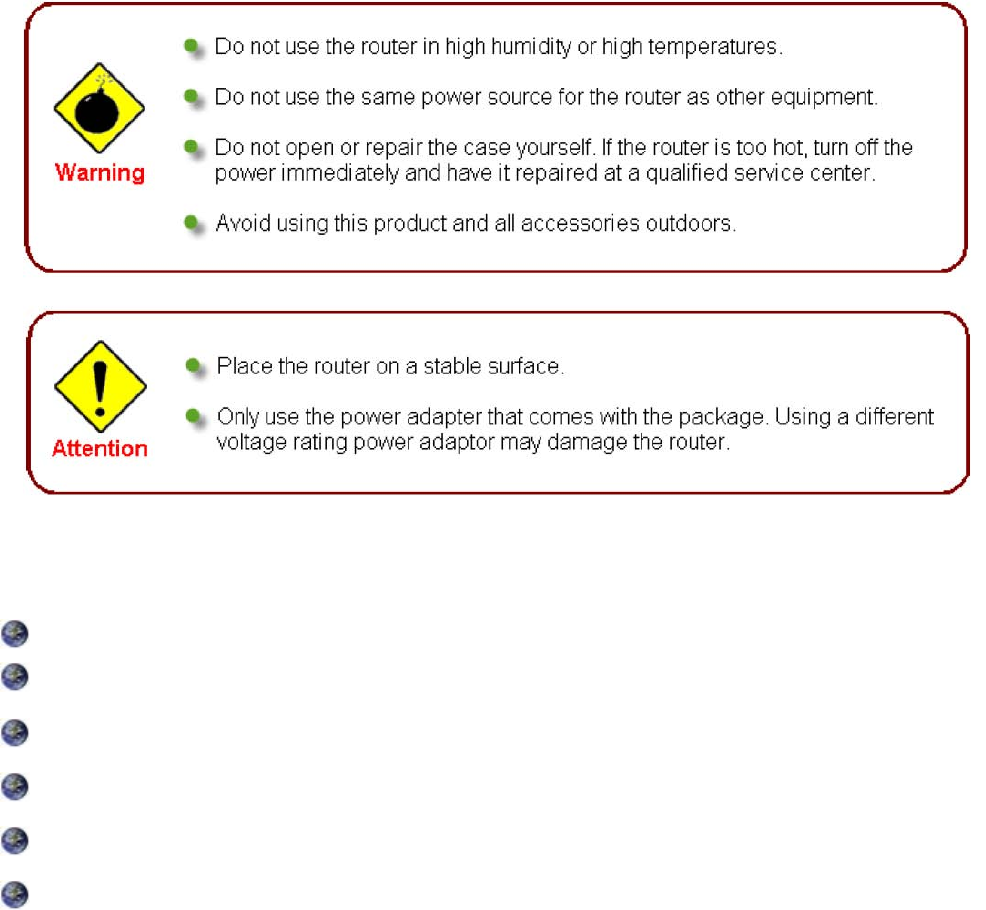
8
Important note for using this router
Package Contents
BiPAC 6200NXL 3.75G Wireless-N Broadband Router
CD containing the online manual
Ethernet Cable
AC-DC power adapter
Quick Start Guide
Antennas (2 pcs)

9
Device Description
The Front LEDs
LED Meaning
1 Power
Lit orange when power is ON.
Lit green when the device is ready.
Lit red means system failure. Restart the device or contact
Billion for support.
2 Ethernet
Port
Lit when one of LAN ports is connected to an Ethernet device.
Lit green when the speed of transmission hits 100Mbps; Lit
orange when the speed of transmission hits 10Mbps.
Blink when data is being Transmitted / Received.
3 WAN Lit green when connected to a modem or Cable modem's
Ethernet port well.
4 USB Lit green when the router is connected to a USB device.
Flash when data is received / transmitted.(The function of
USB1 is the same with USB2 )
5 Wireless
Lit green when the wireless connection is established.
Flashes when sending/receiving data.
6 WPS Push WPS button to trigger Wi-Fi Protected Setup function.
7 3G
Lit orange when the device receive 3G signal.
Lit green if the router supports this 3G card.
The Internet LED will lit when the device obtain IP address
successfully.
8 Internet
Lit green when IP connected.
Flashes green when IP connected and IP traffic is passing thru
the device.
Lit red when device attempted to become IP connected and
failed.
Lit off when device in bridged mode connection not present.
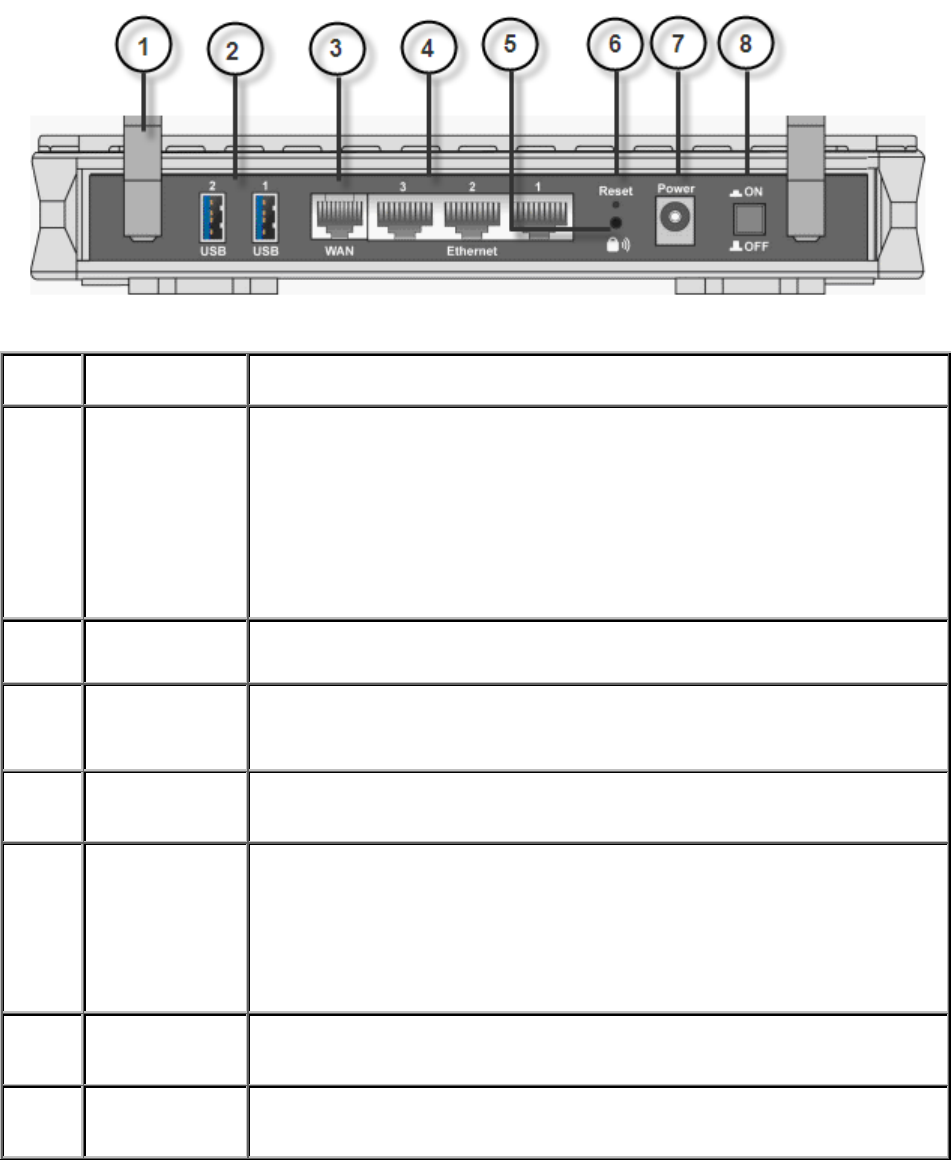
10
The Rear Ports
1 Antenna Connect the detachable antenna to this port.
2 USB
Connect the USB cable to this port.
3G/ HSDPA USB modem backup for Internet access, can also
connect with printer, Webcam and HDD serve as multi-function
servers with to help set up your own network.
(The function of USB1 is the same with USB2 )
3 WAN WAN 10/100M Ethernet port (with auto crossover support);
connect Cable modem here.
4 Ethernet Connect a UTP Ethernet cable (Cat-5 or Cat-5e) to one of the
LAN ports when connecting to a PC or an office/home network of
10Mbps or 100Mbps.
5 WPS Push WPS button to trigger Wi-Fi Protected Setup function.
6 RESET
To be sure the device is being turned on press RESET button for
6 seconds and above: restore to factory default settings. (Cannot
login to the router or forgot your Username/Password. Press the
button for more than 6 seconds).
Caution: After pressing the RESET button for more than
6 seconds, to be sure you power cycle the device again.
7 Power Connect it with the supplied power adapter.
8 Power Jack
Device is power on/off.
11
Cabling
The most common problem associated with Ethernet is bad cabling. Make sure that all connected
devices are turned on. On the front of the product is a bank of LEDs. Verify that the LAN Link and WAN
Link LEDS are lit. If they are not, verify that you are using the proper cables.

12
Chapter 3: Basic Installation
You can configure the BiPAC 6200NXL router through the convenient and user-friendly interface of a
web browser. Most popular operating systems such as Linux and Windows 98/NT/2000/XP/Me
include a web browser as a standard application.
PCs must have a properly installed Ethernet interface which connects to the router directly or through
an external repeater hub. In addition, PCs must have TCP/IP installed and configured to obtain an IP
address through a DHCP server or a fixed IP address that must be in the same subnet as the router.
The default IP address of the router is 192.168.1.254 and the subnet mask is 255.255.255.0 (i.e. any
attached PC must be in the same subnet, and have an IP address in the range between 192.168.1.1
and 192.168.1.253). The easiest way is to configure the PC is to obtain an IP address automatically
from the router using DHCP. If you encounter any problems accessing the router’s web interface you
are advised to uninstall any kind of software firewall on your PCs, as they can cause problems when
trying to access the 192.168.1.254 IP address of the router.
Please follow the steps below for installation on your PC’s network environment. First of all, check your
PC’s network components. The TCP/IP protocol stack and Ethernet network adapter must be installed.
If not, please refer to your Windows-related or other operating system manuals.
Any TCP/IP capable workstation can be used to communicate with or
through the BiPAC 6200NXL. To configure other types of
workstations, please consult the manufacturer’s documentation.
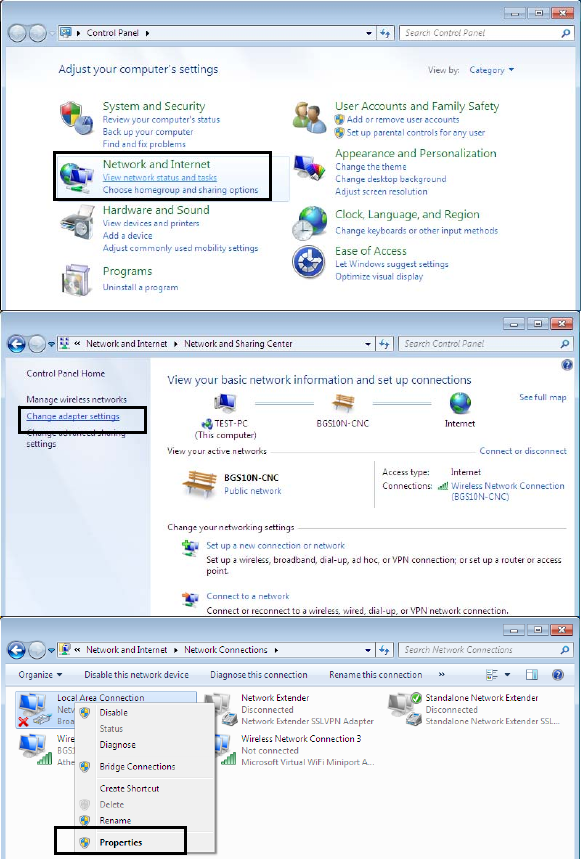
13
Network Configuration
Configuring a PC in Windows 7
1. Go to Start. Click on
Control Panel.
2. Then click on Network and
Internet.
3. When the Network and
Sharing Center window
pops up, select and click on
Change adapter settings
on the left window panel.
4. Select the Local Area
Connection, and right click
the icon to select
Properties.
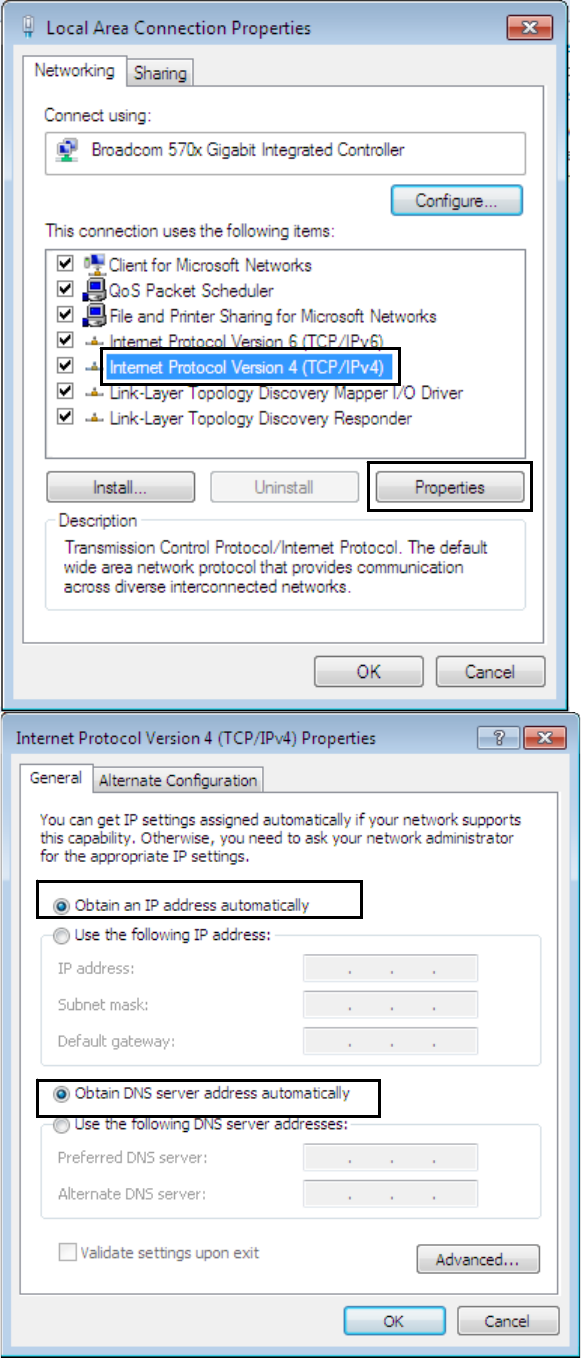
14
5. Select Internet Protocol
Version 4 (TCP/IPv4) then
click Properties.
6. In the TCP/IPv4 properties
window, select the Obtain
an IP address
automatically and Obtain
DNS Server address
automatically radio
buttons. Then click OK to
exit the setting.
7. Click OK again in the Local
Area Connection
Properties window to apply
the new configuration.
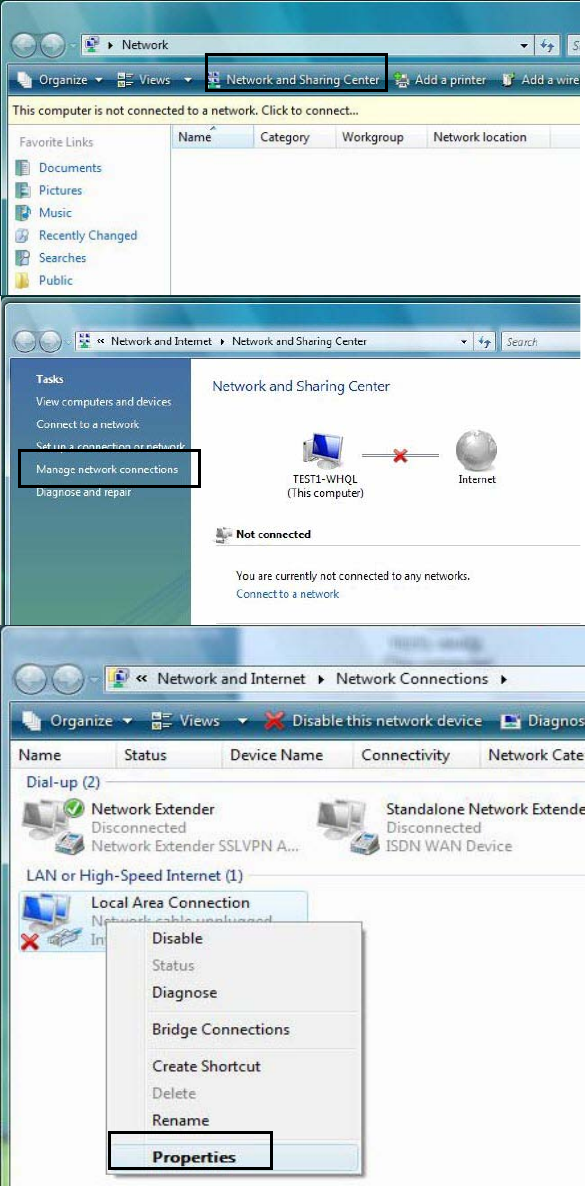
15
Configuring a PC in Windows Vista
1. Go to Start. Click on
Network.
2. Then click on Network and
Sharing Center at the top
bar.
3. When the Network and
Sharing Center window
pops up, select and click on
Manage network
connections on the left
window pane.
4. Select the Local Area
Connection, and right click
the icon to select
Properties.
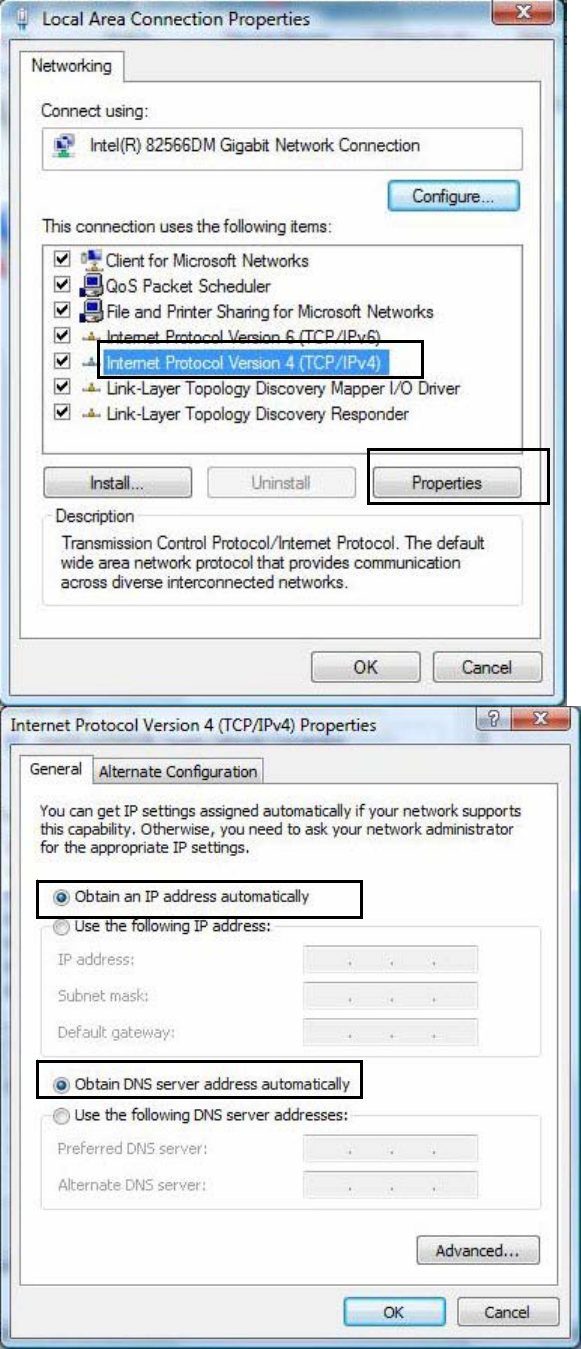
16
5. Select Internet Protocol
Version 4 (TCP/IPv4) then
click Properties.
6. In the TCP/IPv4 properties
window, select the Obtain an
IP address automatically
and Obtain DNS Server
address automatically
radio buttons. Then click OK
to exit the setting.
7. Click OK again in the Local
Area Connection
Properties window to apply
the new configuration.
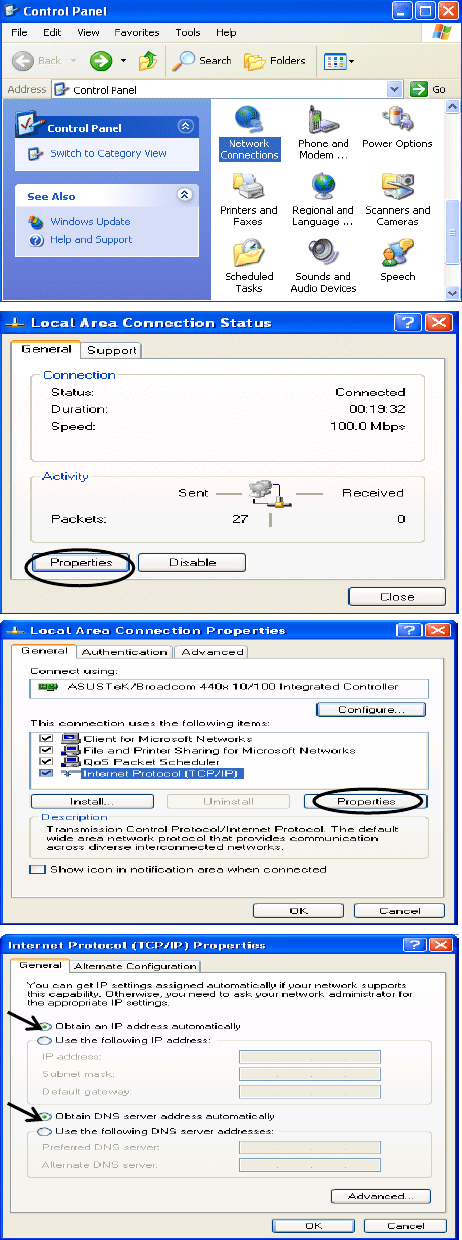
17
Configuring a PC in Windows XP
1. Go to Start. Click on Control Panel.
2. Then click on Network and Internet.
3. In the Local Area Connection Status
window, click Properties.
4. Select Internet Protocol (TCP/IP) and
click Properties.
5. Select the Obtain an IP address
automatically and the Obtain DNS
server address automatically radio
buttons.
6. Click OK to finish the configuration.
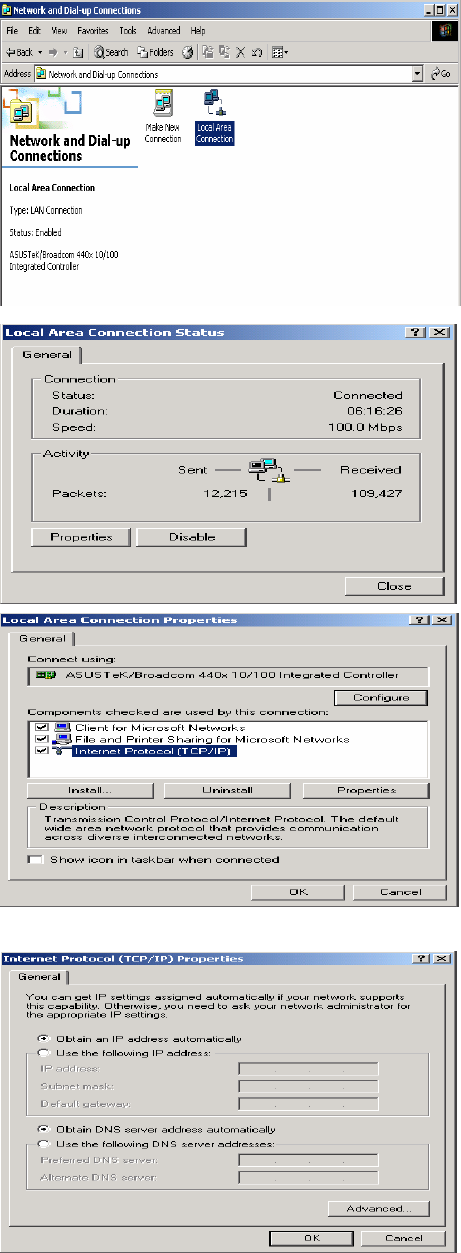
18
Configuring a PC in Windows 2000
1. Go to Start / Settings / Control Panel.
In the Control Panel, double-click on
Network and Dial-up Connections.
2. Double-click Local Area Connection.
3. In the Local Area Connection Status
window click Properties.
4. Select Internet Protocol (TCP/IP) and
click Properties.
5. Select the Obtain an IP address
automatically and the Obtain DNS
server address automatically radio
buttons.
6. Click OK to finish the configuration.
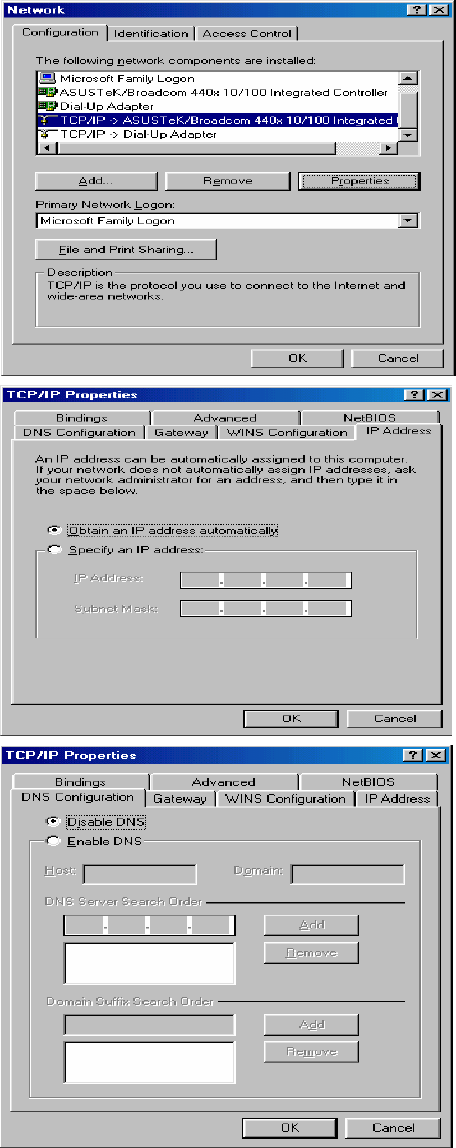
19
Configuring PC in Windows 98/Me
1. Go to Start / Settings / Control Panel.
In the Control Panel, double-click on
Network and choose the
Configuration tab.
2. Select TCP/IP ->NE2000 Compatible,
or the name of your Network Interface
Card (NIC) in your PC.
3. Select the Obtain an IP address
automatically radio button.
4. Then select the DNS Configuration
tab.
5. Select the Disable DNS radio button
and click OK to finish the configuration.
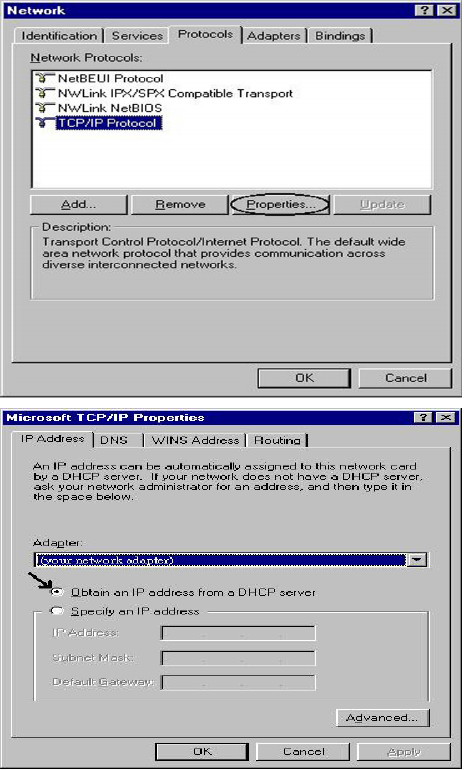
20
Configuring PC in Windows NT4.0
1. Go to Start / Settings / Control Panel.
In the Control Panel, double-click on
Network and choose the Protocols tab.
2. Select TCP/IP Protocol and click
Properties.
3. Select the Obtain an IP address from a
DHCP server radio button and click OK.
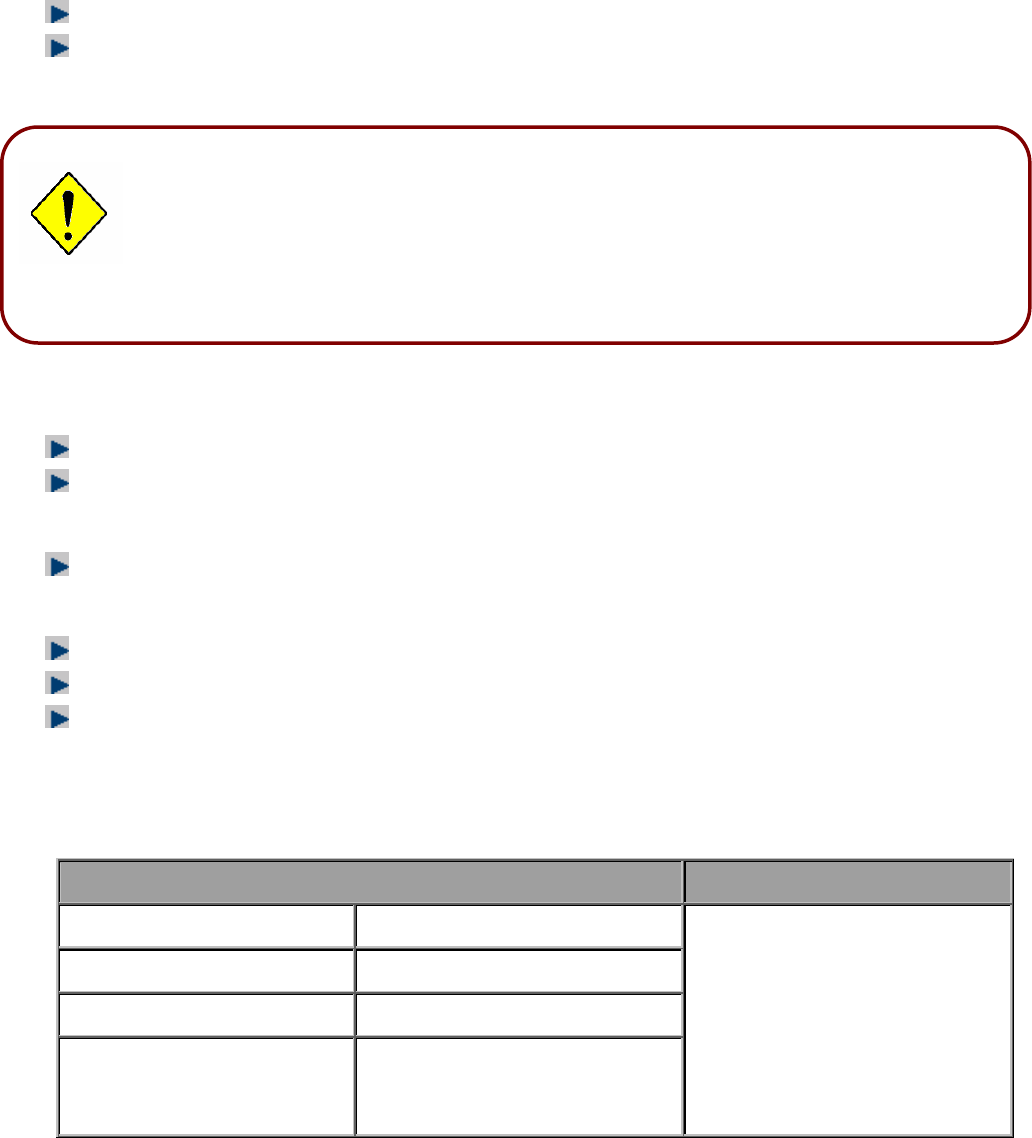
21
If you ever forget the username/password to login to the router, you may
press the RESET button up to 6 seconds then release it to restore the
factory default settings.
Caution: After pressing the RESET button for more than 6 seconds then
release it, to be sure you power cycle the device again.
Factory Default Settings
Before configuring the BiPAC 6200NXL router, you need to know the following default settings.
Web Interface: (Username and Password)
Username: admin
Password: admin
The default username and password are “admin” and “admin” respectively.
Device LAN IP settings
IP Address: 192.168.1.254
Subnet Mask: 255.255.255.0
ISP setting in WAN site
Obtain an IP Address Automatically
DHCP server
DHCP server is enabled.
Start IP Address: 192.168.1.100
IP pool counts: 100
LAN and WAN Port Addresses
The parameters of LAN and WAN ports are preset at the factory. The default values are shown below.
LAN Port WAN Port
IP address 192.168.1.254
Subnet Mask 255.255.255.0
DHCP server function Enabled in ports 1, 2 and 3
IP addresses for
distribution to PCs 100 IP addresses continuing
from 192.168.1.100 through
192.168.1.199
The DHCP function is
enabled to automatically get
the WAN port configuration
from the ISP.
Attention

22
Information from your ISP
Before configuring this device, you have to check with your ISP (Internet Service Provider) what kind
of services are provided, such as PPPoE, Obtain an IP Address Automatically, Fixed IP address.
Gather the information as illustrated in the following table and keep it for reference.
PPPoE
Username, Password, Service Name, and Domain Name
System (DNS) IP address (it can be automatically assigned
by your ISP when you connect or be set manually).
Obtain an IP Address
Automatically
DHCP Client (it can be automatically assigned by your ISP
when you connect or be set manually).
Fixed IP Address IP address, Subnet mask, Gateway address, and Domain
Name System (DNS) IP address (it is fixed IP address).
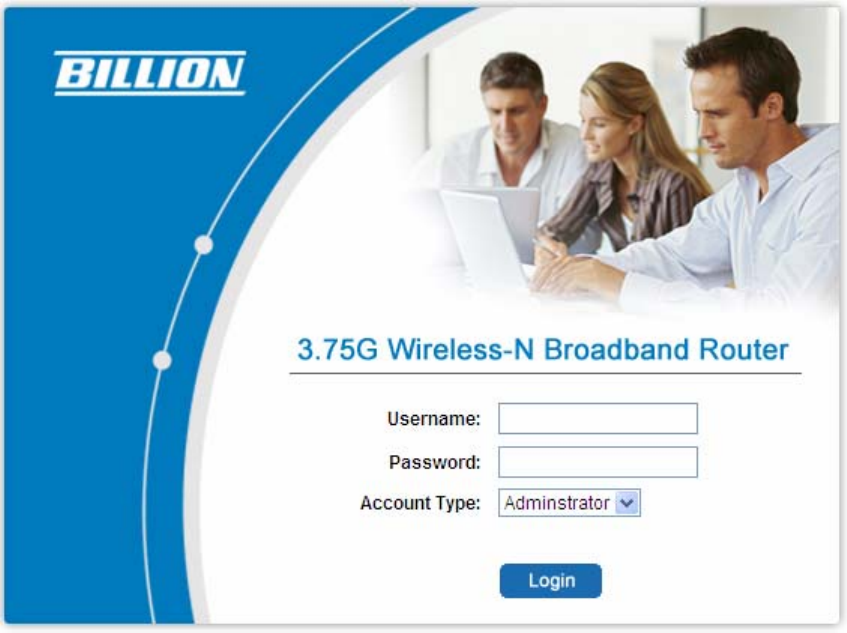
23
Configuring with your Web Browser
Open your web browser, enter the IP address of your router, which by default is 192.168.1.254, and
click “Go”, a user name and password window prompt appears. Enter the user name and password
that your administrator has set for you and select the Account Type, then click Login. When you are
authorised, you will access to the router.The default username and password are “admin” and
“admin” respectively for the Administrator account type.
Congratulations! You have successfully logged on to your BiPAC 6200NXL Router!

24
Chapter 4: Basic Configuration
Once you have logged on to your BiPAC 6200NXL Router via your web browser, you can begin to set
it up according to your requirements. On the configuration homepage, the left navigation pane links
you directly to the setup pages, which includes:
Advanced (Switch to Advanced Configuration mode)
Status
Quick Start
WAN
WLAN
Language
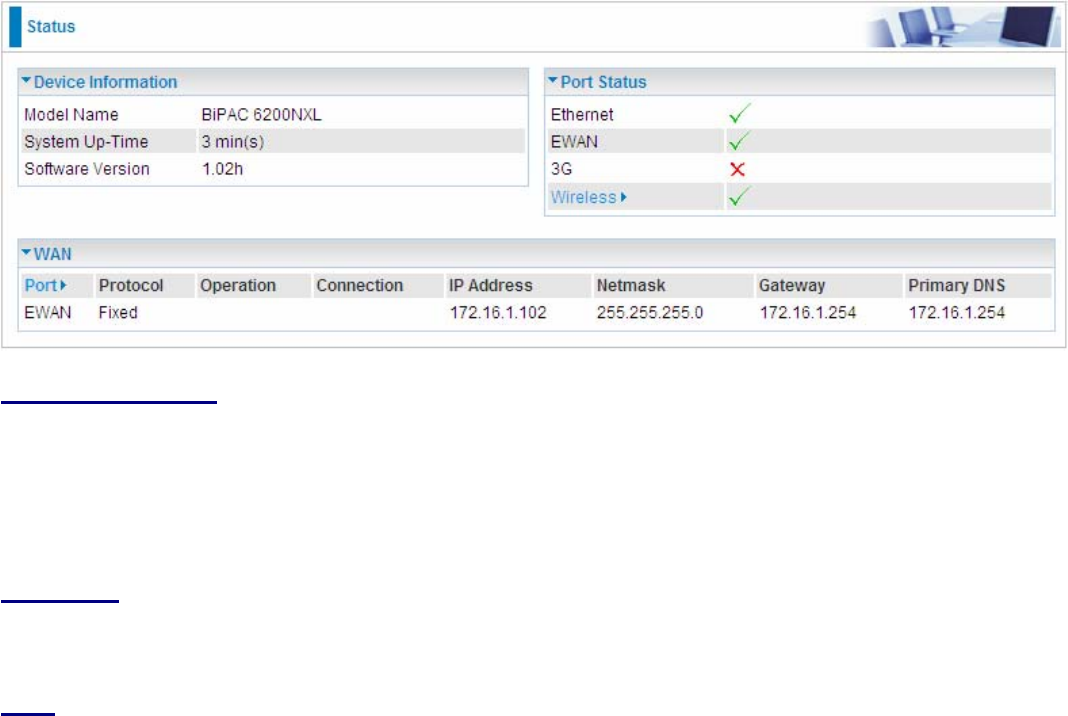
25
Status
Device Information
Model Name: Provide a name for the router for identification purposes.
System Up-Time: Record system up-time.
Software Version: Firmware version.
Port Status
Port Status:User can look up to see if they are connected to Ethernet, EWAN, and Wireless.
WAN
Port: Name of the WAN connection.
Protocol: PPPoE, Dynamic or Fixed.
Operation: Current available operation.
Connection: The current connection status.
Netmask: WAN port IP subnet mask.
Gateway: The IP address of the default gateway.
IP Address: WAN port IP address.
Primary DNS: The IP address of the primary DNS server.
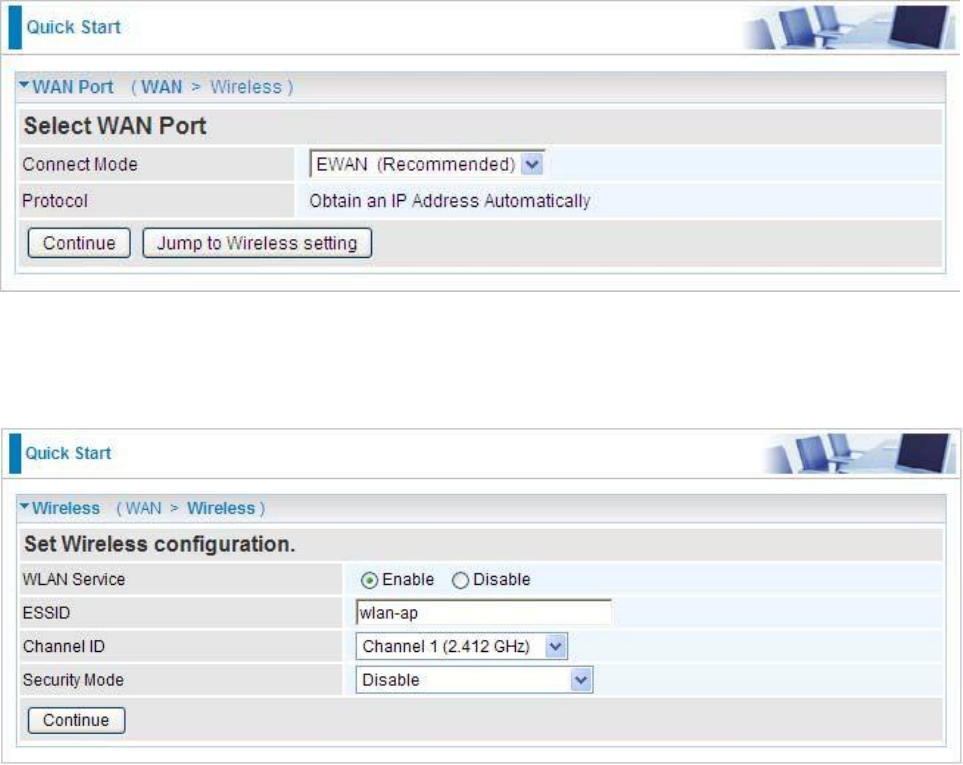
26
Quick Start
Set Wireless configuration
WLAN Service: Default setting is set to Enable.
ESSID: The ESSID is the unique name of a wireless access point (AP) to be distinguished
from another. For security purpose, change to a unique ID name to the AP which is already
built-in to the router’s wireless interface. It is case sensitive and must not excess 32
characters. Make sure your wireless clients have exactly the ESSID as the device, in order
to get connected to your network.
Channel ID: Select the ID channel that you would like to use, Available channel numbers
are 1 to 11 for USA.
Security Mode: You can disable or enable with WPA or WEP for protecting wireless network.
The default mode of wireless security is Disable.
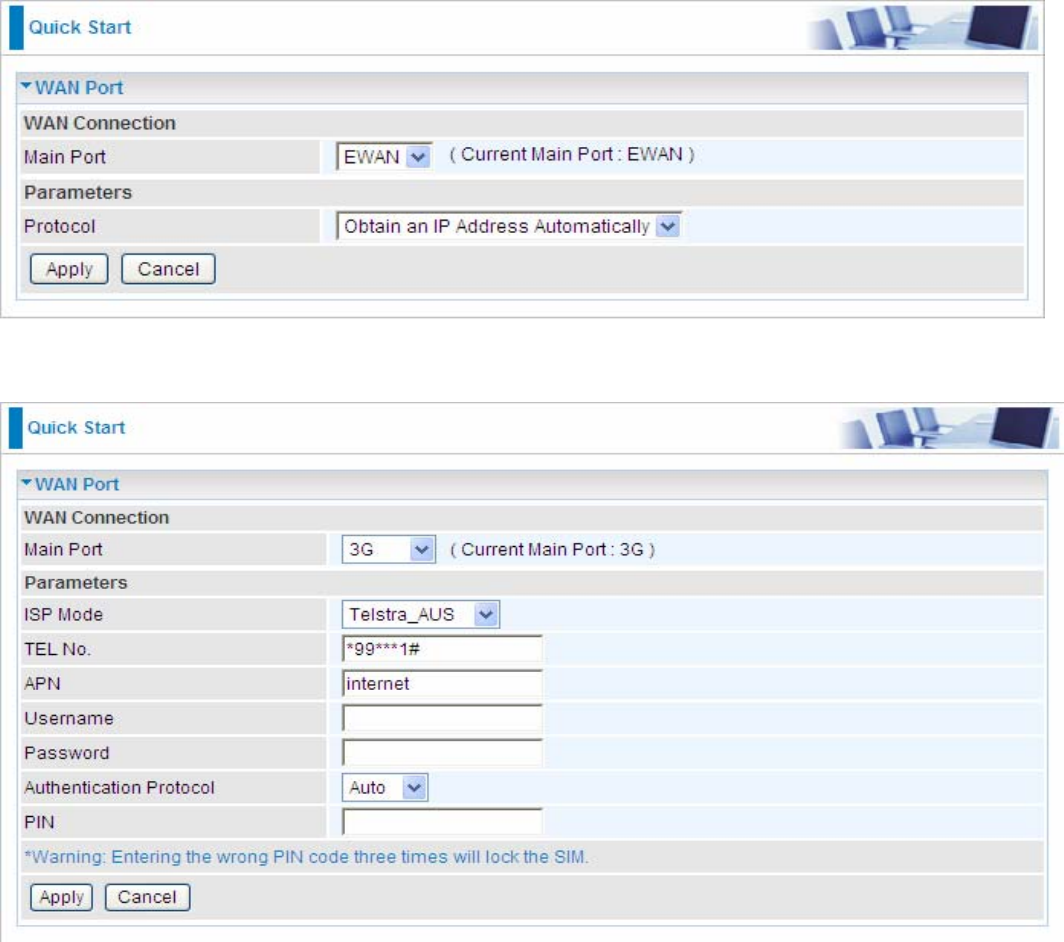
27
WAN
EWAN
3G
APN: An APN is similar to a URL on the WWW, it is what the unit makes a GPRS / UMTS call. The
service provider is able to attach anything to an APN to create a data connection. Requirements for
APN assignment varies between different service providers. Most service providers have an internet
portal which they connect a DHCP Server to, giving you access to the internet i.e. Some 3G operators
use the APN ‘internet’ for their portal. The default value of APN is “internet”.
Username: Enter the username provided by your service provider.
Password: Enter the password provided by your service provider.

28
Auth. Protocol: Manually specify CHAP (Challenge Handshake Authentication Protocol) or PAP
(Password Authentication Protocol) if you know which authentication type the server is using (when
acting as a client), or the authentication type you want the clients to use when tehy are connecting to
you (when acting as a server). When using PAP, the password is sent unencrypted, while CHAP
encrypts the password before sending, and also allows for challenges at different periods to ensure
that an intruder has not replaced the client.
PIN: PIN stands for Personal Identification Number. A PIN code is a numeric value used in certain
systems as a password to gain access, and authentication. In mobile phones a PIN code locks the
SIM card until you enter the correct code. If you enter the PIN code incorrectly into the phone 3 times
in a row, then the SIM card will be blocked and a PUK code will be required from your network / service
provider to unlock it.
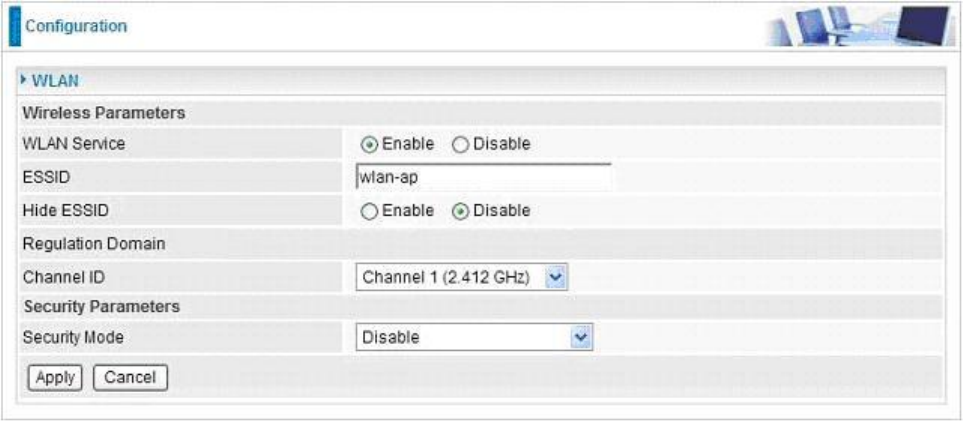
29
WLAN
WLAN Service: Default setting is set to Enable.
ESSID: The ESSID is the unique name of a wireless access point (AP) to be distinguished
from another. For security propose, change to a unique ID name to the AP which is already
built-in to the router’s wireless interface. It is case sensitive and must not excess 32
characters. Make sure your wireless clients have exactly the ESSID as the device, in order
to get connected to your network.
Note: ESSID is case sensitive and must not excess 32 characters.
Hide ESSID: It is function in which transmits its ESSID to the air so that when wireless client
searches for a network, router can then be discovered and recognized. Default setting is
Disable.
~
Enable: Select Enable if you do not want broadcast your ESSID. When select Enable,
no one will be able to locate the Access Point (AP) of your router.
~
Disable: When Disable is selected, you can allow anybody with a wireless client to
be able to locate the Access Point (AP) of your router.
Channel ID: Select the ID channel that you would like to use, Available channel numbers
are 1 to 11 for USA.
Security Mode: You can disable or enable with WPA or WEP for protecting wireless network.
The default mode of wireless security is Disable.
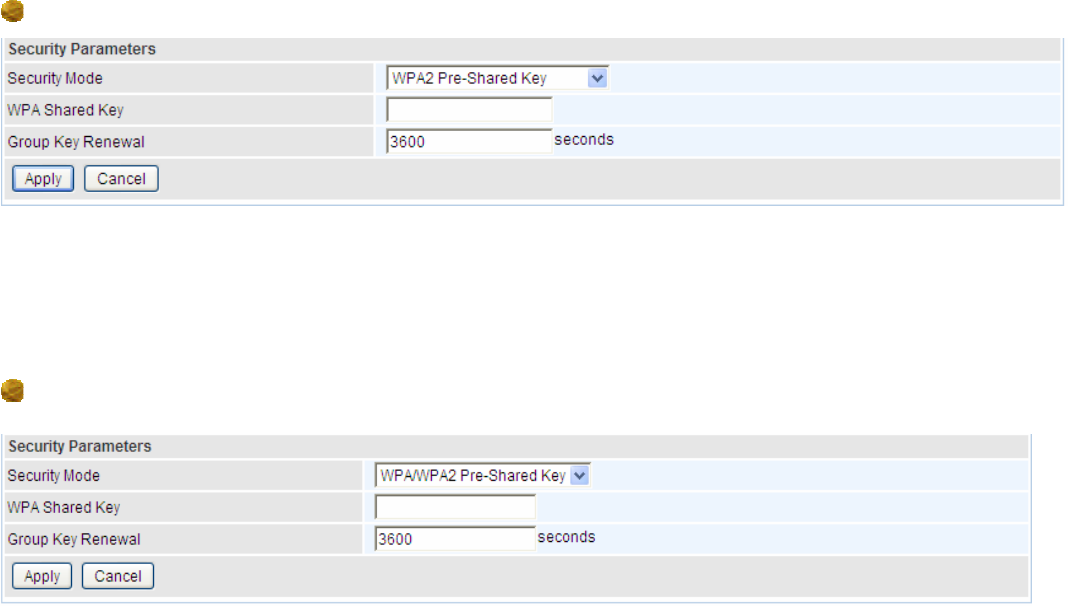
30
key size should be in the range between 8 and 63 characters.
Group Key Renewal: The period of renewal time for changing the security key between wireless
client and Access Point (AP). This process is done automatically.
WPA2 Pre-Shared Key
WPA Shared Key: The key for network authentication. The input format is in character style and key
size should be in the range between 8 and 63 characters.
Group Key Renewal: The period of renewal time for changing the security key between wireless
client and Access Point (AP). This process is done automatically.
WPA/WPA2 Pre-Shared Key
WAP Shared Key: The key for network authentication. The input format is in character style and key
size should be in the range between 8 and 63 characters.
Group Key Renewal: The period of renewal time for changing the security key between wireless
client and Access Point (AP). This process is done automatically.
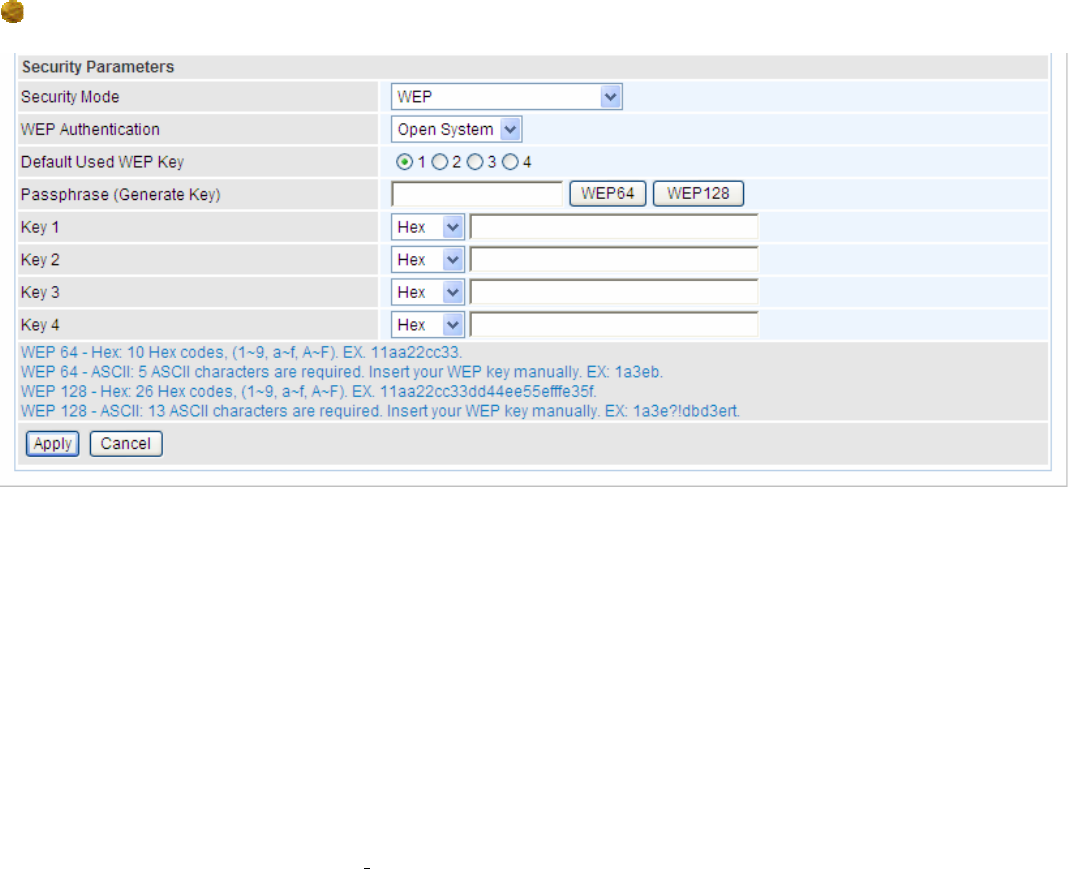
31
WEP
WEP Authentication: To prevent unauthorized wireless stations from accessing data transmitted
over the network, the router offers secure data encryption, known as WEP. If you require high security
for transmissions, there are three options to select from: Open System, Share key or Both.
Default Used WEP Key: Select the encryption key ID; please refer to Key (1~4) below.
Passphrase: This is used to generate WEP keys automatically based upon the input string and a
pre-defined algorithm in WEP64 or WEP128. You can input the same string in both the AP and Client
card settings to generate the same WEP keys. Please note that you do not have to enter Key (1-4) as
below when the Passphrase is enabled.
Key (1-4): Enter the key to encrypt wireless data. To allow encrypted data transmission, the WEP
Encryption Key values on all wireless stations must be the same as the router. There are four keys for
your selection. The input format is in HEX or ASCII style, 5 and 13 ASCII codes are required for
WEP64 and WEP128 respectively no any separator is included.

32
Chapter 5: Advanced Configuration
Once you have logged on to your BiPAC 6200NXL Router via your web browser, you can begin to set
it up according to your requirements. On the configuration homepage, the left navigation pane links
you directly to the setup pages, which include:
Basic (Switch to Basic Configuration Mode)
Status (3G Status, USB Status, ARP Table, DHCP Table, System Log, Firewall Log, UPnP
Portmap)
Quick Start
Configuration (LAN, WAN, System, USB, Firewall, Download Tool, QoS, Virtual Server, Wake on
LAN, Time Schedule and Advanced)
Language
The following sections provide an overview of the settings available for configuring your router.
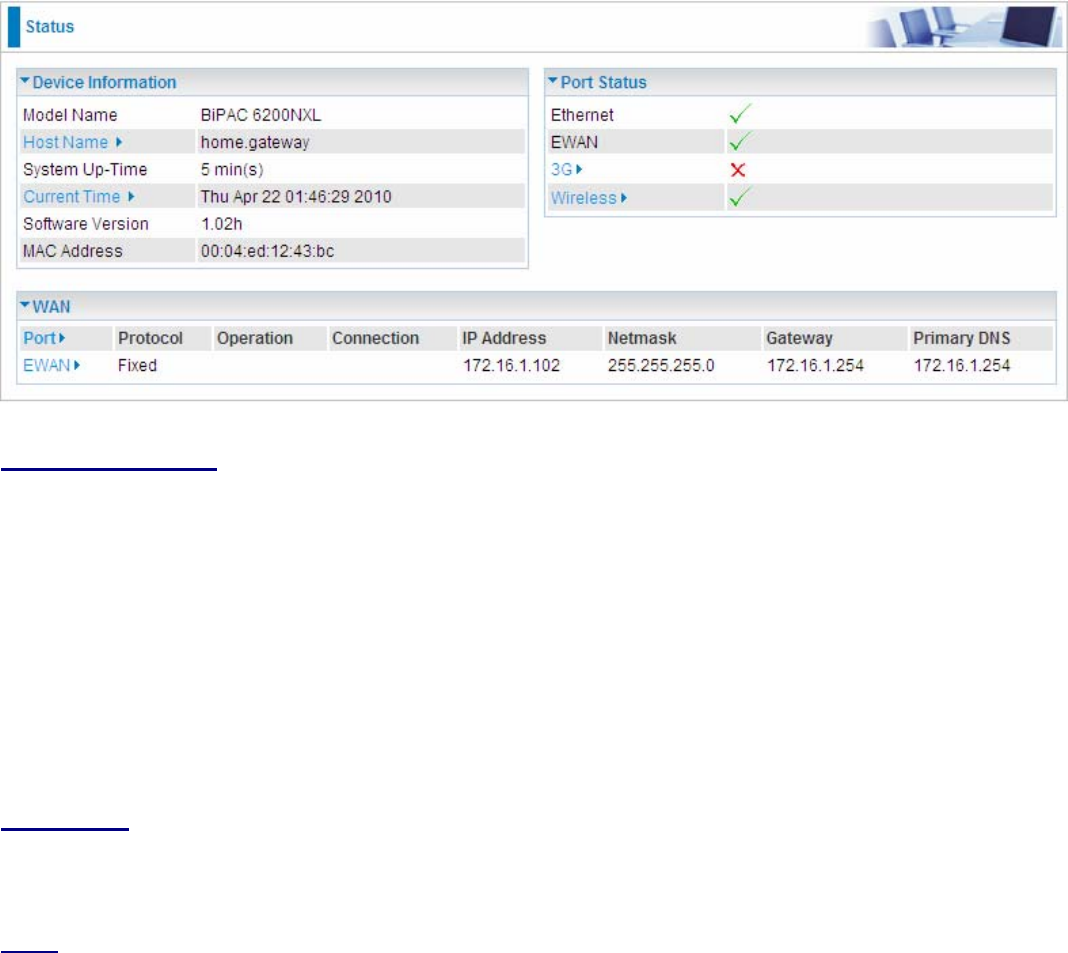
33
Status
Device Information
Model Name: Display the model name.
Host Name: Provide a name for the router for identification purposes. Host Name lets you change
the router name.
System Up-Time: Record system up-time.
Current time: Set the current time. See the Time Zone section for more information.
Software Version: Firmware version.
MAC Address: The LAN MAC address.
Port Status
Port Status:User can look up to see if they are connected to Ethernet, EWAN, 3G or Wireless.
WAN
Port: Name of the WAN connection.
Operation: Current available operation.
Connection: The current connection status.
IP Address: WAN port IP address.
Net mask: WAN port IP subnet mask.
Gateway: The IP address of the default gateway.
Primary DNS: The IP address of the primary DNS server.
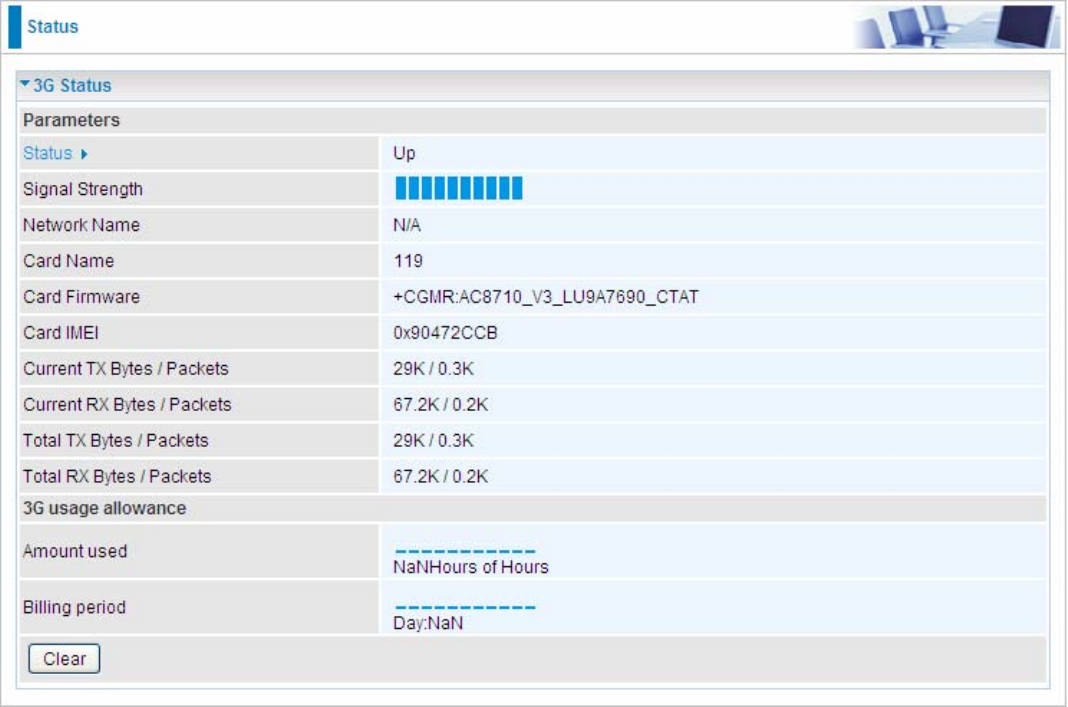
34
3G Status
This section displays the 3G Card overall status with information such as the current signal strength,
statistics of current data transmission and total data transmission.
Status: The current status of the 3G card. Click this link to configure 3G. For detail, turn to Page 70 for
help.
Signal Strength: The signal strength bar indicates the current 3G signal strength.
Network Name: The network name that the device is connected to.
Card Name: The name of the 3G card.
Card Firmware: The current firmware of the 3G card.
Card IMEI: The unique identification number that is used to identify the 3G card.
Current TX Bytes / Packets: The statistics of data transmission in bytes / packets during a call.
Current RX Bytes / Packets: The statistics of data received in bytes / packets during a call.
Total TX Bytes / Packets: The statistics of total data transmission in bytes / packets since system
ready.
Total RX Bytes / Packets: The statistics of total data received in bytes / packets since system ready.
Amount used: Show the traffic or hours has been used.
Billing preiod: The day from which the fee is charged.
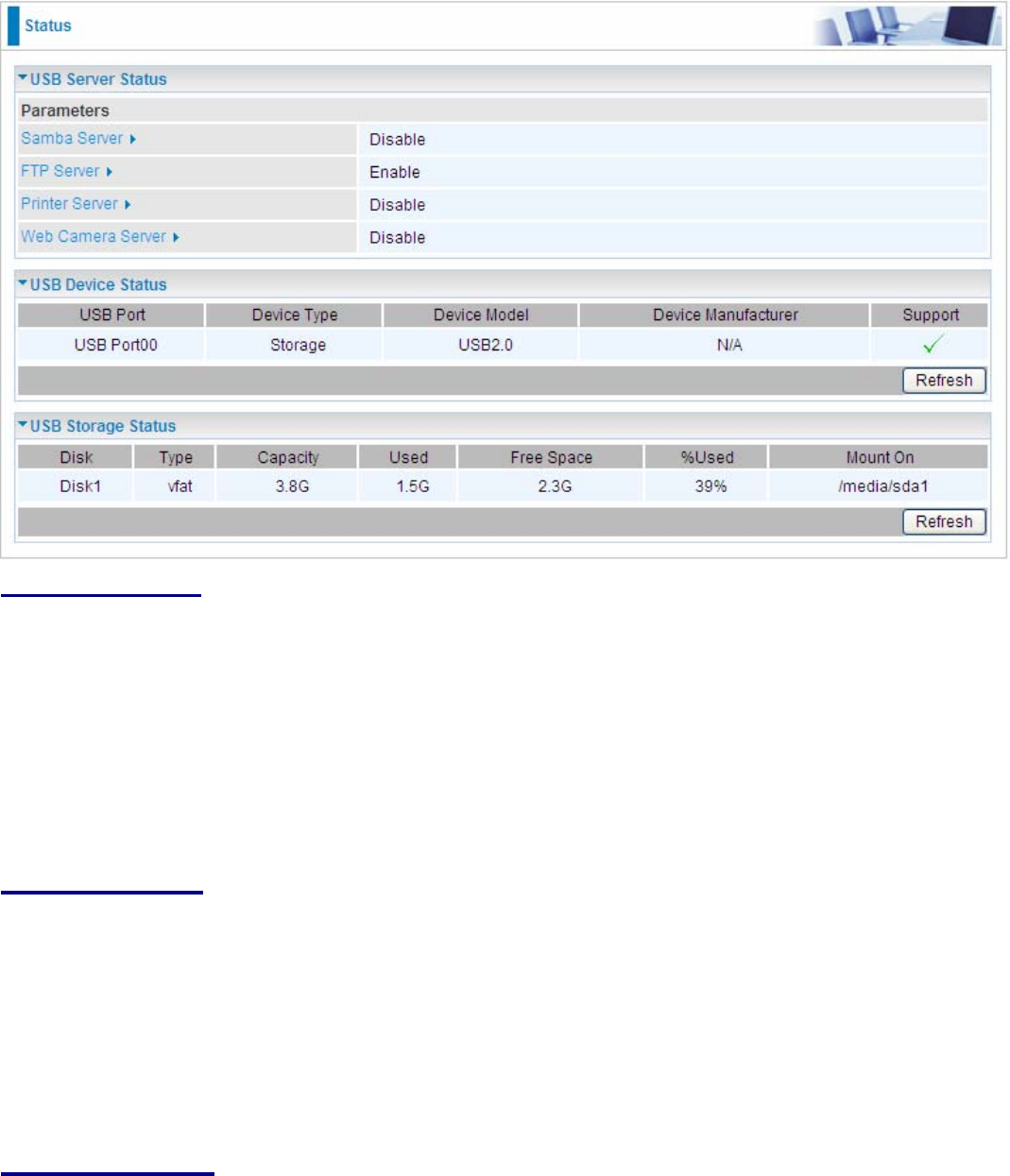
35
USB Status
This section displays the status of USB such as the USB device Status, the USB Storage Status and
the USB Server Status which give users a overall view of the USB configuration.
USB Server Status
Samba Server: display the current status of the Samba, enable or disable.
FTP Server: display the current status of the FTP Server, enable or disable.
Printer Server: display the current status of the Printer Server, enable or disable.
Web Camera Server: display the current status of the Web Camera Server, enable or disable.
Click the of the above four links to enter the corresponding page to configure furter. For more information ,
please turn to Samba Server, FTP Server, Printer Server, Webcam in USB Server section for detail.
USB Device Status
USB Port: display which USB port the device are connected to.
Device Type: display the type of the device.
Device Model: display the model of the device.
Device manufacture: display the manufacture of the device.
Support: indicate whether the device is supported.
Refresh: to get the latest message.
USB Storage Status
Disk: display the storage partition.
Type: display the file storage type.
Capacity: display the capacity of the disk.
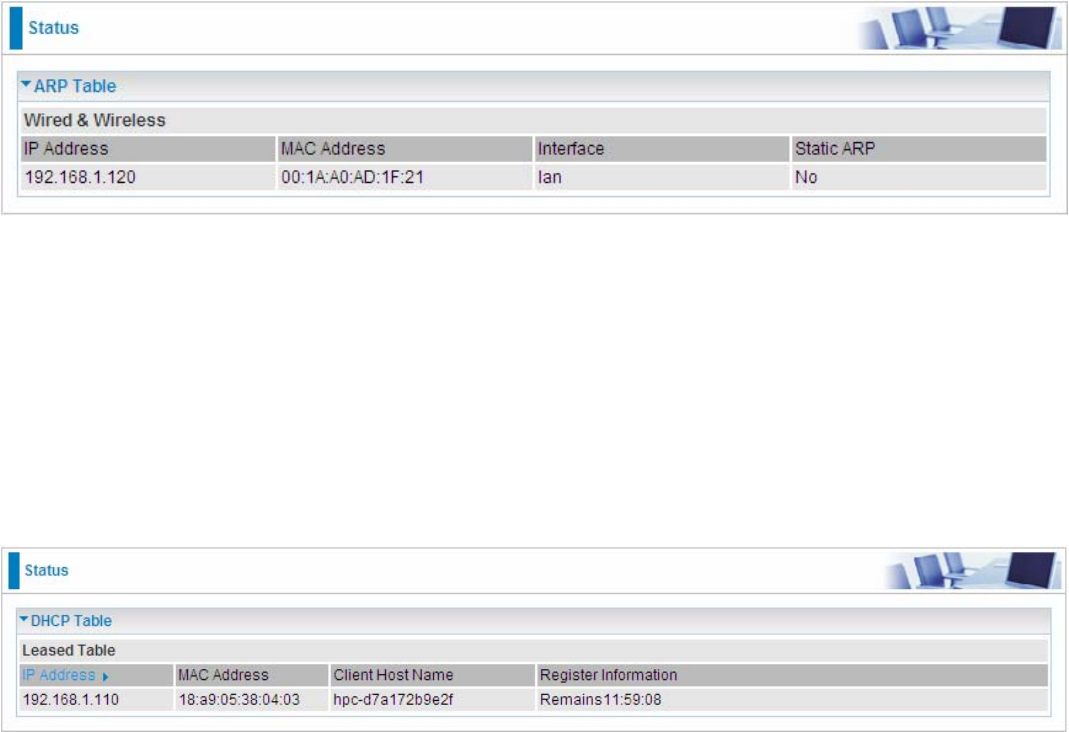
36
Used: display how much has been used.
Free Space: display the remaining space available.
%Used: display the percentage of used space to the all space.
Mount on: display which partition path the device is mounted on.
Refresh: to get the latest message.
ARP Table
This section displays the router’s ARP (Address Resolution Protocol) Table, which shows the mapping
of Internet (IP) addresses to Ethernet (MAC) addresses. This is useful as a quick way of determining
the MAC address of the network interface of your PCs to use with the router’s Firewall - MAC
Address Filter function. See the Firewall section of this manual for more information on this feature.
IP Address: It is IP Address of internal host that join this network.
MAC Address: The MAC address of internal host.
Interface: The ARP interface.
Static ARP: The state for ARP.
DHCP Table
IP Address: The current corresponding DHCP-assigned dynamic IP address of the device. Click this
link to configure DHCP Server, for more information, turn to Page 63-64.
MAC Address: The MAC Address of internal DHCP client host.
Client Host Name: The Host Name of internal DHCP client.
Register Information: Register time information.
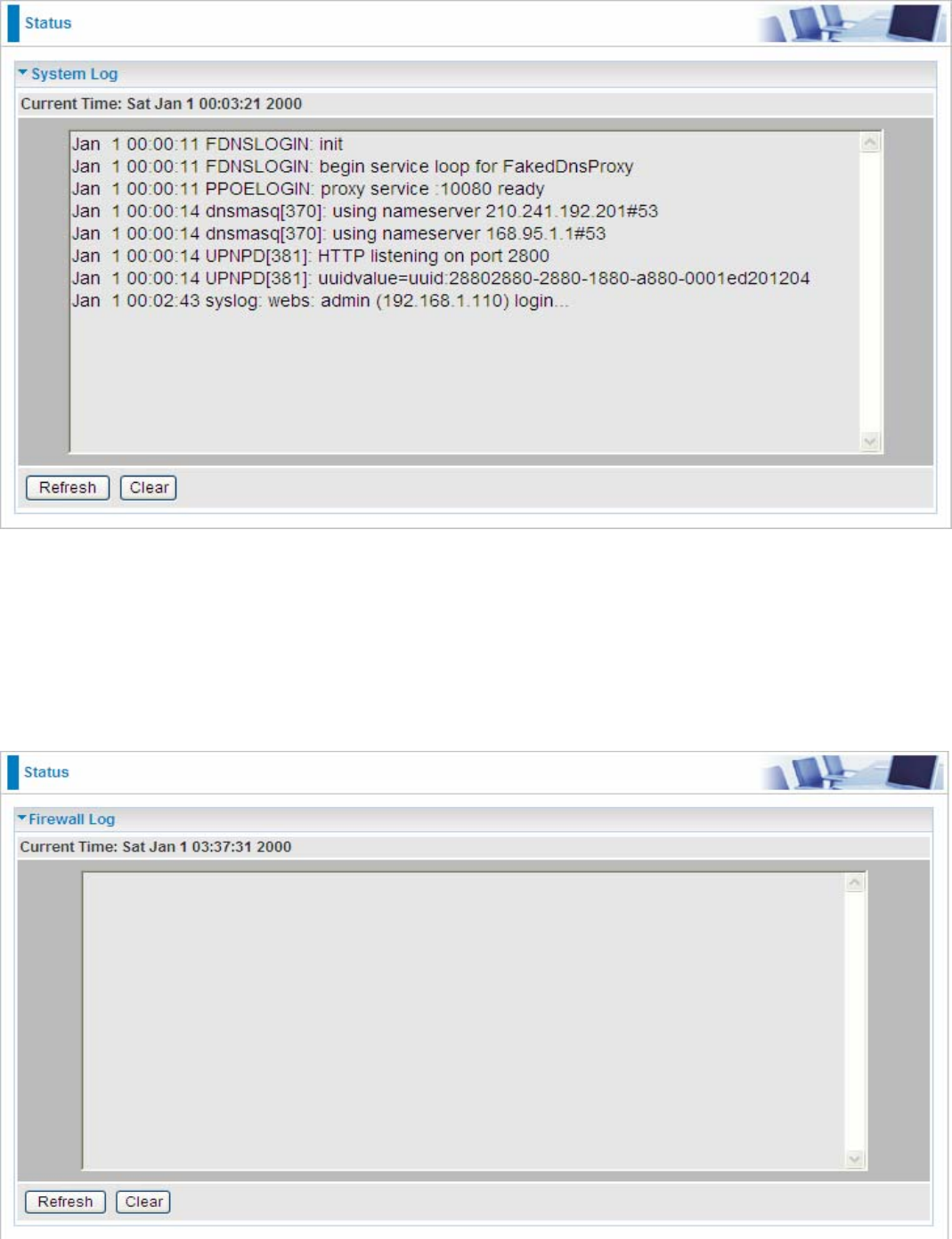
37
System Log
Display system logs accumulated up to the present time. You can trace historical information with this
function.
Firewall Log
Firewall Log displays log information of any unexpected action with your firewall settings. This page
displays the router’s Firewall Log entries. The log shows log entries when you have enabled Intrusion
Detection or Block WAN PING in the Configuration - Firewall section of the interface. Please see the
Firewall section of this manual for more details on how to enable Firewall logging.

38
UPnP Portmap
The section lists all port-mapping established using UPnP (Universal Plug and Play). Please see the
Advanced section of this manual for more details on UPnP and the router’s UPnP configuration
options.
Name: the name of this UPnP mapping.
Protocol: the protocol used by this mapping.
External Port: the external service port the internal port mapped to.
Internal Port: the internal service port.
IP Address: the IP Address of the host in LAN.
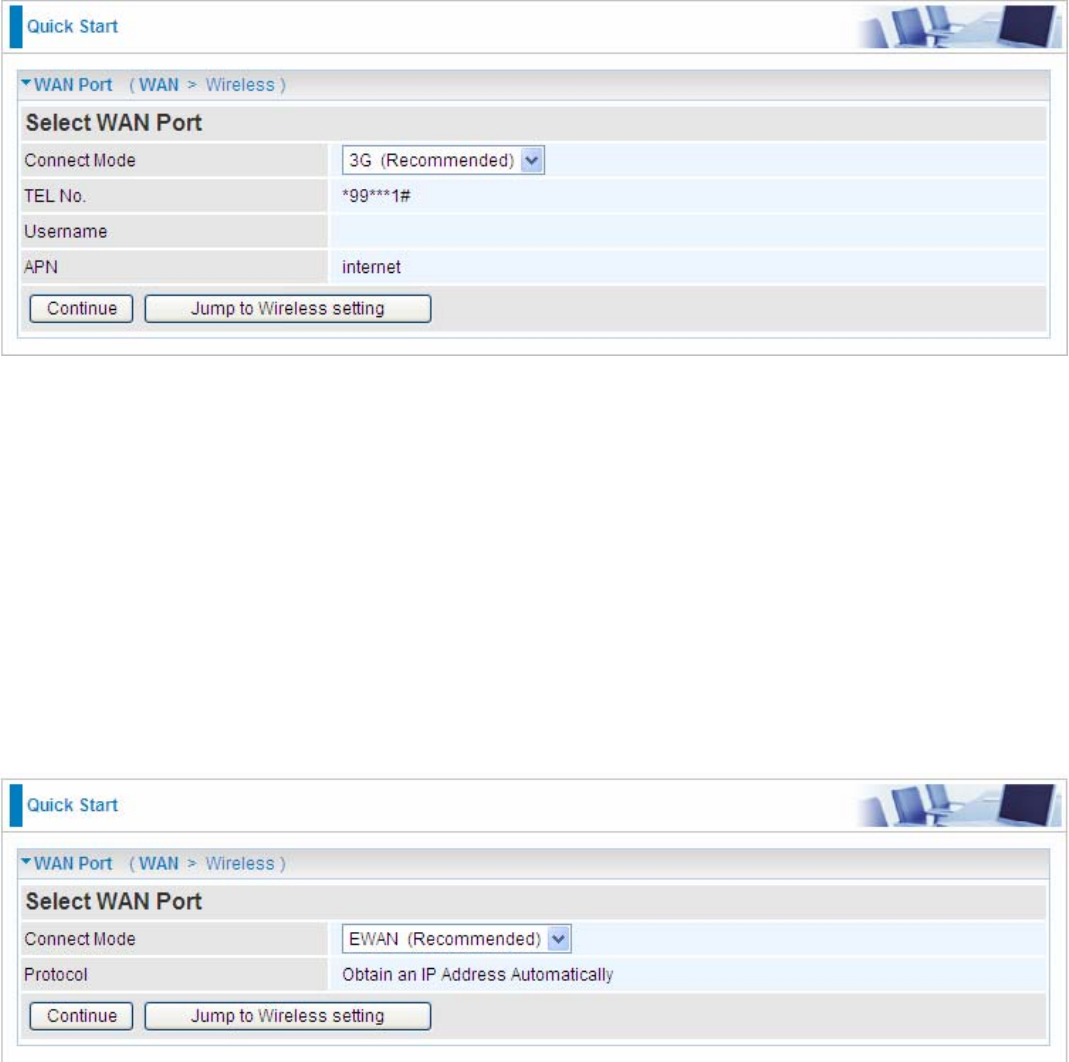
39
Quick Start
3G
Connect mode: 3G
TEL No.: The dial string to make a GPRS / 3G user internetworking call. It may be provided by your
mobile service provider.
Username: Enter the username provided by your service provider.
APN: An APN is similar to a URL on the WWW, it is what the unit makes a GPRS / UMTS call. The
service provider is able to attach anything to an APN to create a data connection. Requirements for
APN assignment varies between different service providers. Most service providers have an internet
portal which they connect a DHCP Server to, giving you access to the internet i.e. Some 3G operators
use the APN ‘internet’ for their portal. The default value of APN is “internet”.
EWAN
Connect mode: EWAN
Protocol: The current protocol in the device.
Click on Continue to choose the Protocol to connect with EWAN or click Jump to Wireless Setting to
use Protocol: Obtain an IP Address Automatically to connect and setup wireless settings at the same
time.
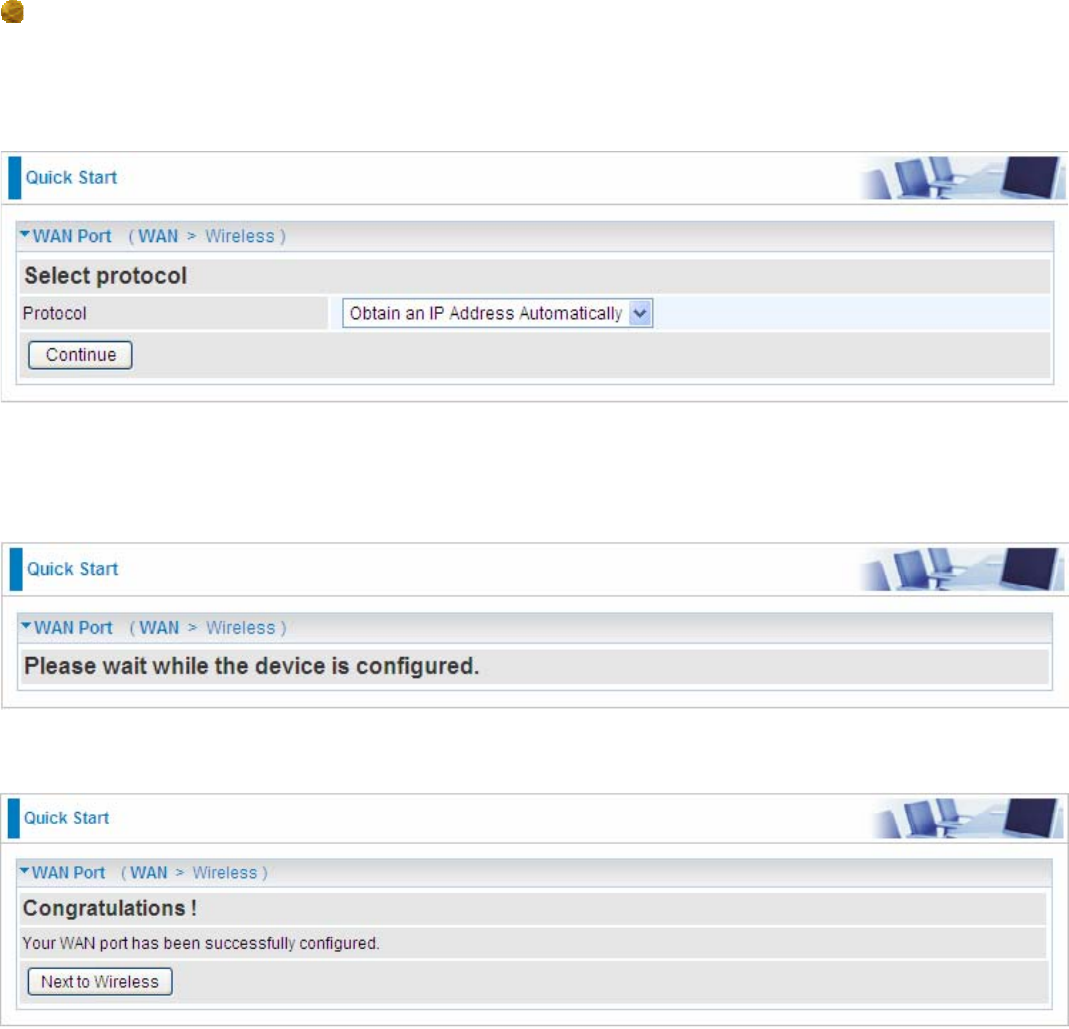
40
Obtain an IP Address Automatically
When connecting to the ISP, BiPAC 6200NXL also functions as a DHCP client. BiPAC 6200NXL can
automatically obtain an IP address, subnet mask, gateway address, and DNS server addresses if the
ISP assigns this information via DHCP.
Protocol: The current protocol in the device
Click on the Continue button and wait for your connection to be connected.
If connection is successful the following image will be shown.
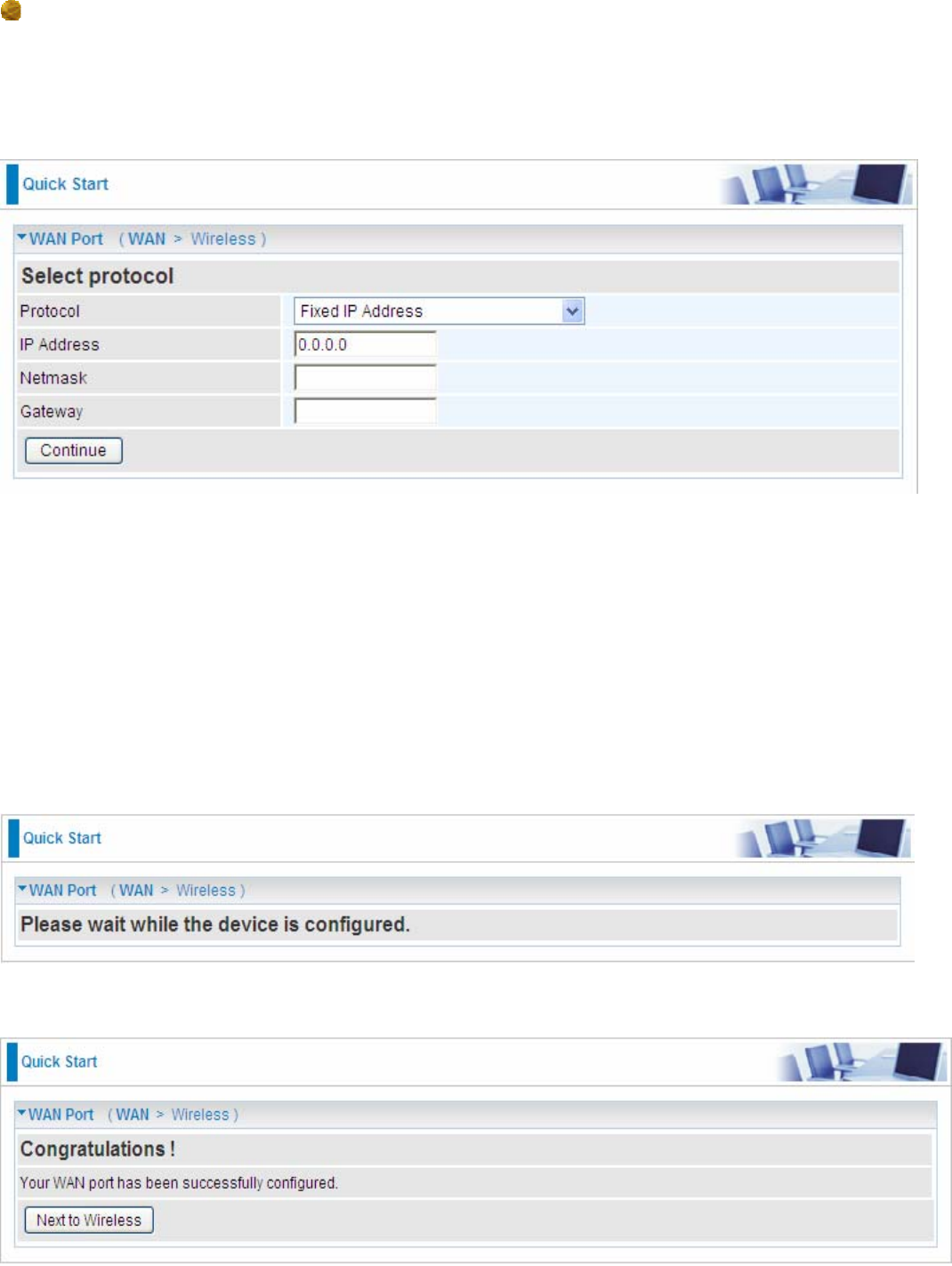
41
Fixed IP Address
Select this option to set static IP information. You will need to enter in the Connection type, IP address,
Netmask, and gateway address, provided to you by your ISP. Each IP address entered in the fields
must be in the appropriate IP form, which are four IP octets separated by a dot (x.x.x.x). The Router
will not accept the IP address if it is not in this format.
Protocol: The current ATM protocol in the device
IP Address: Your WAN IP address. Leave this at 0.0.0.0 to automatically obtain an IP address from
your ISP.
Netmask: The default is 0.0.0.0. User can change it to other such as 255.255.255.0.Type the subnet
mask assigned to you by your ISP (if given).
Gateway: You must specify a gateway IP address (supplied by your ISP)
Click on the Continue button and wait for your connection to be connected.
If connection is successful the following image will be shown.
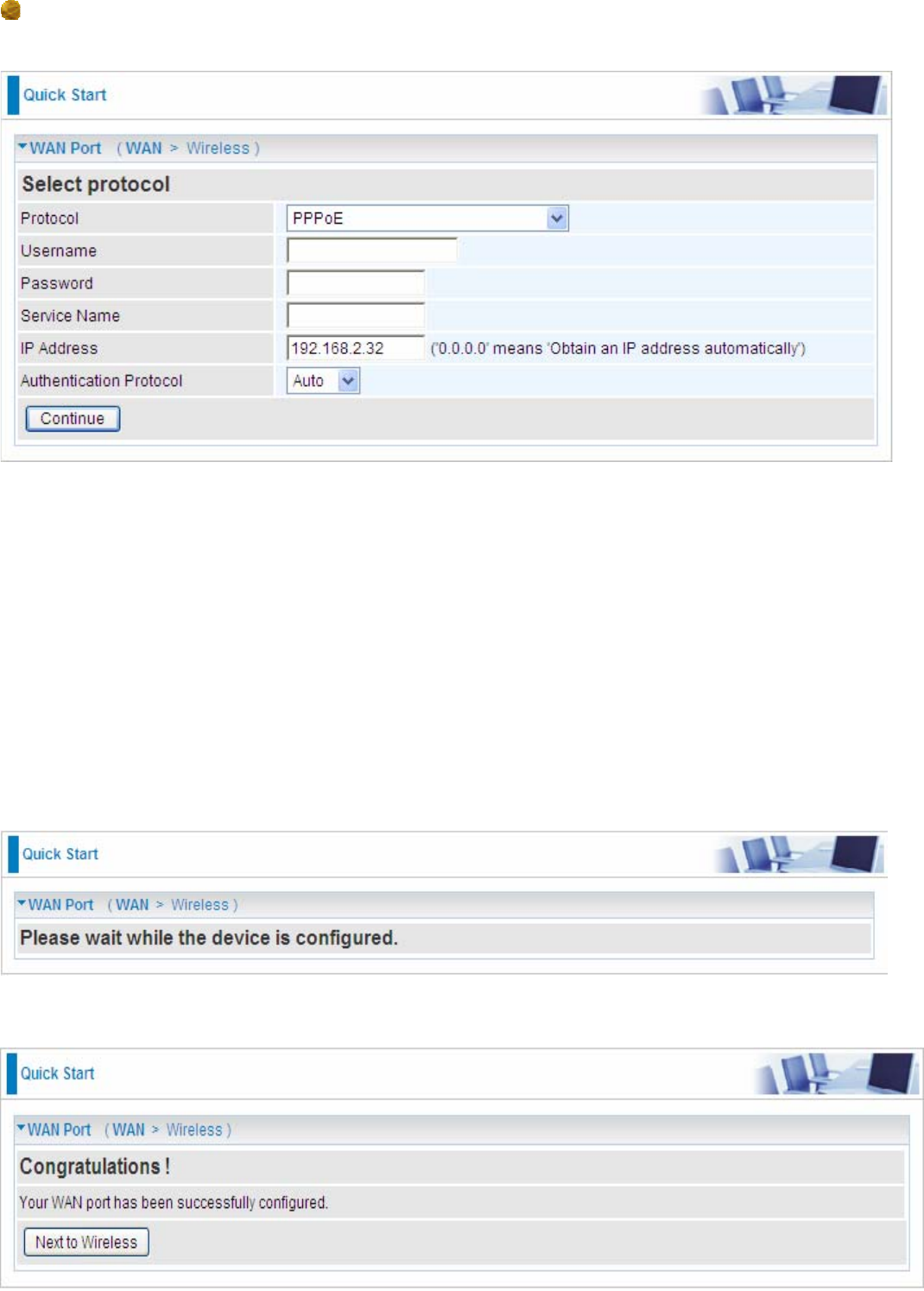
42
PPPoE
PPPoE (PPP over Ethernet) provides access control in a manner similar to dial-up services using PPP.
Protocol: The current ATM protocol in the device
Username: Enter the username provided by your ISP. You can input up to 128 alphanumeric
characters (case sensitive). This is in the format of “username@ispname” instead of simply
“username”.
Password: Enter the password provided by your ISP. You can input up to 128 alphanumeric
characters (case sensitive).
Service Name: Enter a name for this connection.
IP Address: Your WAN IP address. Leave this at 0.0.0.0 to automatically obtain an IP address from
your ISP.
Auth. Protocol: Default is Auto. Your ISP advises on using Chap or Pap.
Click on the Continue button and wait for your connection to be connected.
If connection is successful the following image will be shown.
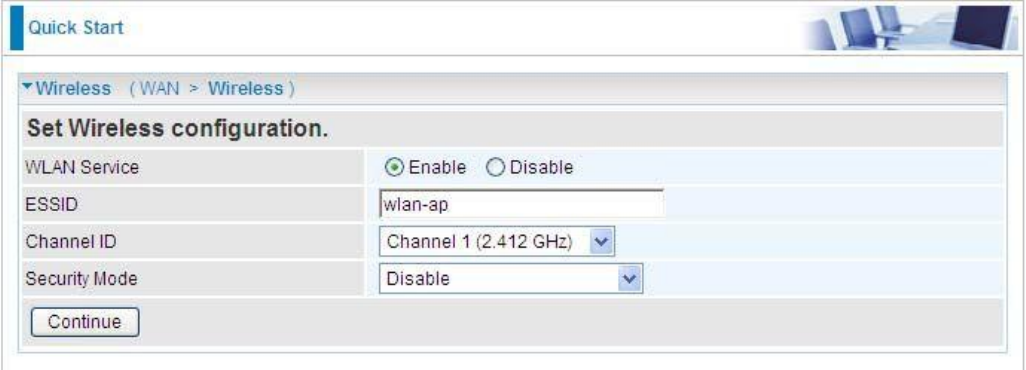
43
Set Wireless configuration
WLAN Service: Default setting is set to Enable.
ESSID: The ESSID is the unique name of a wireless access point (AP) to be distinguished from
another. For security propose, change to a unique ID name to the AP which is already built-in to the
router’s wireless interface. It is case sensitive and must not excess 32 characters. Make sure your
wireless clients have exactly the ESSID as the device, in order to get connected to your network.
Channel ID: Select the ID channel that you would like to use, Available channel numbers are 1 to
11 for USA.
Security Mode: You can disable or enable with WPA or WEP for protecting wireless network. The
default mode of wireless security is Disable.
44
Configuration
Click this item to access the following sub-items that configure the 3G router: LAN, WAN, System,
USB, Firewall, Download Tool, QoS, Virtual Server, Wake on LAN, Time Schedule and
Advanced.
These functions are described in the following sections.
LAN (Local Area Network)
A Local Area Network (LAN) is a shared communication system to which many computers are
attached and is limited to the immediate area, usually the same building or floor of a building.
There are six items within the LAN section: Ethernet, IP Alias, Wireless, Wireless Security, WPS
and DHCP Server.
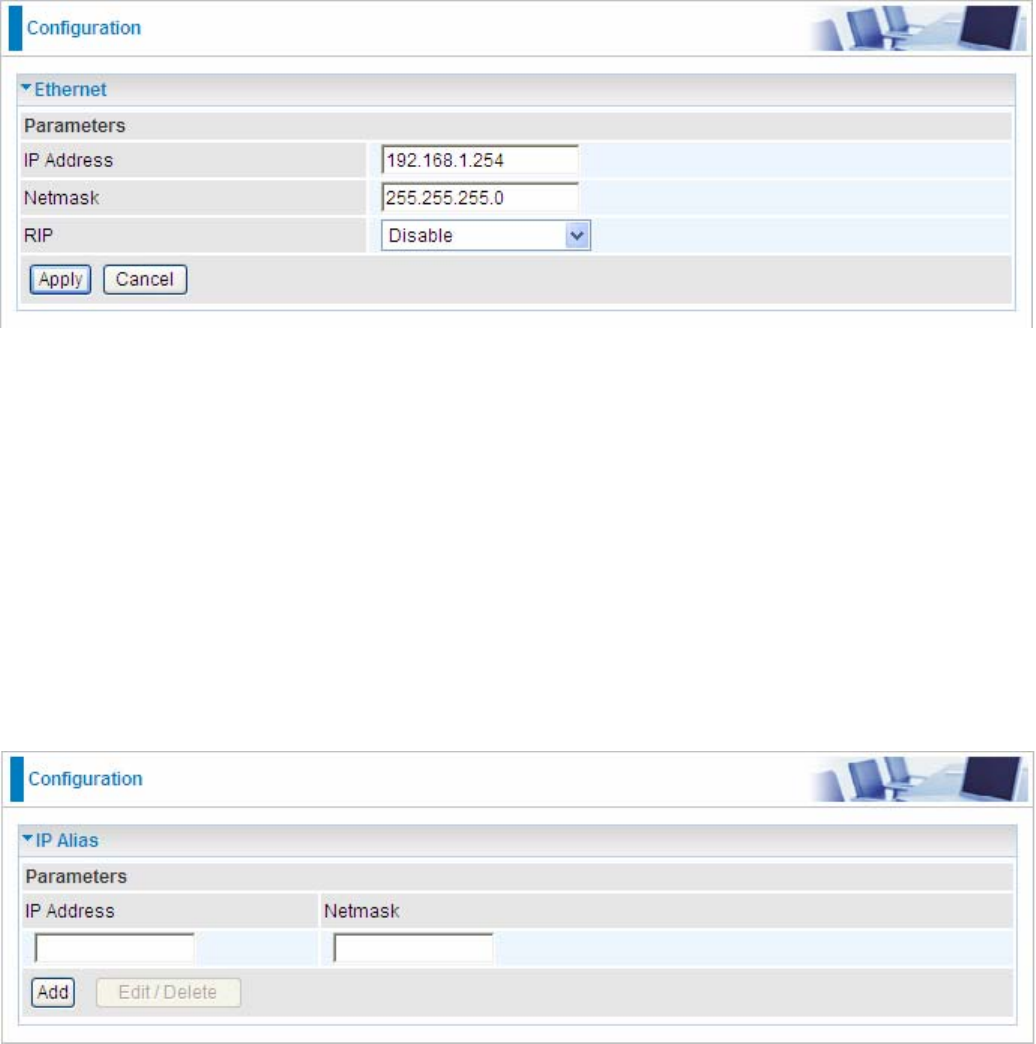
45
Ethernet
The router supports more than one Ethernet IP addresses in the LAN, and with distinct LAN subnets
through which you can access the Internet at the same time. Users usually only have one subnet in
their LAN. The default IP address for the router is 192.168.1.254.
IP Address: The default IP on this router.
Netmask: The default subnet mask on this router.
RIP: RIP v1, RIP v2 Broadcast, RIP v1+v2 Broadcast and RIP v2 Multicast.
IP Alias
This function allows the creation of multiple virtual IP interfaces on this router. It helps to connect two
or more local networks to the ISP or remote node. In this case, an internal router is not required.
IP Address: Specify an IP address on this virtual interface.
Netmask: Specify a subnet mask on this virtual interface.
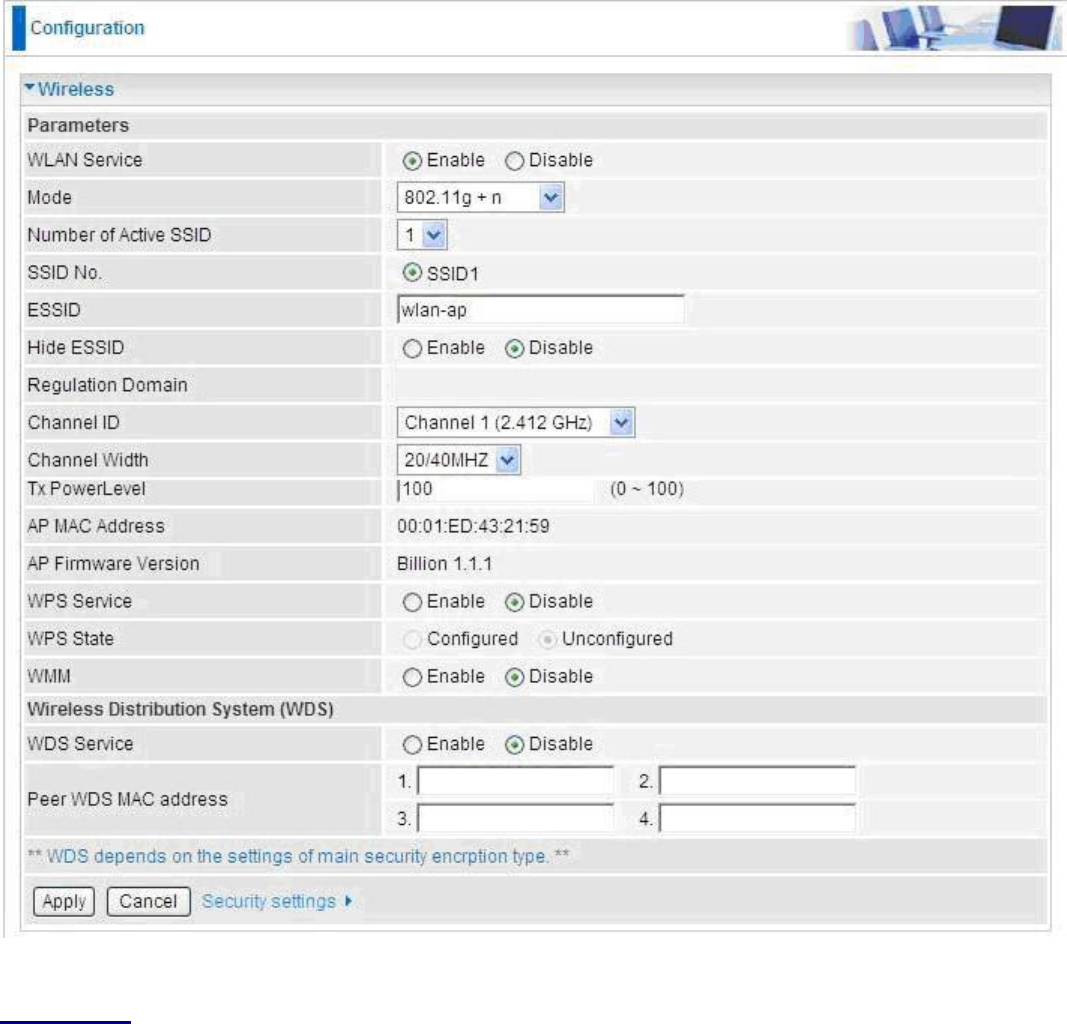
46
Wireless
Parameters
WLAN Service: Default setting is set to Enable.
Mode: The default setting is 802.11g+n (Mixed mode). If you do not know or have both 11g and 11n
devices in your network, then keep the default in mixed mode. From the drop-down manual, you can
select 802.11g if you have only 11g card. If you have only 11b card, then select 802.11b. If you have
only 11n card, then select 802.11n.
Number of Active SSID: Number of SSID you can choose.
SSID No.: The SSID you choose.
ESSID: The ESSID is the unique name of a wireless access point (AP) to be distinguished from
another. For security propose, change to a unique ID name to the AP which is already built-in to the
router’s wireless interface. It is case sensitive and must not excess 32 characters. Make sure your
wireless clients have exactly the ESSID as the device, in order to get connected to your network.

47
Note: ESSID is case sensitive and must not excess 32 characters.
Hide ESSID: It is function in which transmits its ESSID to the air so that when wireless client searches
for a network, router can then be discovered and recognized. Default setting is Disable.
~
Enable: Select Enable if you do not want broadcast your ESSID. When select Enable, no one
will be able to locate the Access Point (AP) of your router.
~
Disable: When Disable is selected, you can allow anybody with a wireless client to be able to
locate the Access Point (AP) of your router.
Channel ID: Select the ID channel that you would like to use, Available channel numbers are 1 to 11
for USA.
Channel Wdith: Select either 20 MHz or 20/40 MHz for the channel bandwidth. The higher the
bandwidth the better the performance will be.
Tx Power Level: The maximum transmitter power is17dBm±1.5dBm, It is function that
enhances the wireless transmitting signal strength. User may adjust this power level from
minimum 0 up to maximum 100.
Note: The Power Level maybe different in each access network user premises environment and
choose the most suitable level for your network.
AP MAC Address: It is a unique hardware address of the Access Point.
AP Firmware Version: The Access Point firmware version.
WPS service: Enable / disable
WPS State: Current WPS state in AP. It is be used for WCN (Windows Connect Now).
~
Configured: This AP is be configured via WPS. It is not allow to configure via WCN.
~
Unconfigured: This AP is un-configured via WPS. It can be configure via WCN.
Wireless Distribution System (WDS)
It is a wireless access point mode that enables wireless link and communication with other access
point. It is easy to be installed, simply define the peer’s MAC address of the connected AP. WDS takes
advantages of cost saving and flexibility which no extra wireless client device is required to bridge
between two access points and extending an existing wired or wireless infrastructure network to
create a larger network.
WDS Service: The default setting is Disable. Check Enable radio button to activate this function.
1. Peer WDS MAC Address: It is the associated AP’s MAC Address. It is important that your peer’s
AP must include your MAC address in order to acknowledge and communicate with each other.
2. Peer WDS MAC Address: It is the second associated AP’s MAC Address.
3. Peer WDS MAC Address: It is the third associated AP’s MAC Address.
4. Peer WDS MAC Address: It is the fourth associated AP’s MAC Address.
Note: For MAC Address, Semicolon (;) or Dash (-) must be included.
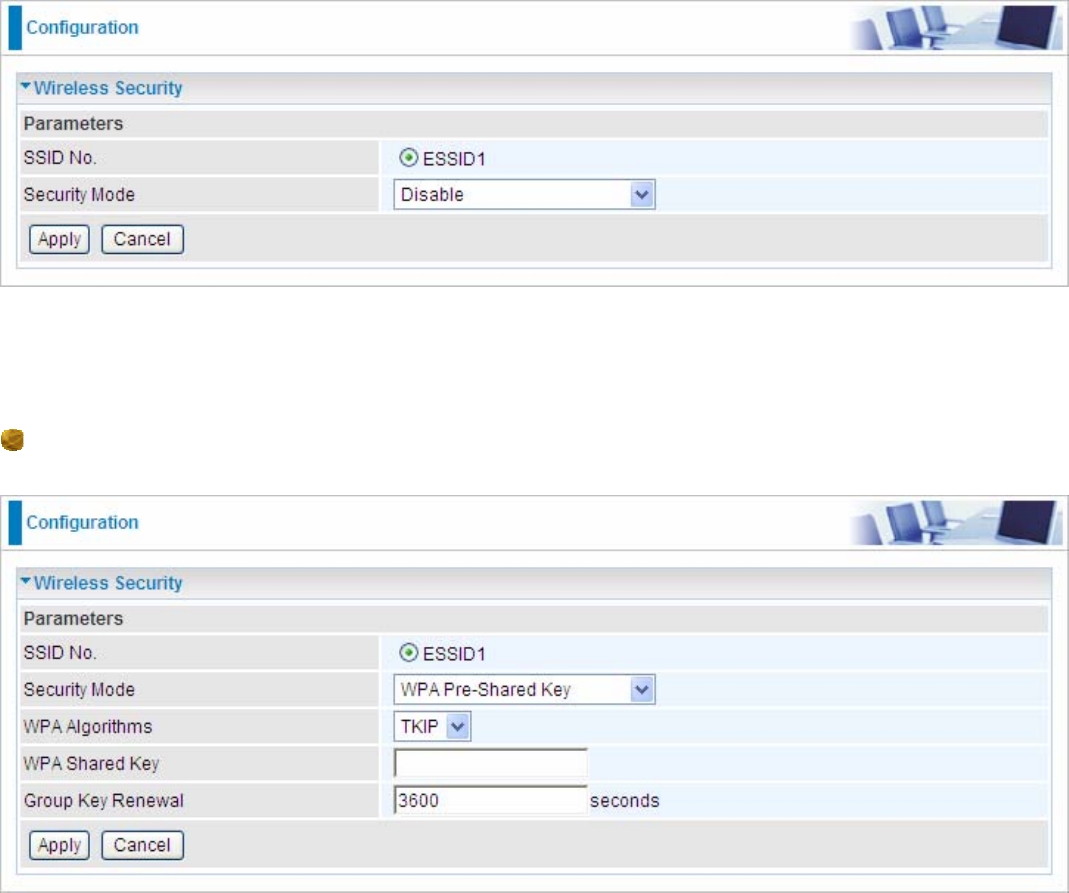
48
Wireless Security
You can disable or enable with WPA or WEP for protecting wireless network. The default mode of
wireless security is Disable.
SSID No.: Choose the SSID you want to set.
Security Mode: There are five security modes for you to choose.
WPA Pre-Shared Key
WPA Algorithms: TKIP (Temporal Key Integrity Protocol) / AES (Advanced Encryption Standard)
utilizes a stronger encryption method and incorporates Message Integrity Code (MIC) to provide
protection against hackers.
WPA Shared Key: The key for network authentication. The input format is in character style and key
size should be in the range between 8 and 63 characters.
Group Key Renewal: The period of renewal time for changing the security key automatically between
wireless client and Access Point (AP).
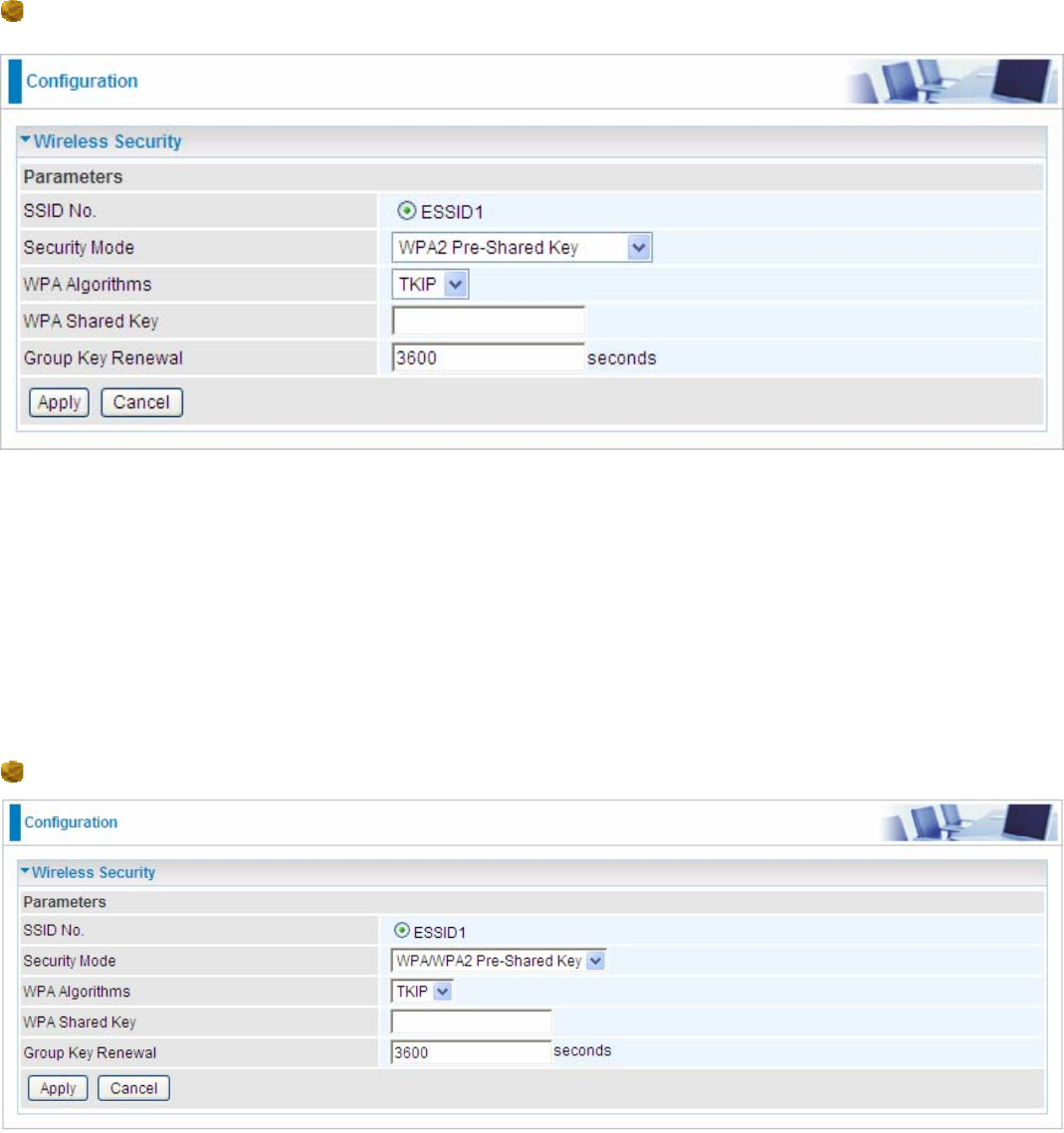
49
WPA2 Pre-Shared Key
WPA Algorithms: TKIP (Temporal Key Integrity Protocol) / AES (Advanced Encryption Standard)
utilizes a stronger encryption method and incorporates Message Integrity Code (MIC) to provide
protection against hackers.
WPA Shared Key: The key for network authentication. The input format is in character style and key
size should be in the range between 8 and 63 characters.
Group Key Renewal: The period of renewal time for changing the security key automatically between
wireless client and Access Point (AP).
WPA/WPA2 Pre-Shared Key
WPA Algorithms: TKIP (Temporal Key Integrity Protocol) / AES (Advanced Encryption Standard)
utilizes a stronger encryption method and incorporates Message Integrity Code (MIC) to provide
protection against hackers.
WPA Shared Key: The key for network authentication. The input format is in character style and key
size should be in the range between 8 and 63 characters.
Group Key Renewal: The period of renewal time for changing the security key automatically between
wireless client and Access Point (AP).
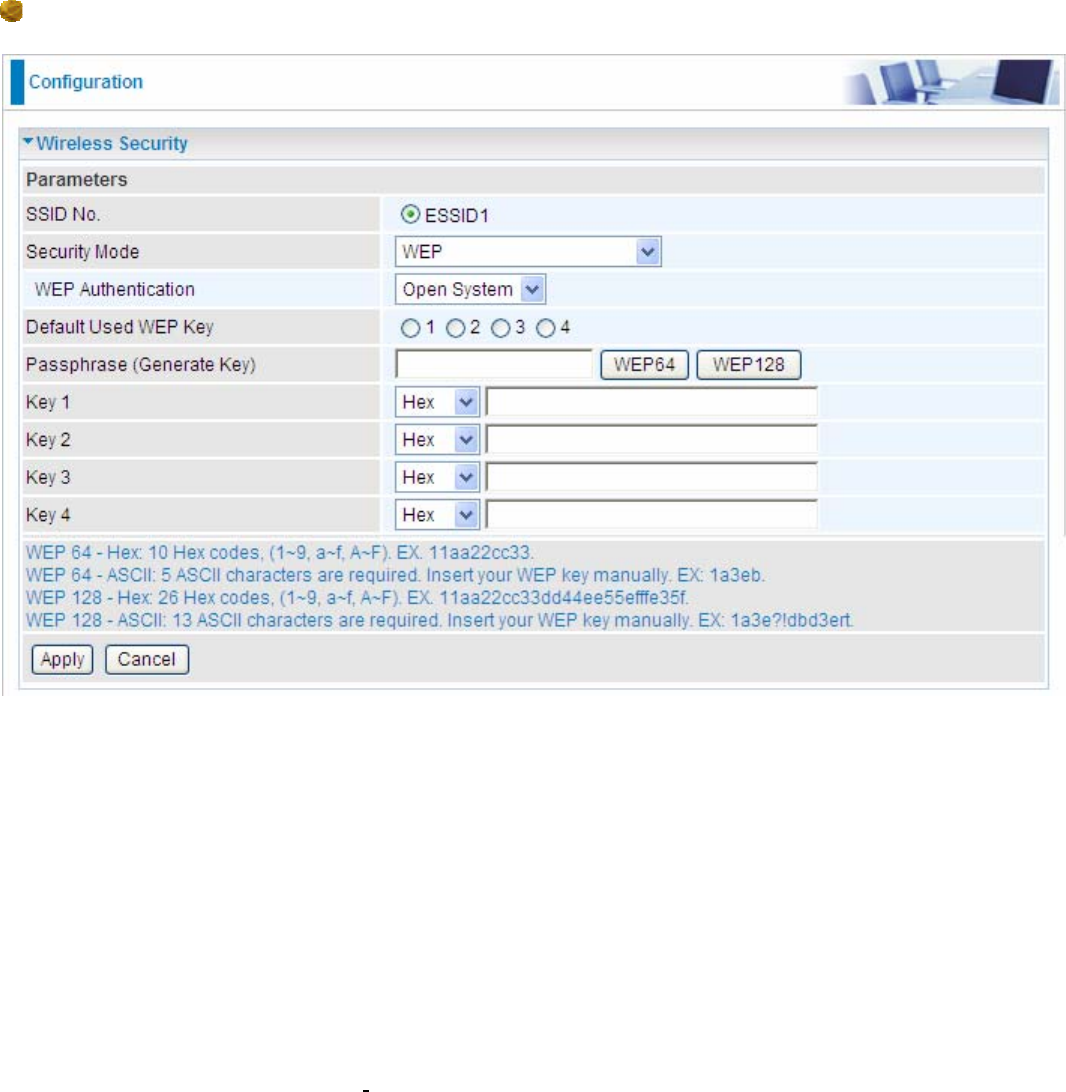
50
WEP
WEP Authentication: To prevent unauthorized wireless stations from accessing data transmitted
over the network, the router offers secure data encryption, known as WEP. If you require high security
for transmissions, there are three options to select from: Open System, Share key or Both.
Default Used WEP Key: Select the encryption key ID; please refer to Key (1~4) below.
Passphrase: This is used to generate WEP keys automatically based upon the input string and a
pre-defined algorithm in WEP64 or WEP128. You can input the same string in both the AP and Client
card settings to generate the same WEP keys. Please note that you do not have to enter Key (1-4) as
below when the Passphrase is enabled.
Key (1-4): Enter the key to encrypt wireless data. To allow encrypted data transmission, the WEP
Encryption Key values on all wireless stations must be the same as the router. There are four keys for
your selection. The input format is in HEX or ASCII style, 5 and 13 ASCII codes are required for
WEP64 and WEP128 respectively no any separator is included.
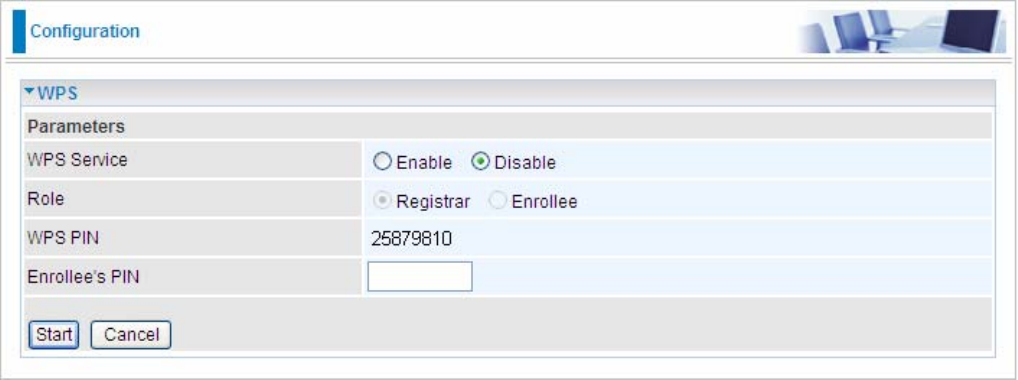
51
WPS
WPS (WiFi Protected Setup) feature is a standard protocol created by Wi-Fi Alliance. This feature
greatly simplifies the steps needed to create a Wi-Fi network for a residential or an office setting. WPS
supports 2 types of configuration methods which are commonly known among consumers: PIN
Method & PBC Method.
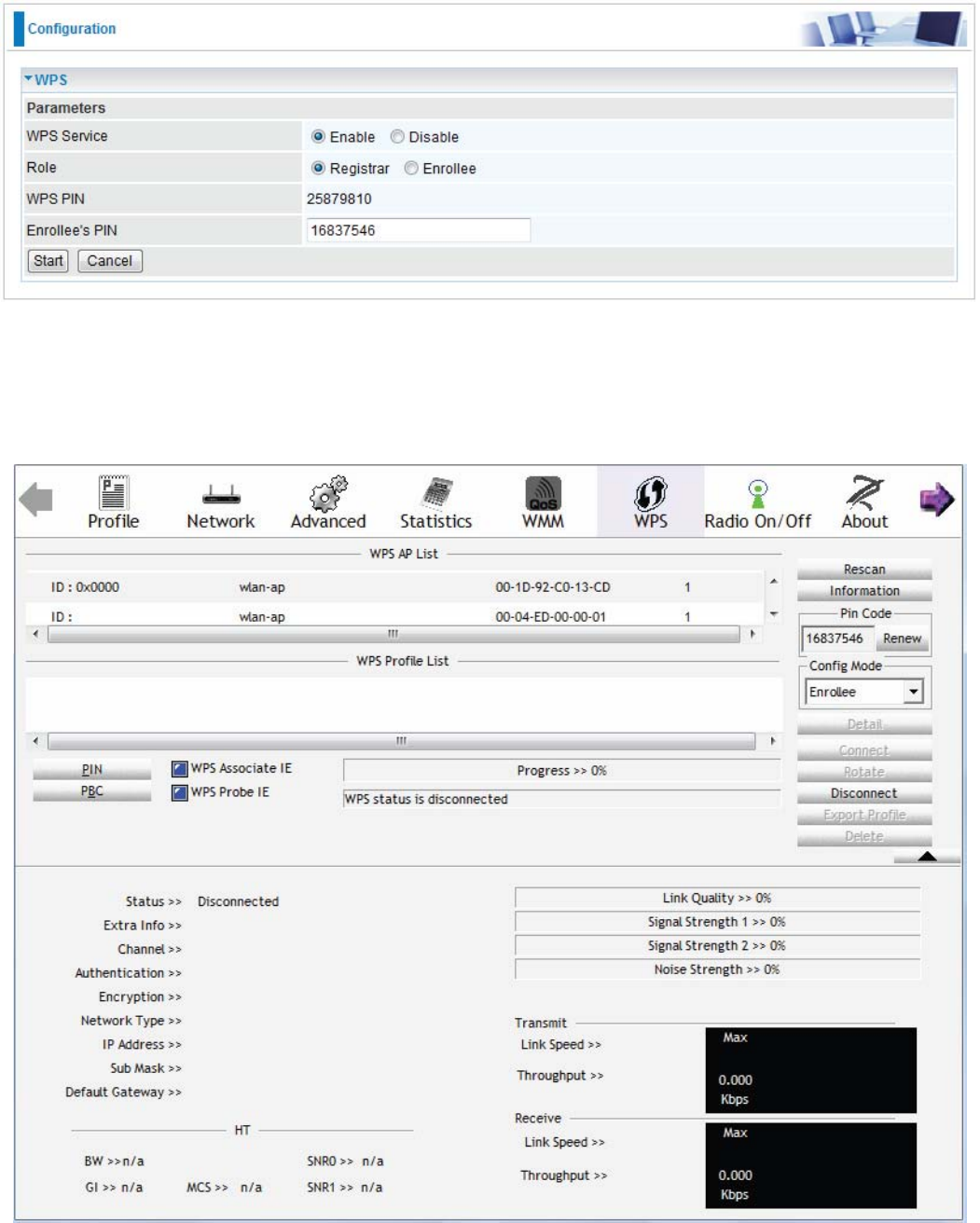
52
Wi-Fi Network Setup
PIN Method: Configure AP as Registrar
1. Jot down the client’s Pin (e.g. 16837546).
2. Enter the Enrollee’s PIN number and then press Start.
3. Launch the wireless client’s WPS utility (eg. Ralink Utility). Set the Configure Mode as Enrollee,
press the WPS button on the top bar, select the AP (eg. wlan-ap) from the WPS AP List column.Then
press the PIN button located on the middle left of the page to run the scan.
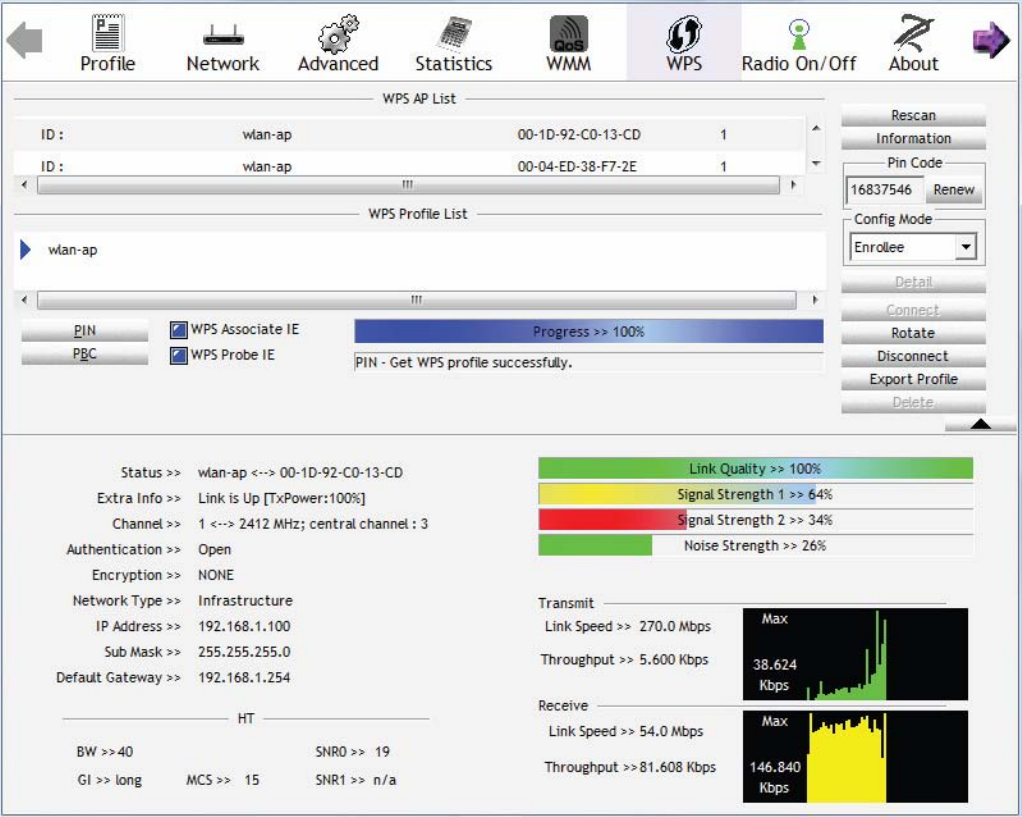
53
4. The client’s SSID and security setting will now be configured to match the SSID and security setting
of the registrar.
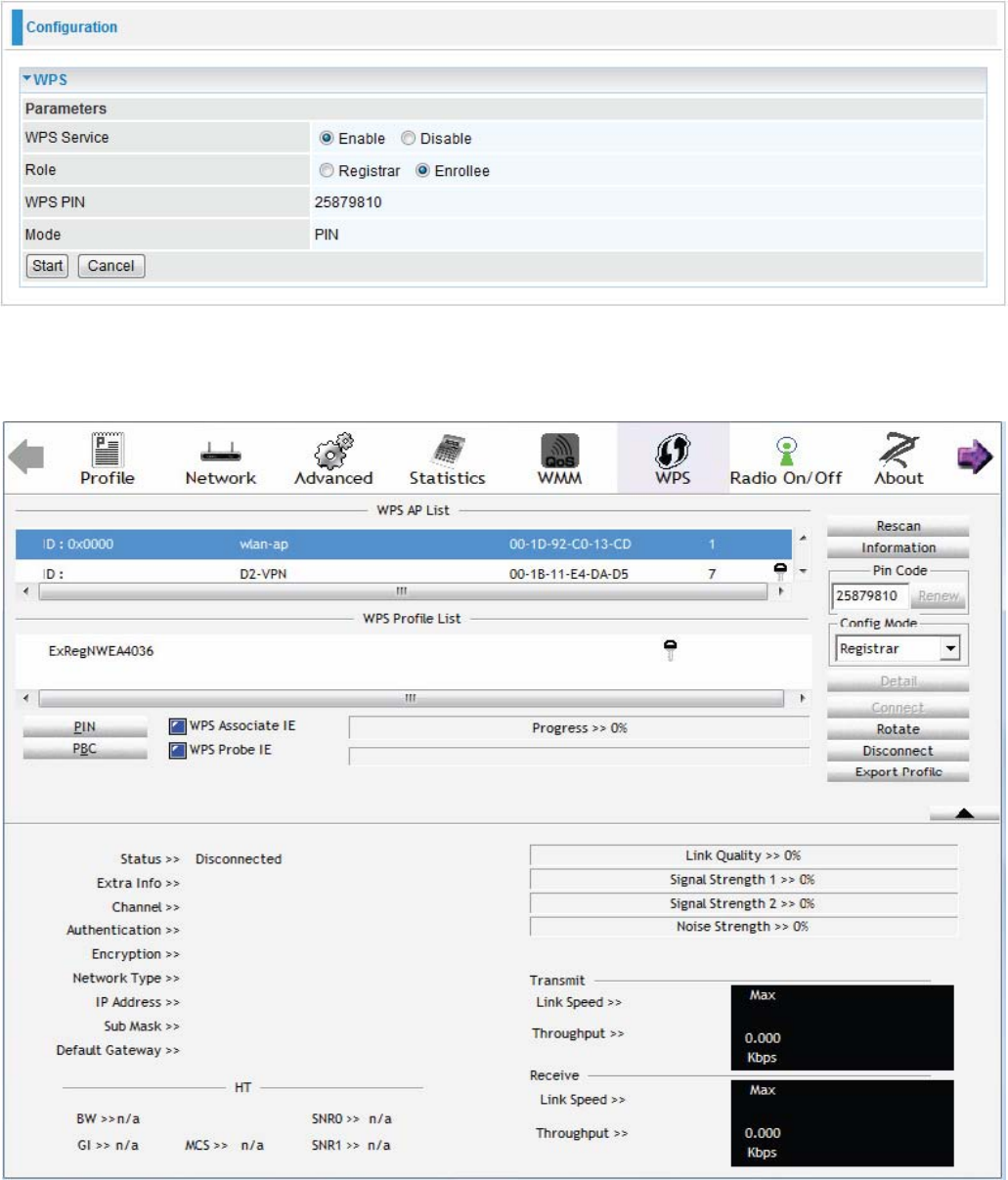
54
PIN Method: Configure AP as Enrollee
1. In the WPS configuration page, change the Role to Enrollee. Then press Start.
2. Jot down the WPS PIN (e.g. 25879810).
3. Launch the wireless client’s WPS utility (e.g. Ralink Utility). Set the Config Mode as Registrar. Enter
the PIN number in the PIN Code column then choose the correct AP (eg. wlan-ap) from the WPS AP
List section before pressing the PIN button to run the scan.
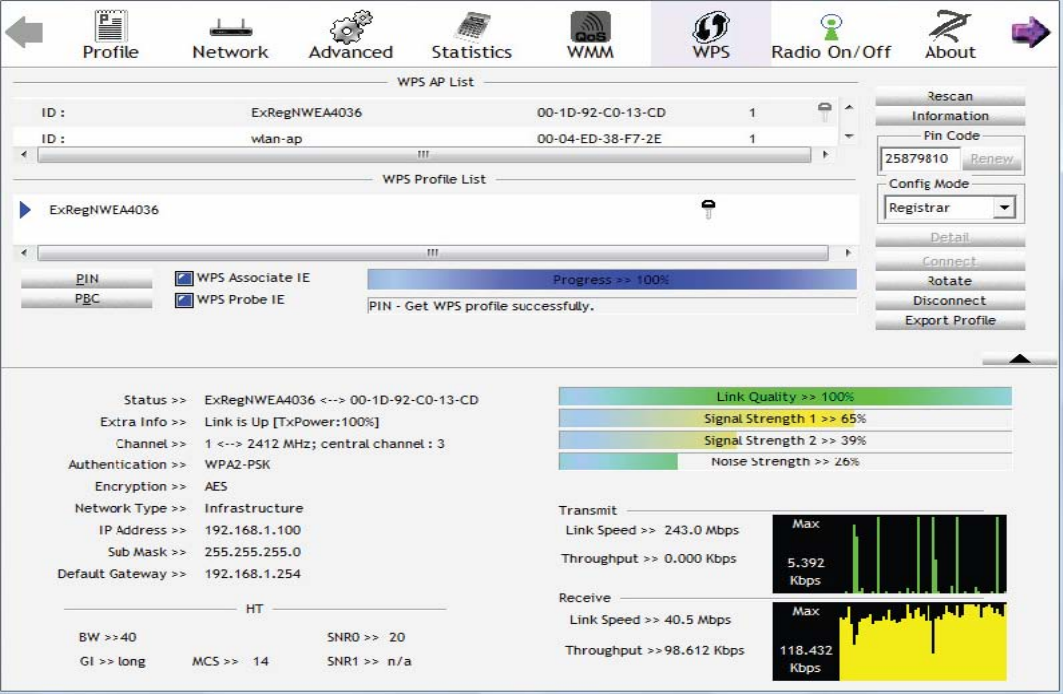
55
4. The router’s (AP’s) SSID and security setting will now be configured to match the SSID and security
setting of the registrar.
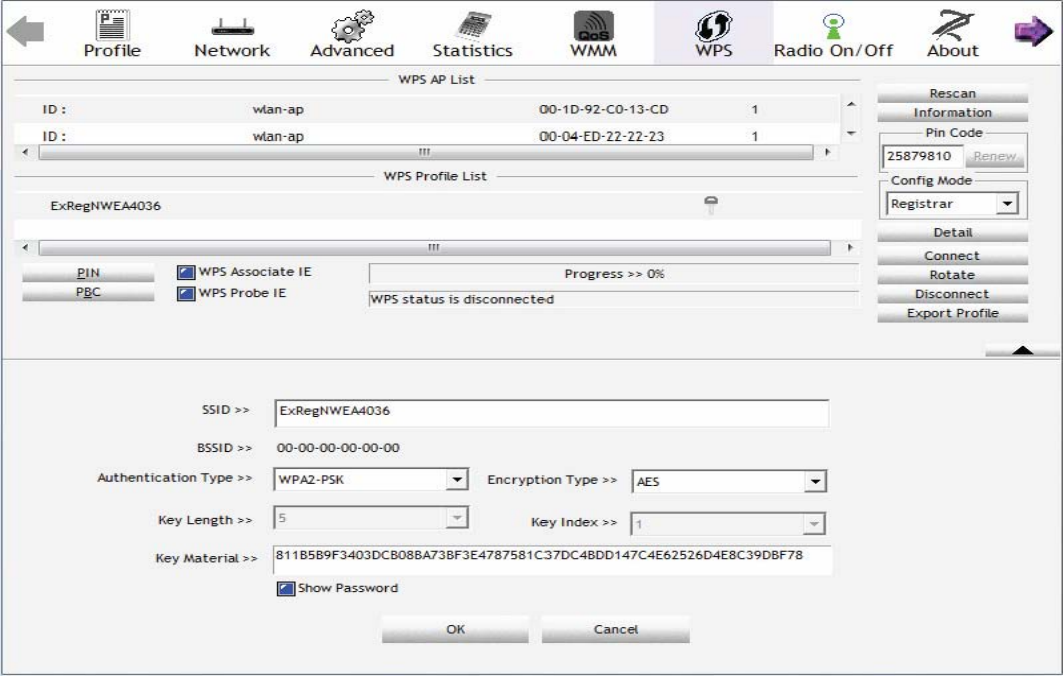
56
5. Now to make sure that the setup is correctly done, cross check to see if the SSID and the security
setting of the registrar setting match with the parameters found on both Wireless Configuration and
Wireless Security Configuration page.

57
the parameters on both Wireless Configuration and Wireless Security Configuration page are
as follows:
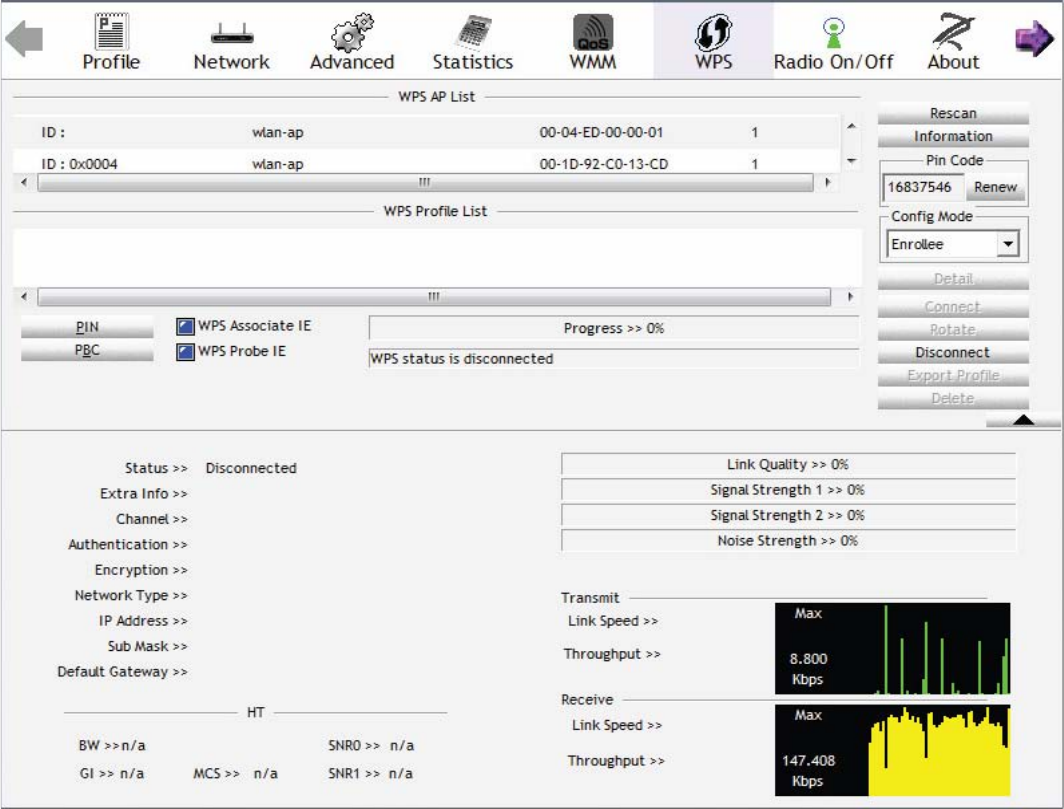
58
PBC Method:
1. Press the PBC button of the AP.
2. Launch the wireless client’s WPS Utility (eg. Ralink Utility). Set the Config Mode as Enrollee. Then
press the WPS button and choose the correct AP (eg. wlan-ap) from the WPS AP List section before
pressing the PBC button to run the scan.
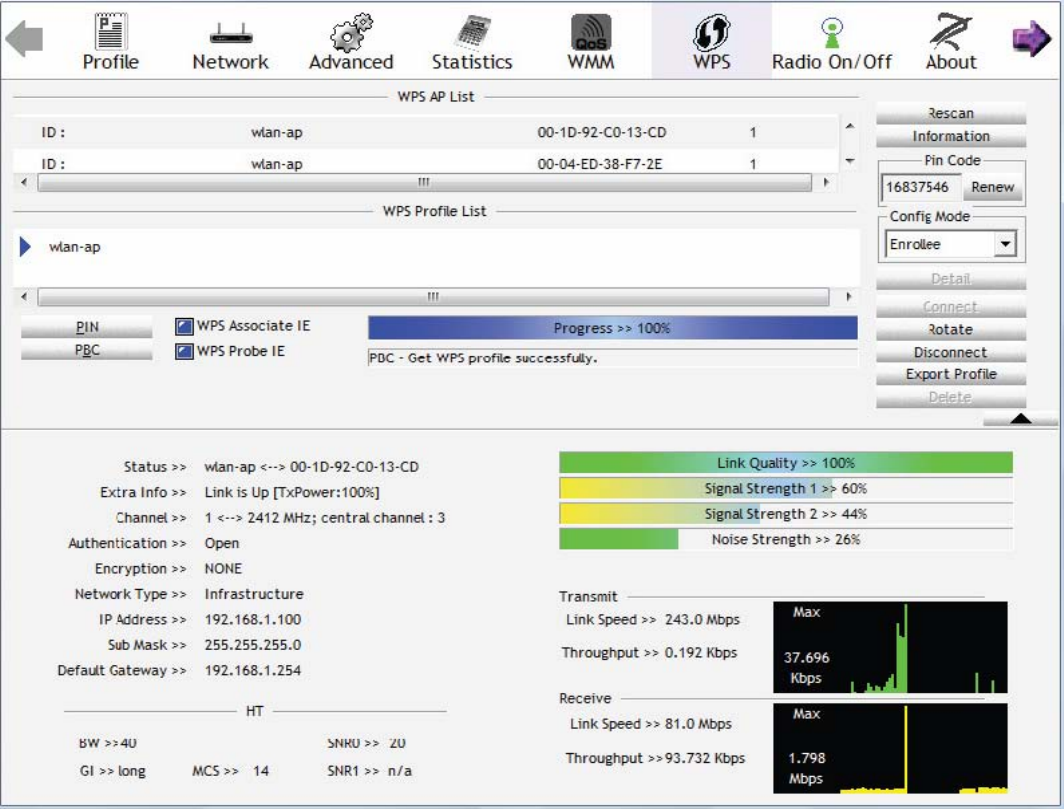
59
3. When the PBC button is pushed, a wireless communication will be established between your router
and the PC. The client’s SSID and security setting will now be configured to match the SSID and
security setting of the router.
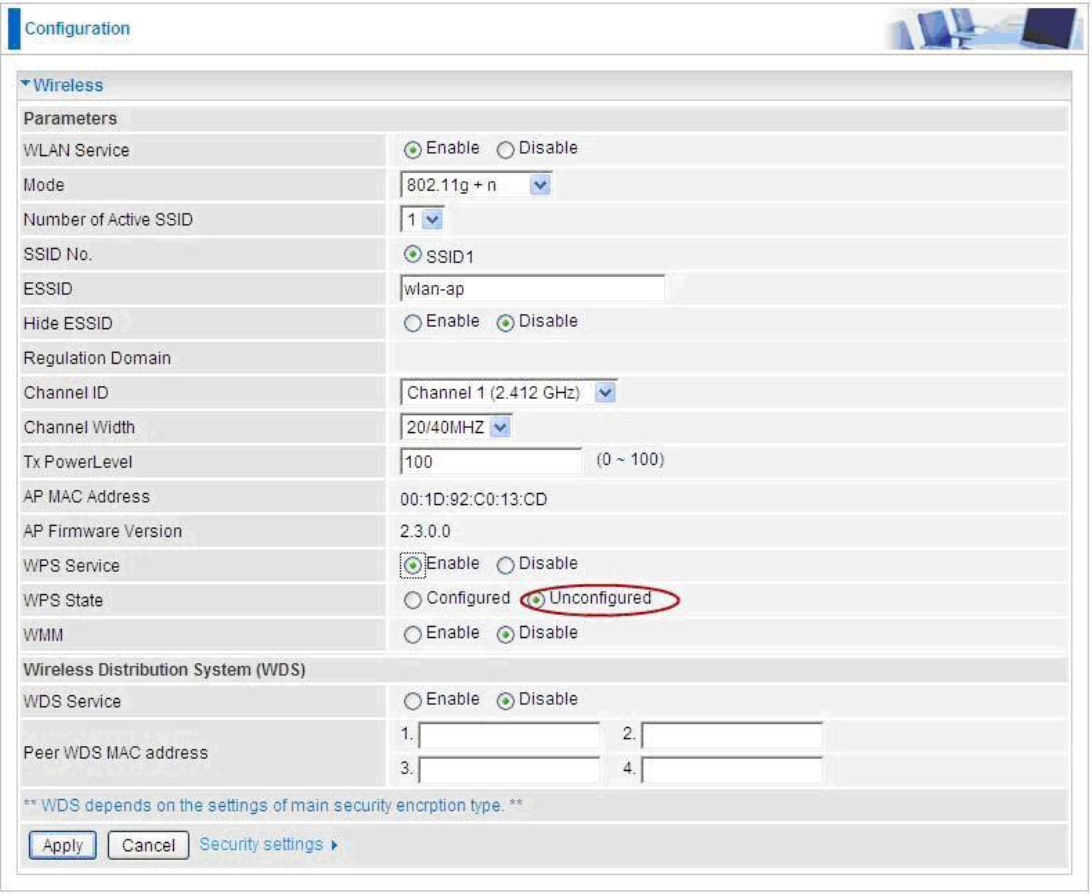
60
Wi-Fi Network Setup with Windows Vista WCN:
1. Jot down the AP PIN from the Web (eg. 25879810).
2.
Access
the
Wireless configuration
of the web GUI. Set the WPS
State
to
Uncon
f
igur
ed
then click
Apply.
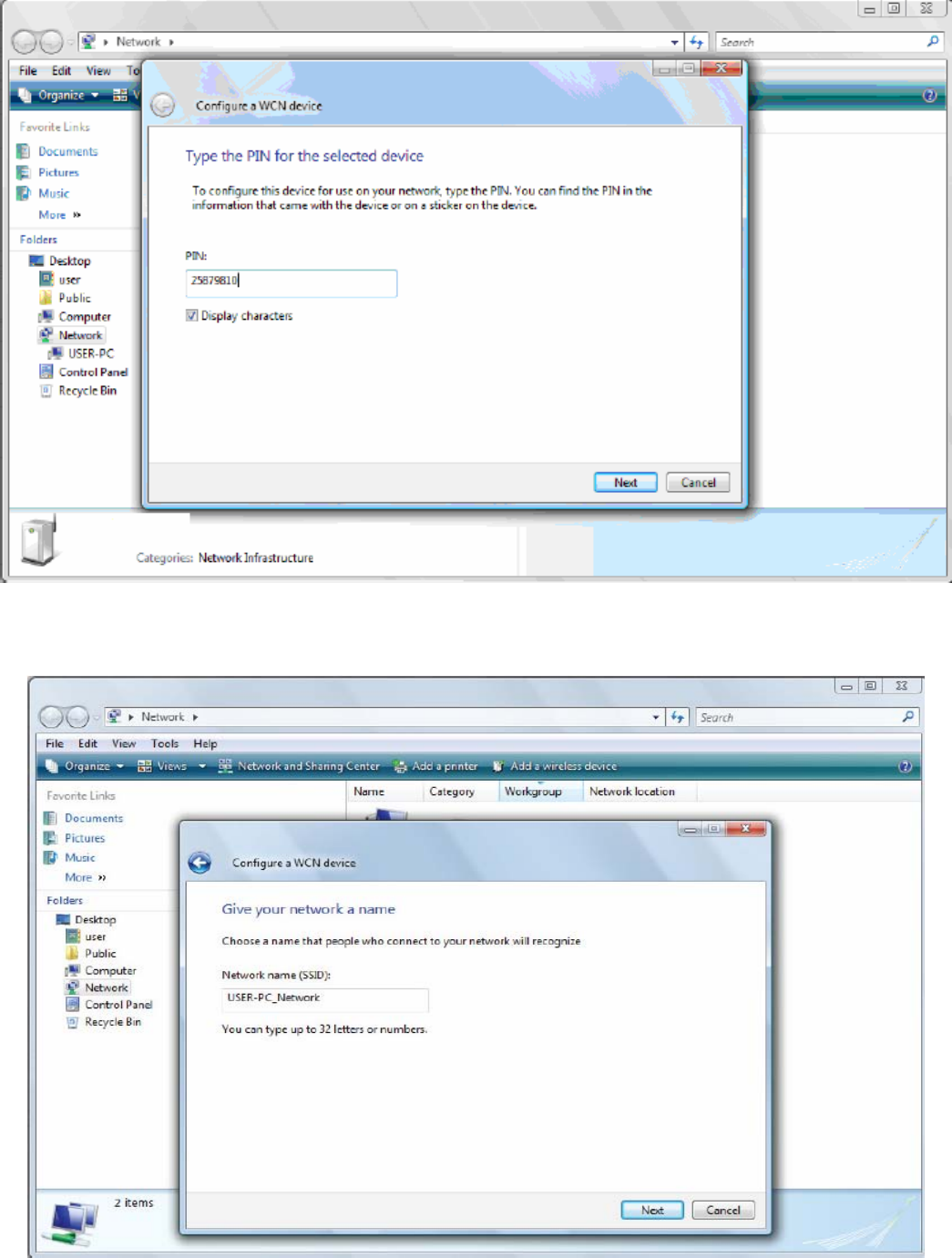
61
3. In your Vista operating system, access the Control Panel page, then select Network and Internet >
View Network Computers and Devices. Double click on the router icon and enter the AP PIN in the
column provided then press Next.
4. Enter the AP SSID then click Next.
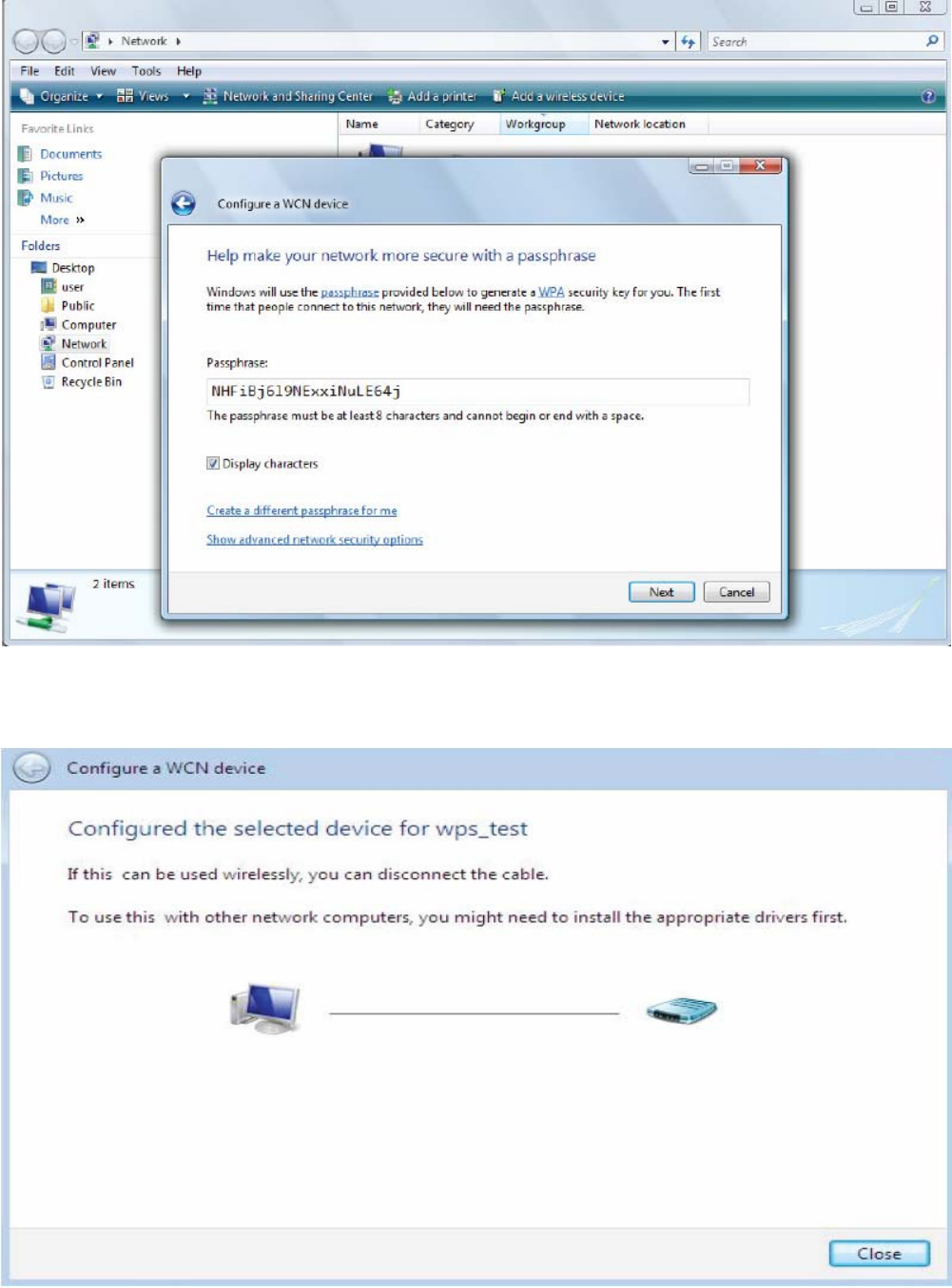
62
5. Enter the passphrase then click Next.
6. When you have come to this step, you will have completed the Wi-Fi network setup using the built-in
WCN feature in Windows Vista.
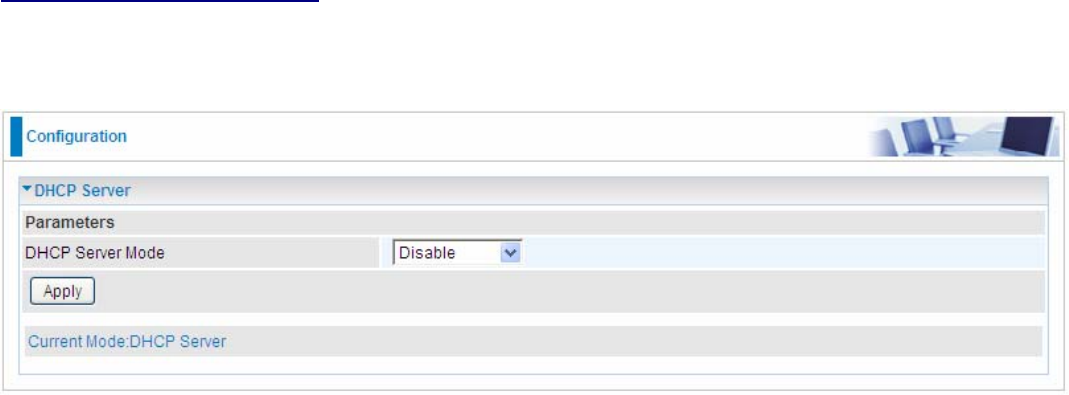
63
DHCP Server
You can disable or enable the DHCP (Dynamic Host Configuration Protocol) server or enable the
router’s DHCP relay functions. The DHCP protocol allows your router to dynamically assign IP
addresses to PCs on your network if they are configured to obtain IP addresses automatically.
DHCP Server Mode: Disable
To disable the router’s DHCP Server, check Disabled and then click Apply. When the DHCP Server is
disabled, you will need to manually assign a fixed IP address to each PC on your network, and set the
default gateway for each PC to the IP address of the router (the default is 192.168.1.254).
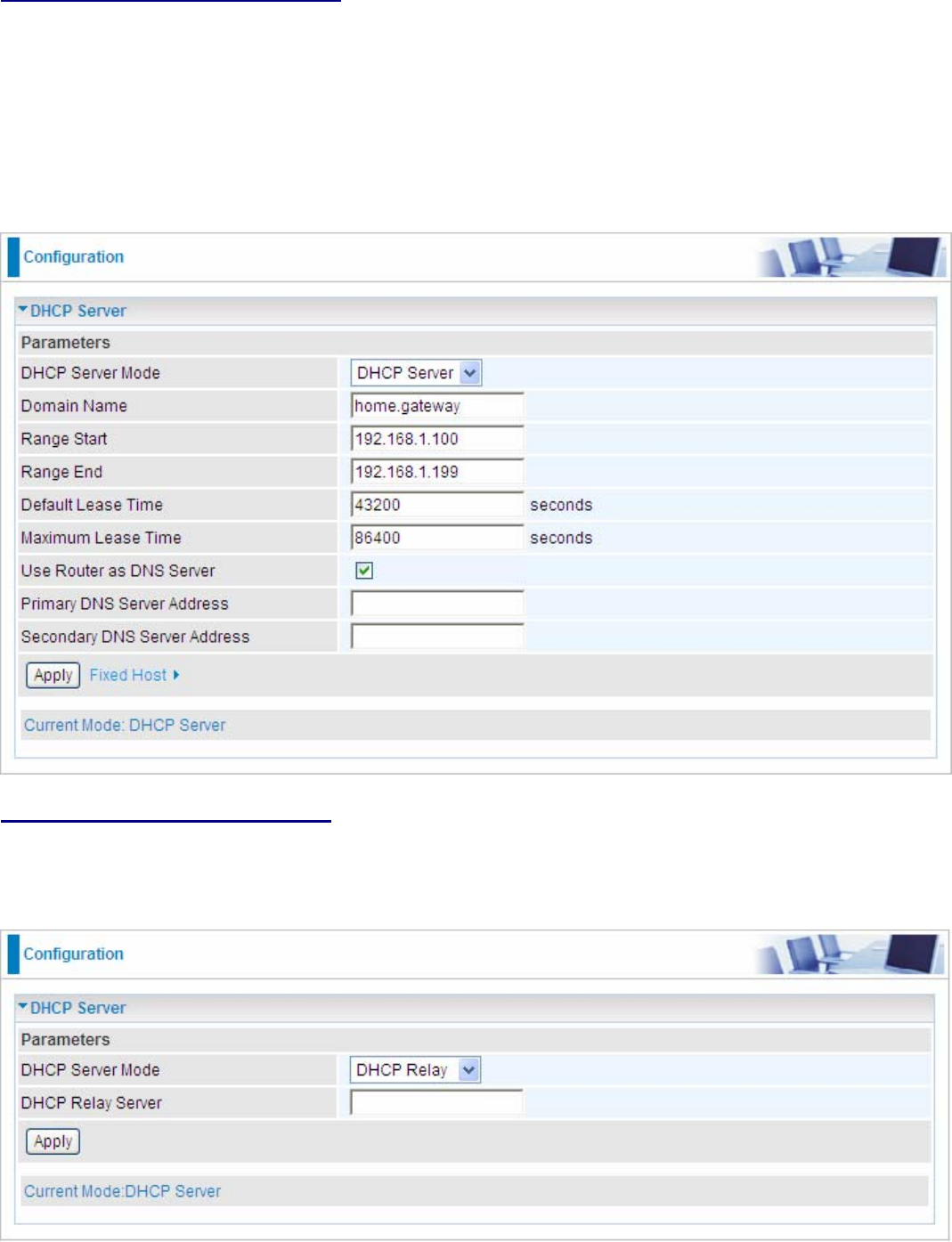
64
DHCP Server Mode: DHCP Server
To configure the router’s DHCP Server, check DHCP Server. You can then configure parameters of
the DHCP Server including the IP pool (starting IP address and ending IP address to be allocated to
PCs on your network), lease time for each assigned IP address (the period of time the IP address
assigned will be valid), DNS IP address and the gateway IP address. These details are sent to the
DHCP client (i.e. your PC) when it requests an IP address from the DHCP server. Click Apply to
enable this function. If you check “Use Router as a DNS Server”, the 3G Router performs the domain
name lookup, finds the IP address from the outside network automatically and forwards it back to the
requesting PC in the LAN (your Local Area Network).
DHCP Server Mode: DHCP Relay
If you check DHCP Relay and then you must enter the IP address of the DHCP server which assigns
an IP address back to the DHCP client in the LAN. Use this function only if advised to do so by your
network administrator or ISP. Click Apply to enable this function.
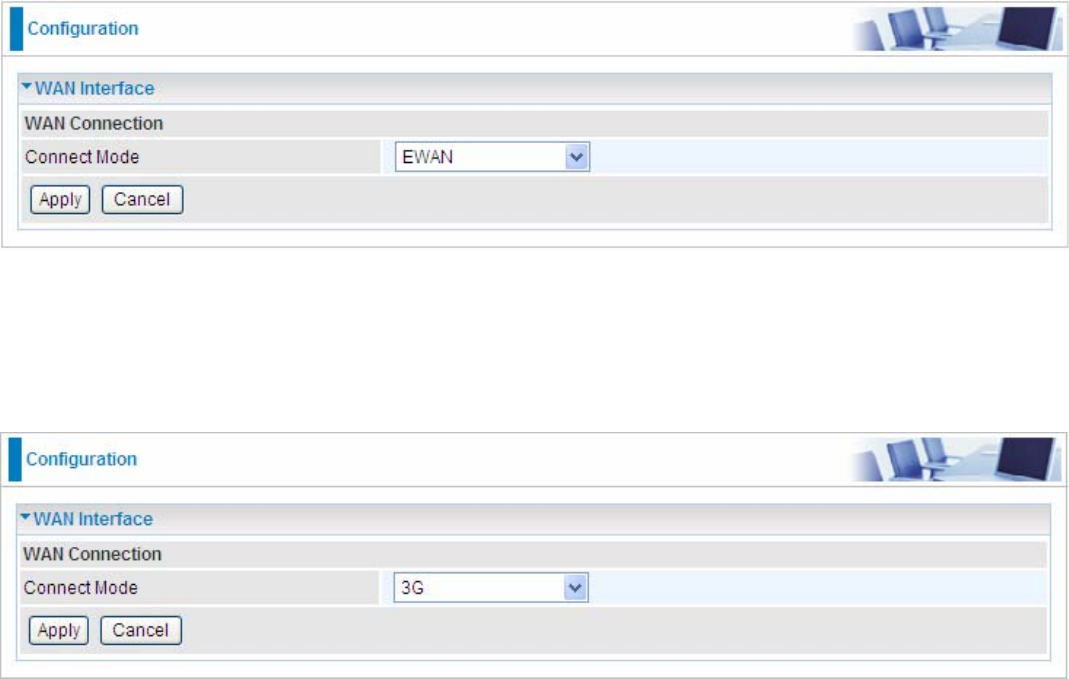
65
WAN (Wide Area Network)
A WAN (Wide Area Network) is an outside connection to another network or the Internet. There are
two items within the WAN section: WAN interface and WAN Profile.
WAN Interface(EWAN)
Connect Mode: Select the main port from the drop-down menu.
Click Apply to confirm the change.
WAN Interface(3G)
Connect Mode: Select the main port from the drop-down menu.
Click Apply to confirm the change.
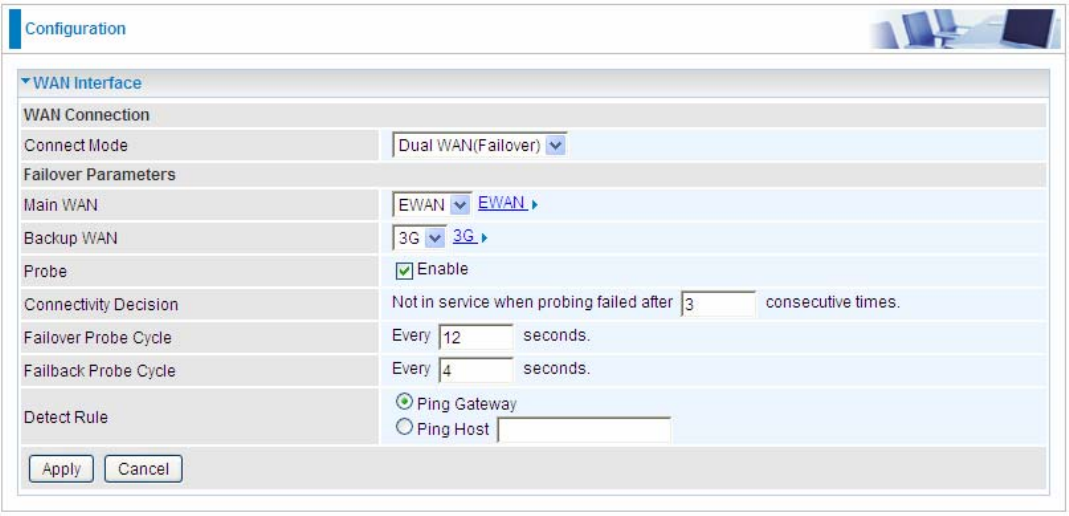
66
WAN Interface(Dual WAN)
Connect Mode: Select the Dual WAN from the drop-down menu.
Main WAN: Choose EWAN or 3G as main WAN. Click the link to go to WAN Profile page to configure
its parameters.
Backup WAN: Choose the left as backup WAN. Click the link to go to WAN Profile page to configure its
parameters.
Connectivity Decision: Enter the value for the times when probing failed to switch backup port.
Failover Probe Cycle: Set the time duration for the Failover Probe Cycle to determine when the
router will switch to the backup connection (backup port) once the main connection (main port) fails.
Note: The time values entered in Failover Probe Cycle field is set for each probe cycle and
decided by Probe Cycle duration multiplied by Connection Decision value (e.g. 60 seconds are
multiplied by 12 seconds and 5 consecutive fails).
Faiback Probe Cycle: Set the time for the Faiback Probe Cycle.
Detect Rule (either one):
• Ping Gateway: It will send ping packet to gateway and wait response from gateway in every “Probe
Cycle”.
• Ping Host: It will send ping packet to specific host and wait response in every “Probe Cycle”.
The host must be an IP address.
Click Apply to confirm the change.
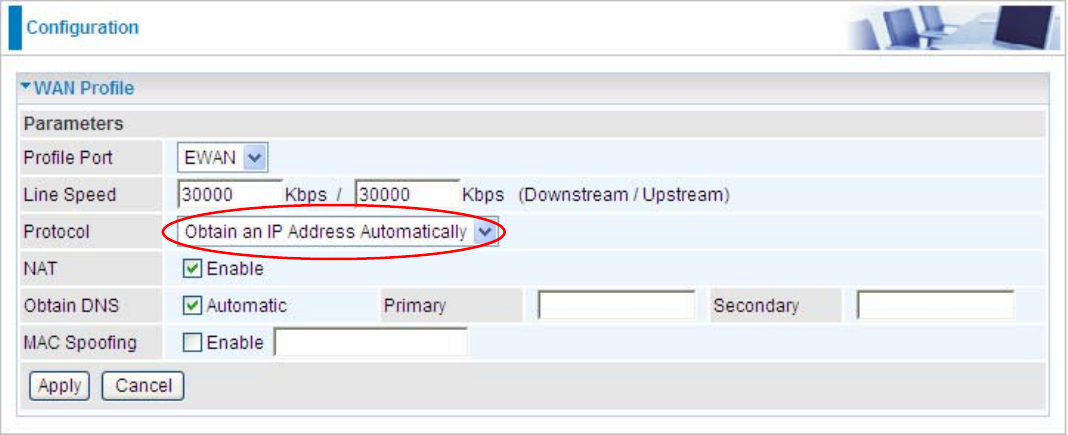
67
WAN Profile
Main Port – EWAN
BiPAC 6200NXL offers a WAN port to connect to Cable Modems and fiber optic lines. This alternative,
yet faster method to connect to the internet will provide users with more flexibility to get online.
Obtain an IP Address Automatically (EWAN)
When connecting to the ISP, BiPAC 6200NXL also functions as a DHCP client. BiPAC 6200NXL can
automatically obtain an IP address, Netmask, gateway address, and DNS server addresses if the ISP
assigns this information via DHCP.
Line Speed: Set the downstream and upstream of your connection in kilobytes per second. The
connection speed is used by QoS settings.
NAT: The NAT (Network Address Translation) feature allows multiple users to access the Internet
through a single ISP account, sharing a single IP address. If users on your LAN have public IP
addresses and can access the Internet directly, the NAT function can be disabled.
Obtain DNS Automatically: Select this check box to use DNS.
Primary DNS/ Secondary DNS: Enter the IP addresses of the DNS servers. The DNS servers are
passed to the DHCP clients along with the IP address and the netmask.
MAC Spoofing: Select Enable and enter a MAC address that will temporarily change your router’s
MAC address to the one you have specified in this field. Leave it as Disabled if you do not wish to
change the MAC address of your router.
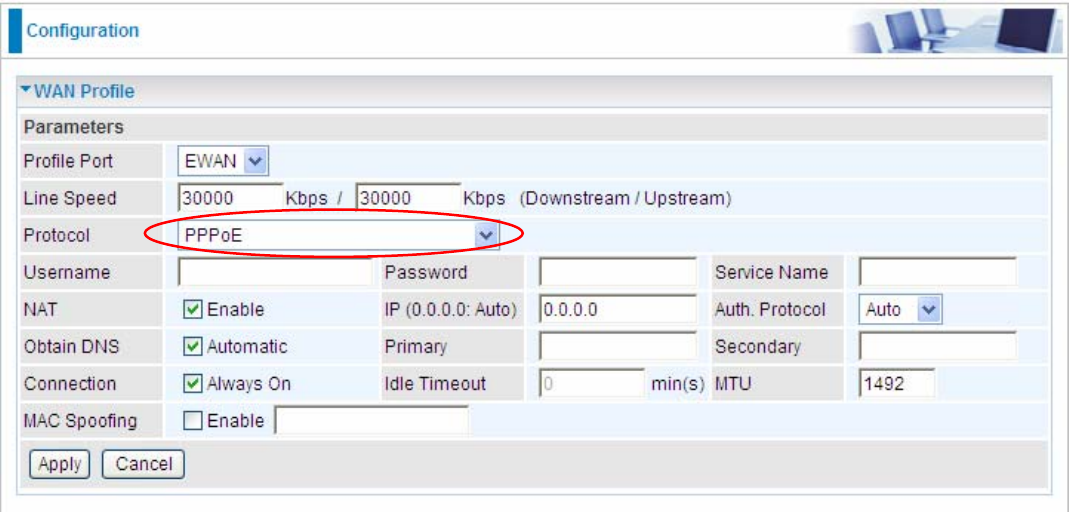
68
PPPoE (EWAN)
PPPoE (PPP over Ethernet) provides access control in a manner similar to dial-up services using PPP.
Username: Enter the username provided by your ISP. You can input up to 128 alphanumeric
characters (case sensitive). This is in the format of “username@ispname” instead of simply
“username”.
Password: Enter the password provided by your ISP. You can input up to 128 alphanumeric
characters (case sensitive)
Service Name: This item is for identification purposes. If it is required, your ISP provides you the
information. Maximum input is 15 alphanumeric characters.
NAT: The NAT (Network Address Translation) feature allows multiple users to access the Internet
through a single ISP account, sharing a single IP address. If users on your LAN have public IP
addresses and can access the Internet directly, the NAT function can be disabled.
IP Address: Your WAN IP address. Leave this at 0.0.0.0 to automatically obtain an IP address from
your ISP.
Auth. Protocol: Default is Auto. Your ISP advises on using Chap or Pap.
Obtain DNS Automatically: Select this check box to use DNS.
Primary DNS/ Secondary DNS: Enter the IP addresses of the DNS servers. The DNS servers are
passed to the DHCP clients along with the IP address and the Netmask.
Connection:
~ Always on: If you want the router to establish a PPPoE session when starting up and to
automatically re-establish the PPPoE session when disconnected by the ISP.
~ Connect to Demand (un-select Always On): If you want to establish a PPPoE session only
when there is a packet requesting access to the Internet (i.e. when a program on your computer
attempts to access the Internet). In this mode, you must set Idle Timeout value at same time.
Idle Timeout: Auto-disconnect the broadband firewall gateway when there is no activity on the line for
a predetermined period of time. The minimum value is 10 minutes.
MTU: Maximum Transmission Unit. The size of the largest datagram (excluding media-specific
headers) an IP attempts to send through the interface.
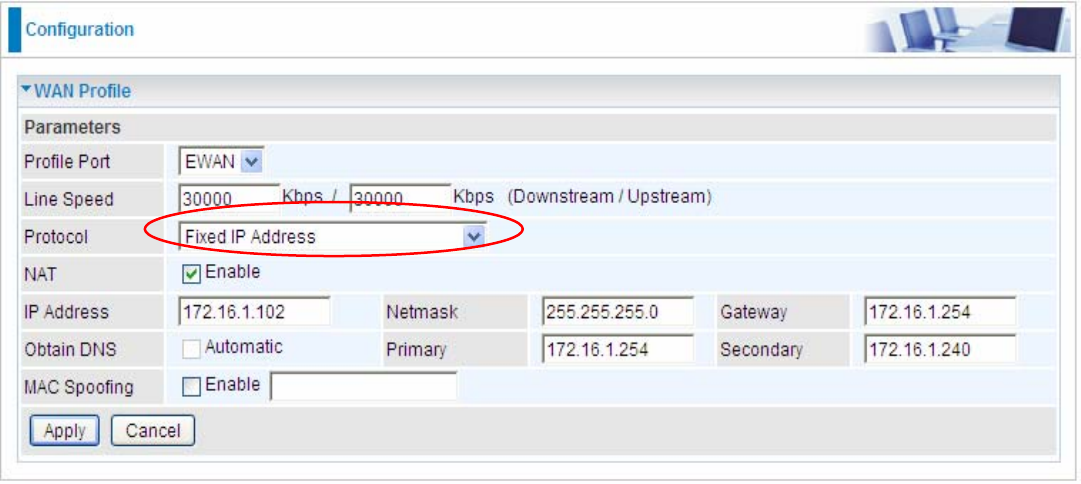
69
Fixed IP Address (EWAN)
Select this option to set static IP information. You will need to enter in the Connection type, IP address,
netmask, and gateway address, provided to you by your ISP. Each IP address entered in the fields
must be in the appropriate IP form, which is four IP octets separated by a dot (x.x.x.x). The Router will
not accept the IP address if it is not in this format.
Line Speed: Set the downstream and upstream of your connection in kilobytes per second. The
connection speed is used by QoS settings.
NAT: The NAT (Network Address Translation) feature allows multiple users to access the Internet
through a single IP account, sharing a single IP address. If users on your LAN have public IP
addresses and can access the Internet directly, the NAT function can be disabled.
IP Address: Your WAN IP address. Leave this at 0.0.0.0 to automatically obtain an IP address from
your ISP.
IP Netmask: The default is 0.0.0.0. User can change it to other such as 255.255.255.0.Type the
netmask assigned to you by your ISP (if given).
Gateway: You must specify a gateway IP address (supplied by your ISP)
Obtain DNS Automatically: Select this check box to use DNS.
Primary DNS/ Secondary DNS: Enter the IP addresses of the DNS servers. The DNS servers are
passed to the DHCP clients along with the IP address and the netmask.
MAC Spoofing: Select Enable and enter a MAC address that will temporarily change your router’s
MAC address to the one you have specified in this field. Leave it as Disabled if you do not wish to
change the MAC address of your router.
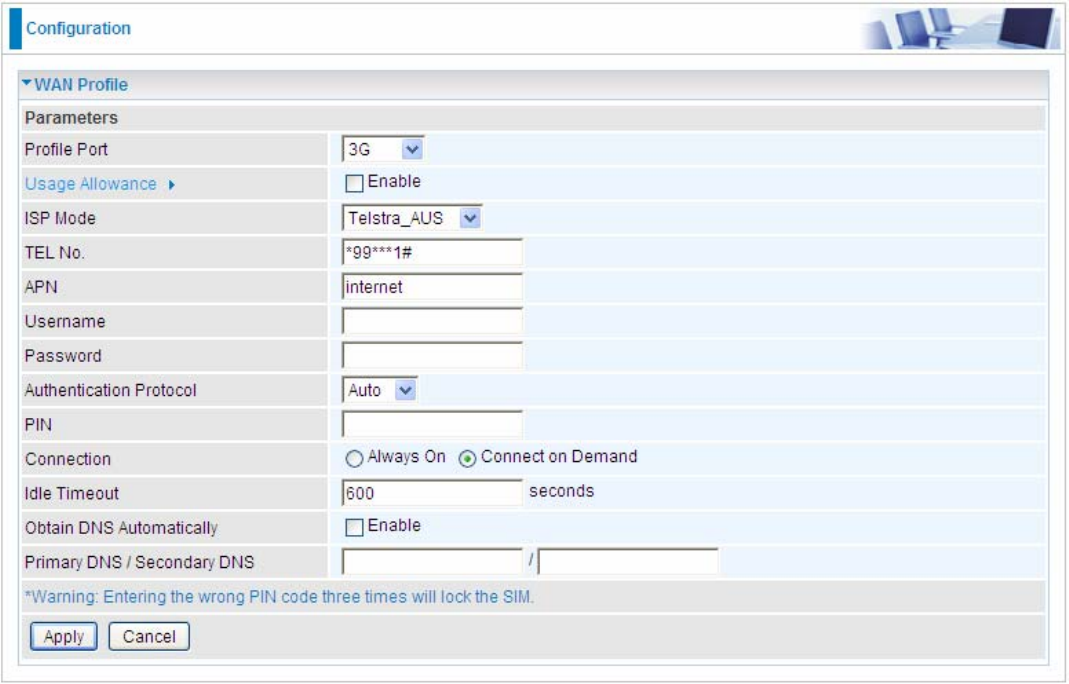
70
Main Port - 3G
The router allows you to insert a 3G/HSDPA card to its USB slot, enabling you to use a 3G/ HSDPA,
UMTS, EDGE, GPRS, or GSM Internet connection, makes downstream rates of to 14.4 Mbps*.
ISP Mode: Choose 3G service provider.
TEL No.: The dial string to make a GPRS / 3G user internetworking call. It may be provided by your
mobile service provider.
APN: An APN is similar to a URL on the WWW, it is what the unit makes a GPRS / UMTS call. The
service provider is able to attach anything to an APN to create a data connection. Requirements for
APN assignment varies between different service providers. Most service providers have an internet
portal which they connect a DHCP Server to, giving you access to the internet i.e. Some 3G operators
use the APN ‘internet’ for their portal. The default value of APN is “internet”.
Username: Enter the username provided by your service provider.
Password: Enter the password provided by your service provider.
Auth. Protocol: Manually specify CHAP (Challenge Handshake Authentication Protocol) or PAP
(Password Authentication Protocol) if you know which authentication type the server is using (when
acting as a client), or the authentication type you want the clients to use when tehy are connecting to
you (when acting as a server). When using PAP, the password is sent unencrypted, while CHAP
encrypts the password before sending, and also allows for challenges at different periods to ensure
that an intruder has not replaced the client.
MTU: Maximum Transmission Unit. The size of the largest datagram (excluding media-specific
headers) that IP will attempt to send through the interface.

71
PIN: PIN stands for Personal Identification Number. A PIN code is a numeric value used in certain
systems as a password to gain access, and authentication. In mobile phones a PIN code locks the
SIM card until you enter the correct code. If you enter the PIN code incorrectly into the phone 3 times
in a row, then the SIM card will be blocked and a PUK code will be required from your network / service
provider to unlock it.
Note: If you enter an incorrect PIN code three times in a row, your SIM card will be blocked. In this
case, please enter your PUK code (it can be supplied by your service provider) and then re-enter your
PIN.
Connection:
• Always On: The router will make UMTS/GPRS call when starting up. Enabling Always On,
will give you an option of Keep Alive.
• Connect on Demand: If you want to make UMTS/GPRS call only when there is a packet re-
questing access to the Internet (i.e. when a program on your computer attempts to access the
Internet). In this mode, you must set Idle Timeout value at same time. Enabling Connect on
Demand will give you an option of Idle Timeout.
Idle Timeout: Auto-disconnect the connection when there is no activity on this call for a
predetermined period of time. The default value is 10 seconds.
Obtain DNS Automatically: Select this checkbox to use DNS.
Primary DNS/ Secondary DNS: Enter the IP addresses of the DNS servers. The DNS servers are
passed to the DHCP clients along with the IP address and the subnet mask.
Note: If you don’t know how to set these values and please keep them untouched.
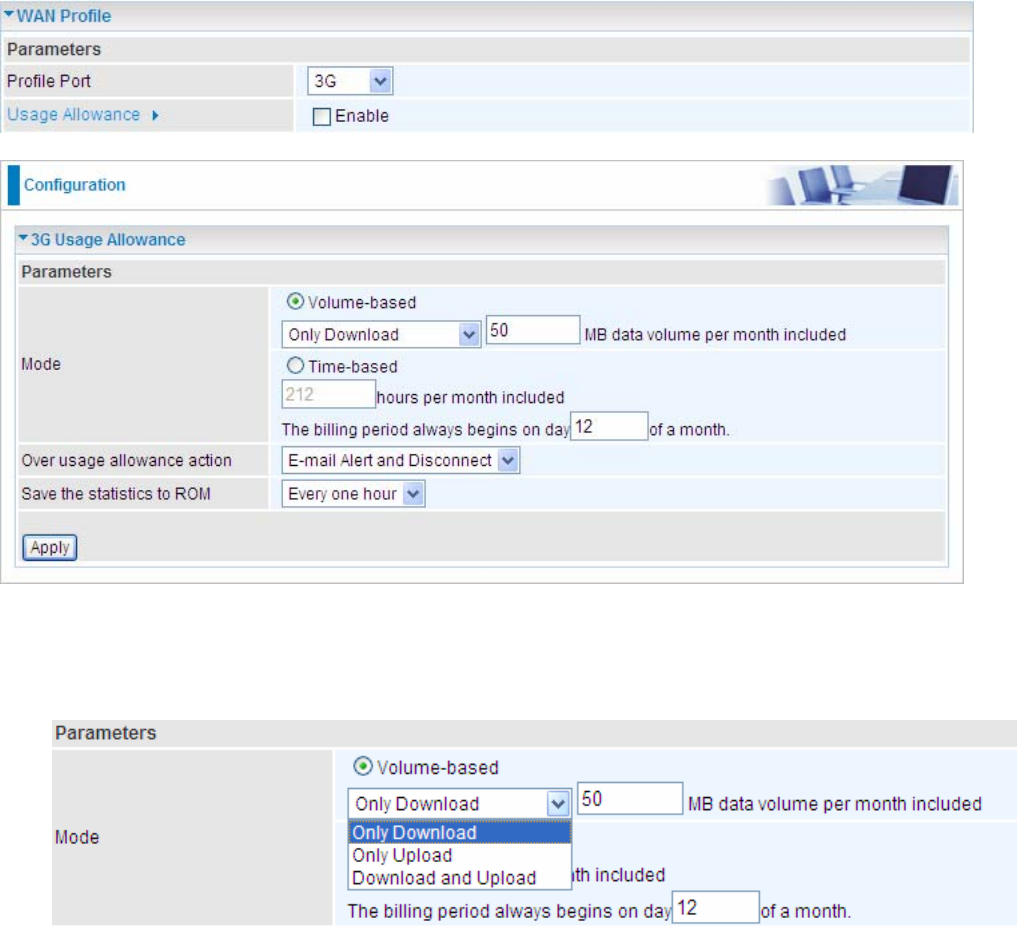
72
Click Usage Allowance to go to the Usage Allowance configuration page.
In order to query online time or volume used, you can set the following options.
Mode: Two methods are provided, that is, Volume-based and Time-based.
Volume-based: If choosing Volume-based, you can view the volume you have used.
Only Download: Only make statistics of Download Traffic.
Only Upload: Only make statistics of Upload Traffic.
Download and Upload: Make statistics of both Download and Upload Traffic.
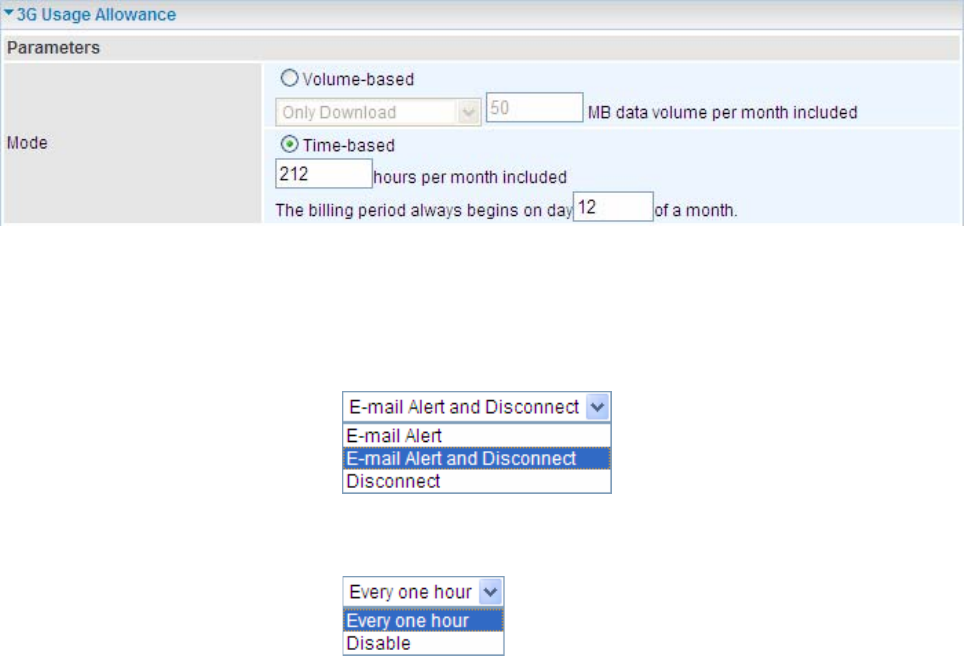
73
Time-based: If choosing Time-based, you can view the online hours you have used.
You can also assign the billing period.
Over usage allowance action: If the online time or traffic you have used exceeds the usage
allowance you set. The system will do the followings operations.
Save the statistics to ROM: Choose the time interval for saving statistics. You can choose to save for
Every one hour or Disable the function.
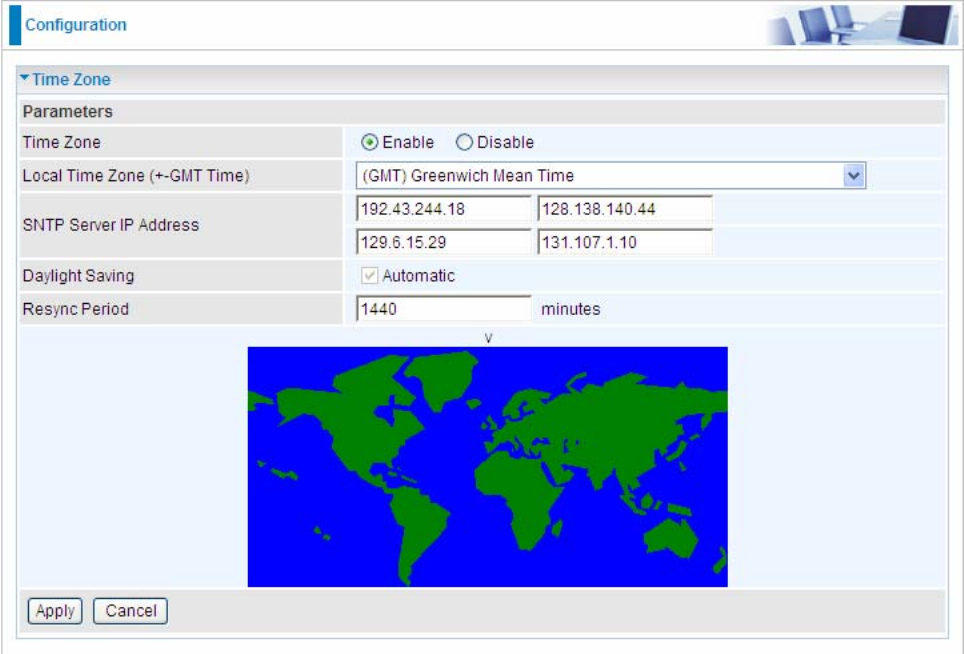
74
System
There are five items within the System section: Time Zone, Firmware Upgrade, Backup/Restore,
Restart, User Management and Mail Alert.
Time Zone
The router does not have a real time clock on board; instead, it uses the Simple Network Time Protocol
(SNTP) to get the current time from an SNTP server outside your network. Choose your local time
zone, click Enable and click the Apply button. After a successful connection to the Internet, the router
retrieves the correct local time from the SNTP server you have specified. If you prefer to specify an
SNTP server other than those in the drop-down list, simply enter its IP address as shown above. Your
ISP may provide an SNTP server for you to use.
Resync Period (in minutes) is the periodic interval the router waits before it resynchronizes the
router’s time with that of the specified SNTP server. To avoid unnecessarily increasing the load on
your specified SNTP server you should keep the poll interval as high as possible – at the absolute
minimum every few hours or even days.
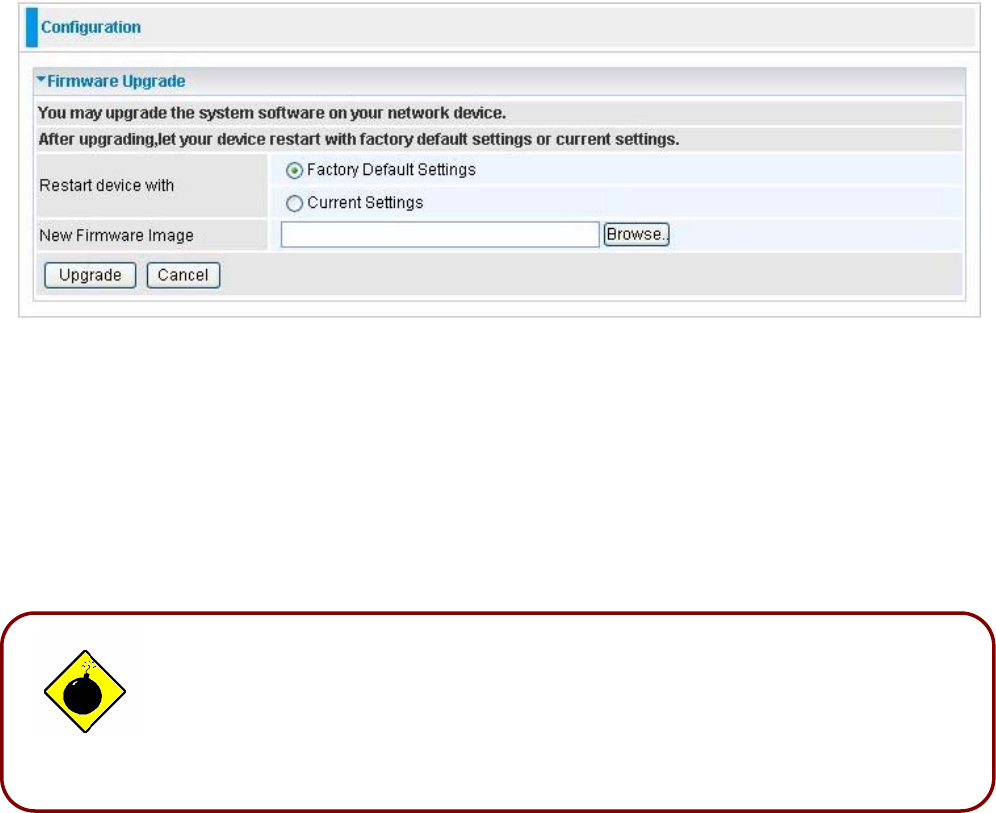
75
Do not power down the router or interrupt the firmware upgrade while it is
still in process. Improper operation may damage the router. Please see
section 2.4 for emergency recovery procedures.
Firmware Upgrade
Your router’s “firmware” is the software that allows it to operate and provides all its functionality. Think
of your router as a dedicated computer, and the firmware as the software it runs. Over time this
software may be improved and modified. Your router allows you to upgrade the software it runs to take
advantage of these changes.
Clicking on Browse allows you to select the new firmware image file you have downloaded to your PC.
Once the correct file is selected, click Upgrade to update the firmware in your router.
Restart Device with: To choose “Factory Default Settings” or “Current Settings” which uses your
current setting on the new firmware (it is highly advised to use Factory Default Settings over Current
Settings for a clean firmware upgrade).
New Firmware Image: Type in the location of the file you wish to upload in this field or click Browse…
to locate it.
Browse…: Click Browse… to find the file with the .afw file extension that you wish to upload.
Remember that you must decompress compressed (.zip) files before you can upgrade from the file.
Upgrade: Click upgrade to begin the upload process. This process may take up to three minutes.
Warning
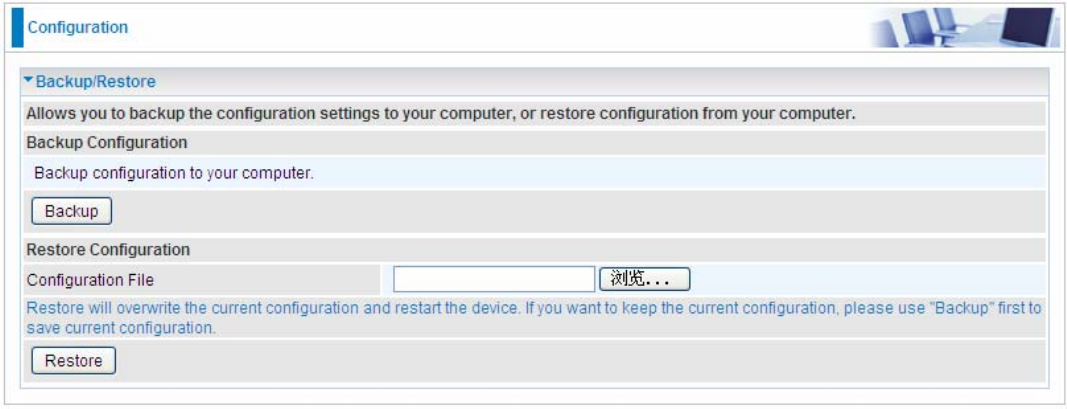
76
Backup / Restore
These functions allow you to save and backup your router’s current settings to a file on your PC, or to
restore a previously saved backup. This is useful if you wish to experiment with different settings,
knowing that you have a backup handy in the case of any mistakes. It is advisable to backup your
router’s settings before making any significant changes to your router’s configuration.
Press Backup to select where on your local PC to save the settings file. You may also change the
name of the file when saving if you wish to keep multiple backups.
Press Browse… to select a file from your PC to restore. You should only restore settings files that
have been generated by the Backup function, and that were created when using the current version
of the router’s firmware. Settings files saved to your PC should not be manually edited in any
way.
Select the settings files you wish to use, and press Restore to load those settings into the router.

77
Restart Router
Click Restart with option Current Settings to reboot your router and save the current configuration to
device.
If you wish to restart the router using the factory default settings (for example, after a firmware upgrade
or if you have saved an incorrect configuration), select Factory Default Settings to reset to factory
default settings.
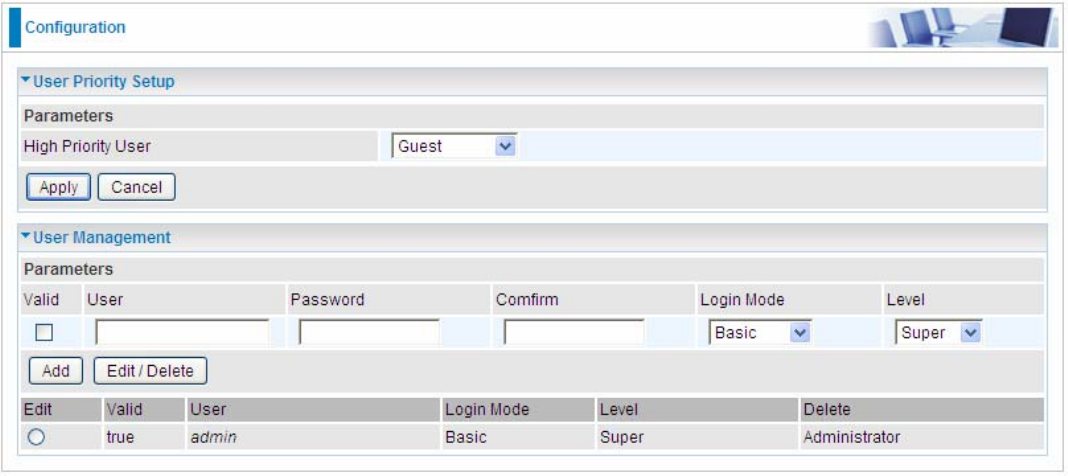
78
User Management
In order to prevent unauthorized access to your router’s configuration interface, it requires all users to
login with a password. You can set up multiple user accounts, each with their own password.
You are able to Edit existing users and Add new users who are able to access the device’s
configuration interface. Once you have clicked Edit on the account you want to edit, the information of
the account will be displayed above. Just go ahead and change the password.
You can change the user’s password, whether their account is active and Valid. These options are
the same when creating a user account, with the exception that once created you cannot change the
username. You cannot delete the default admin account; however you can delete any other created
accounts by clicking ticking the box under Delete and then press the Edit/Delete button.
You are strongly advised to change the password on the default “admin” account when you receive
your router, and any time you reset your configuration to Factory Defaults.
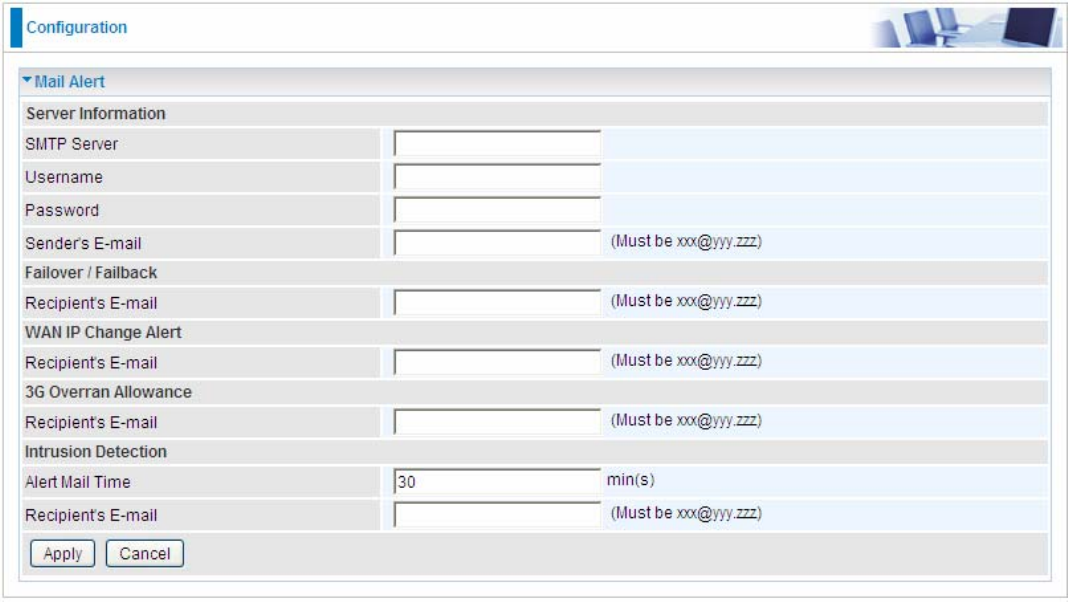
79
Mail Alert
Mail alert is designed to keep system administrator or other relevant personnel alerted of any
unexpected events that might have occurred to the network computers or server for monitoring
efficiency. With this alert system, appropriate solutions may be tackled to fix problems that may have
arisen so that the server can be properly maintained.
SMTP Server: Enter the SMTP server that you would like to use for sending emails.
Username: Enter the username of your email account to be used by the SMTP server.
Password: Enter the password of your email account.
Sender’s Email: Enter your email address.
Recipient’s Email (Failover / Failback): Enter the email address that will receive the alert message
once a computer / network server failover occurs.
Recipient’s Email (WAN IP Change Alert): Enter the email address that will receive the alert
message once a WAN IP change has been detected.
80
Recipient’s Email (3G Overran Allowance): Enter the email address that will receive the alert message
once 3G overran allowance was detected.
Alert Mail Time (Intrusion Detection): The time interval of sending Email.
Recipient’s Email (Intrusion Detection): Enter the email address that will receive the alert message
once intrusion has been detected.
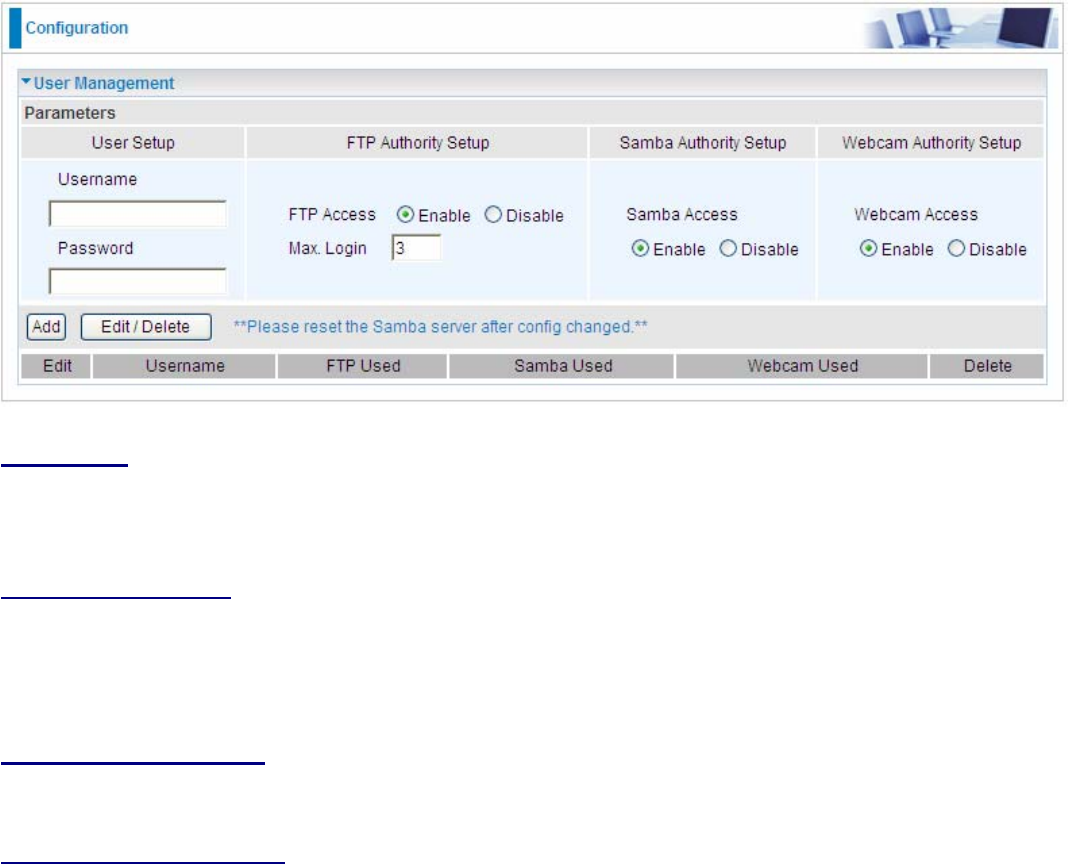
81
USB Server
Besides connecting to 3G modem, USB 2.0 port can also be connected to Printer, Webcam or HDD.
USB Server has integrated FTP Server, Printer Server and WebCam supervisory functions. Through
FTP Server, Samba Server user can management the account, set the authority of download and
upload. Printer server supports Internet Print Protocol, user can remote print.
There are five items within the USB section: User Management, Storage, Samba Server, FTP
Server, Printer Server and Webcam.
User Management
User Setup
Username: Enter the name for the account.
Password: Set the password for the account.
FTP Authority Setup
FTP Access: If you enable this function, this account has the access authority to FTP Server.
Max. Login: This option specifies the maximum number of users (both anonymous and
non-anonymous) that are allowed to be using the FTP server simultaneously.
Samba Authority Setup
Samba Access: If you enable this function, this account has the access authority to Samba Server.
Webcam Authority Setup
Webcam Access: If you enable this function, this account has the access authority to Webcam
Server.
Add: Click this button to add a new account and it will appear at the bottom table.
Edit/Delete: Choose one account which you wish to Edit/Delete, and then click “Edit/Delete”.
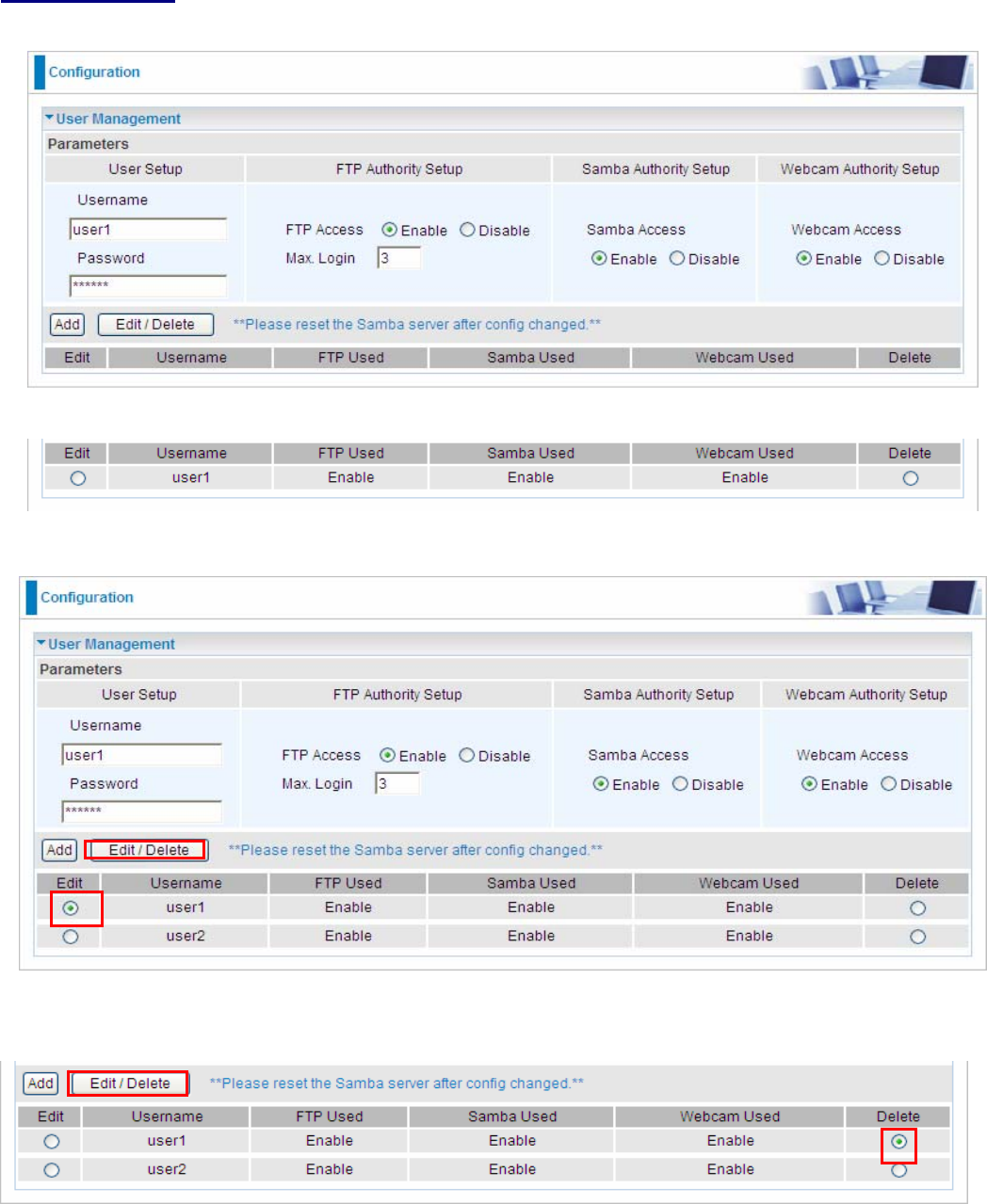
82
Add/Delete User
1. Enter username and password
2. Click Add. The new user account will display below.
3. Choose the account which you want to edit then you can change the account’s parameters, click
Edit/Delete to confirm changes.
4. Choose the account which you want to delete, click Edit/Delete to remove it.
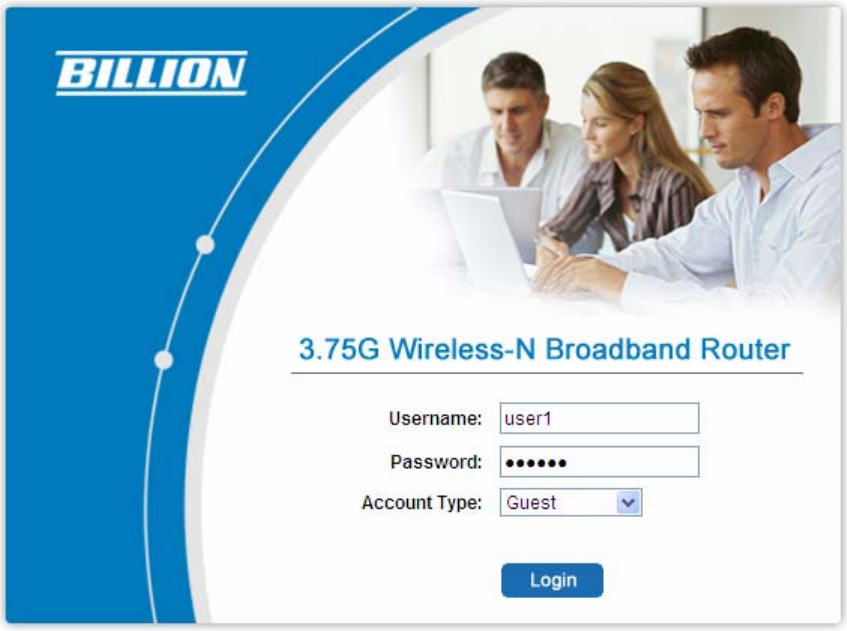
83
5. Access from web browser. Open your web browser, enter the IP address of your router, Enter the
user name and password that your administrator has set for you and select Guest from the
Account Type list, and then click Login.
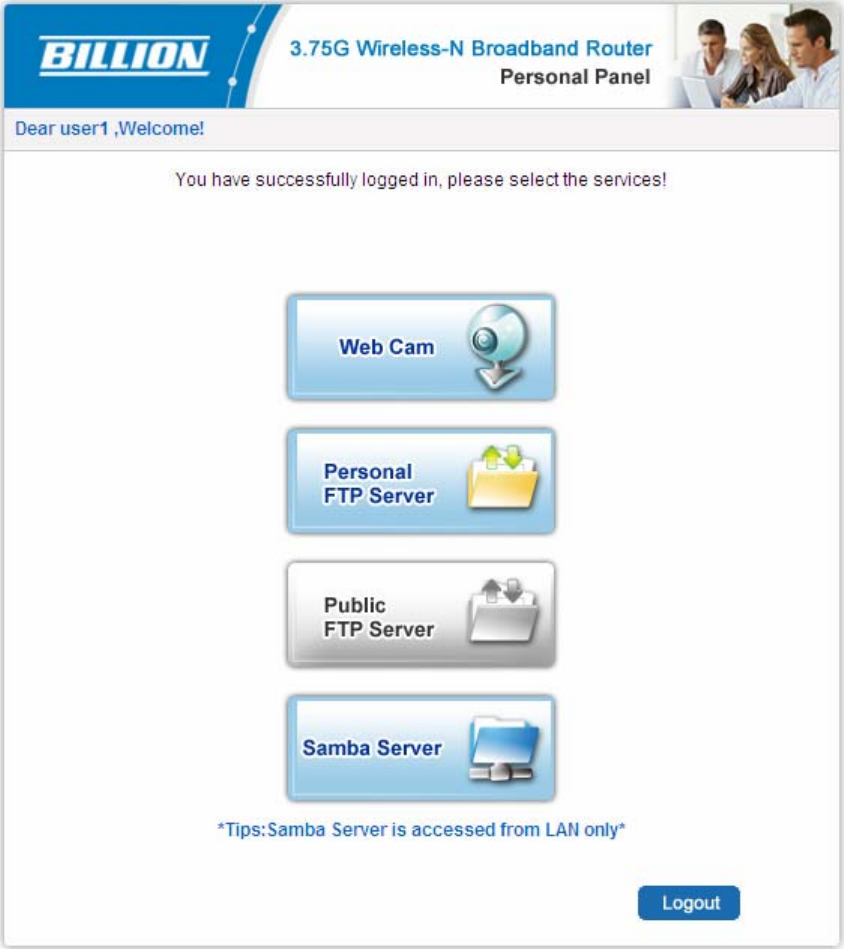
84
When you are authorised, you will access to the router.
Congratulations! You have successfully logged on.
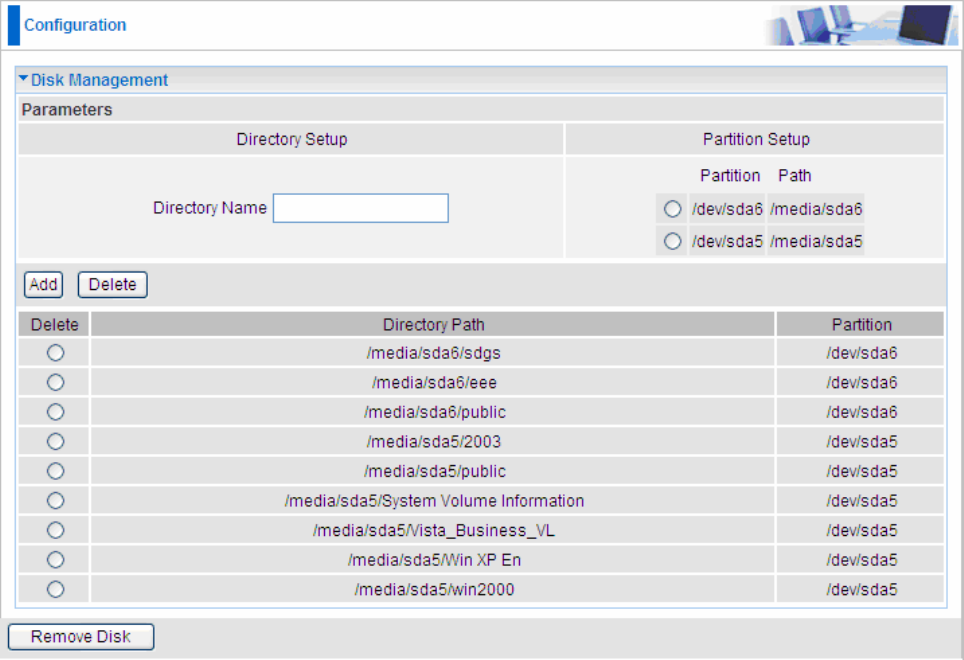
85
Storage
Storage page display the information of storage device which plugged in USB port, such as directory,
partition and so on. You can also setup the storage.
Directory Setup: Enter the directory name which you wish to create in the Directory Name field.
Partition Setup: Choose the partition of disk which you want to edit.
Remove Disk: Click this button to remove the disk which you choose in Partition Path.
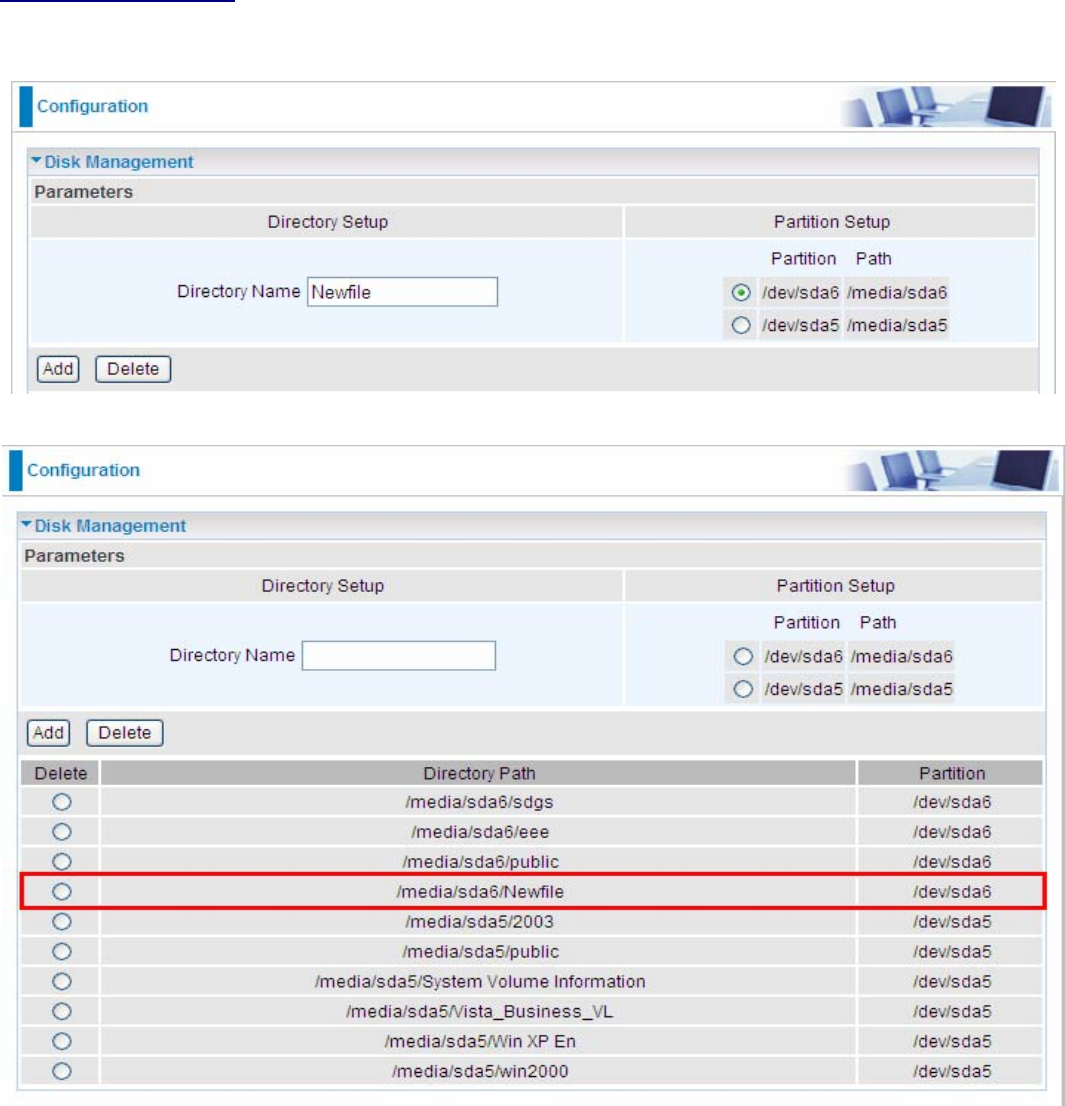
86
Add/Delete directory
1. Enter directory name in the directory name field and choose partition path which the directory will
located.
2. Click Add. The New directory will display below.
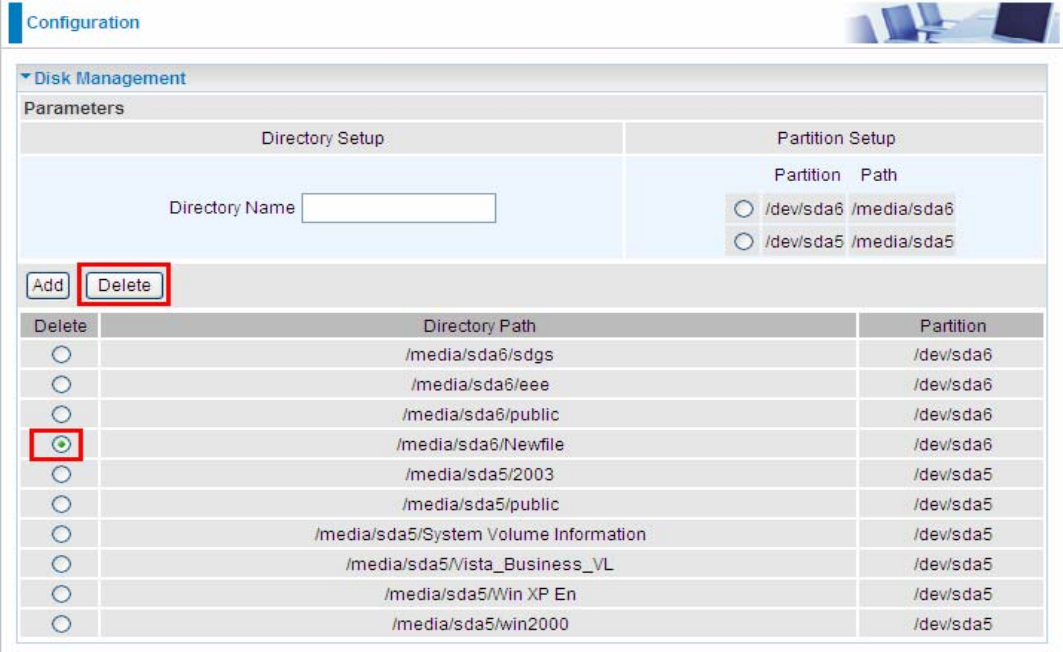
87
3. Choose the directory which you want to delete then click Delete to romove this directory.
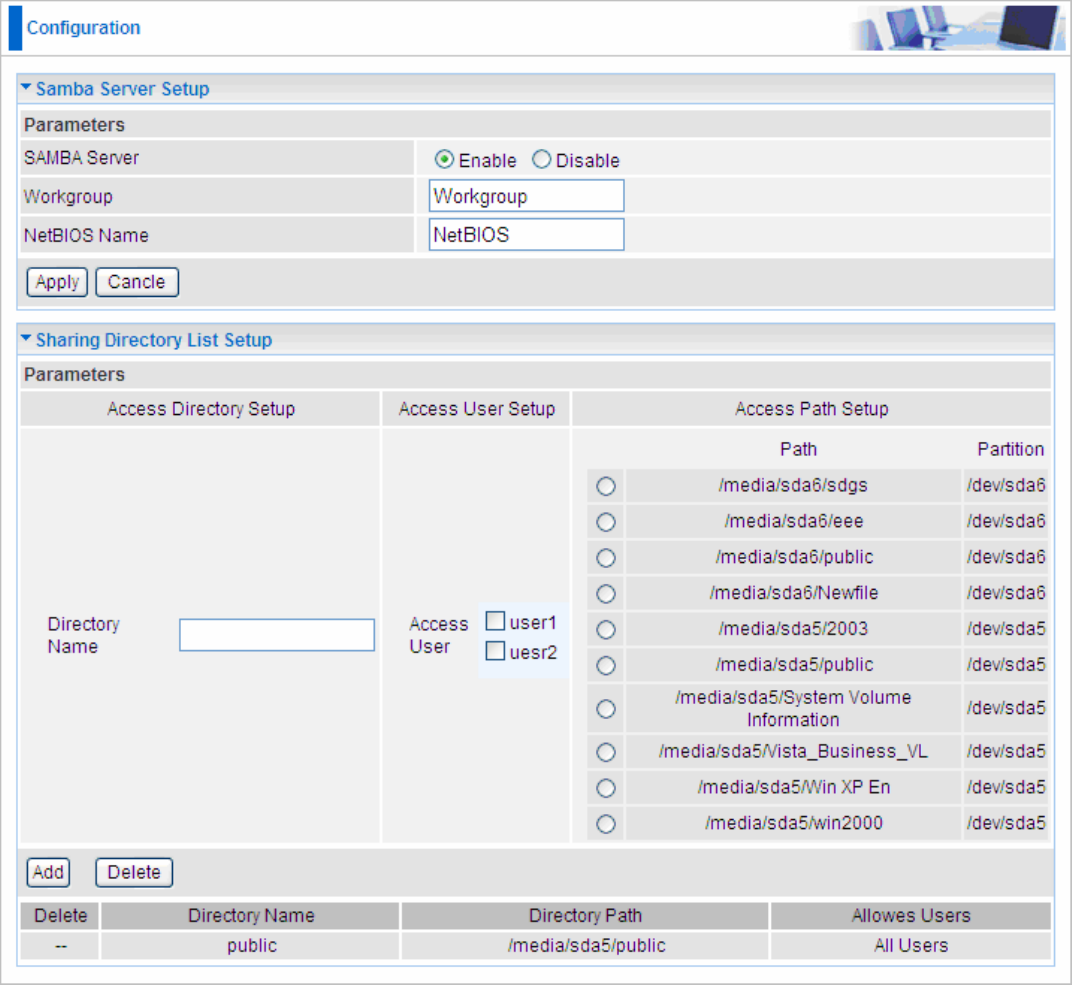
88
Samba Server
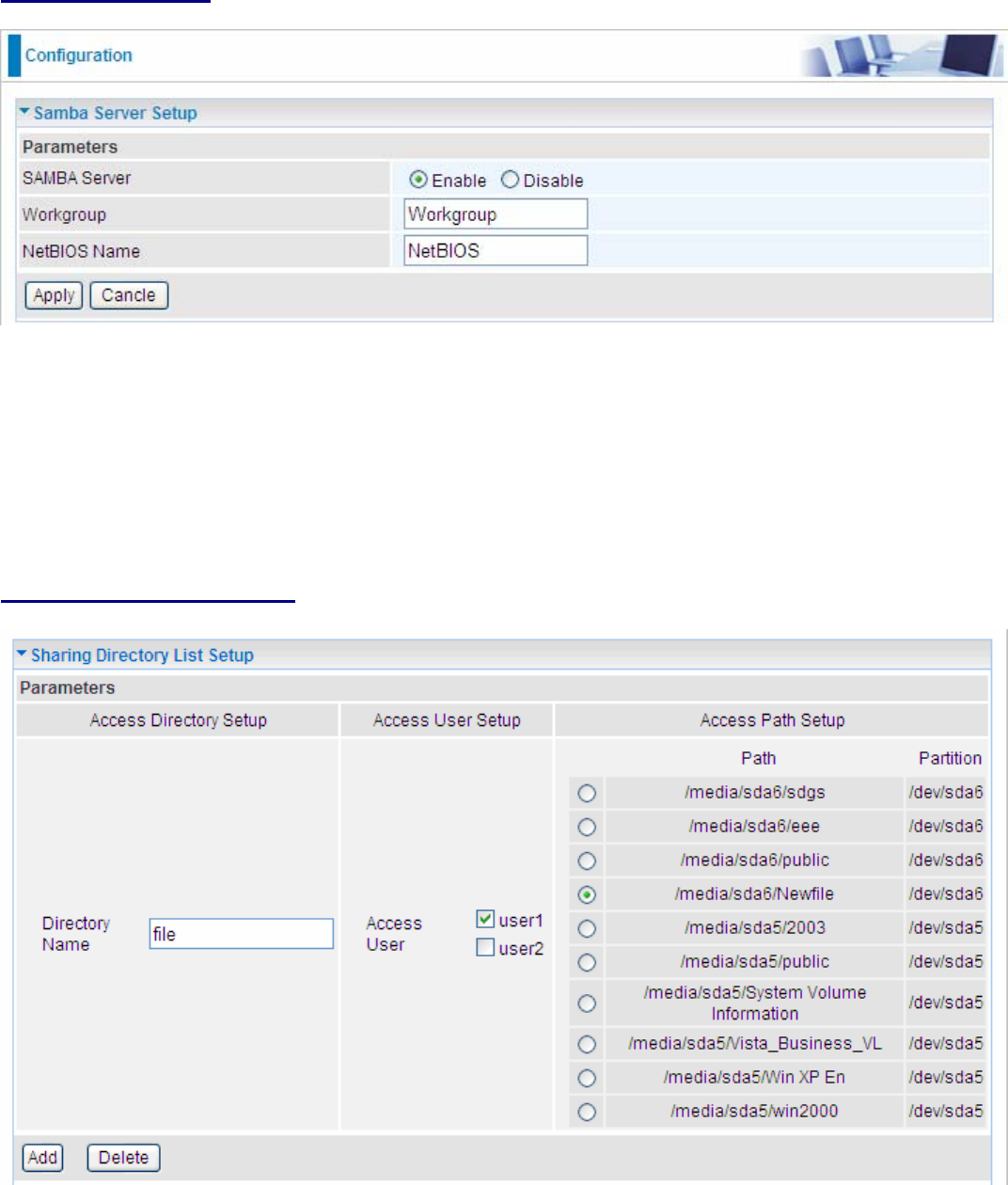
89
Samba Server Setup
SAMBA Service: Enable or Disable SAMBA Server function. Default setting is set to Disable.
Workgroup: Enter the workgroup name in this field and default name is workgroup.
NetBIOS Name: Enter NetBIOS name in this field and default name is NetBIOS.
Click Apply to confirm the configuration.
Sharing Directory List Setup
Directory Name: Enter the mapping directory name which will be seen in server.
Access User: Choose User which is allowed to access the directory.
Path Partition: Choose partition path which user can access.
Add: Click this button to add a new setup and the added setup will appear at the bottom table.
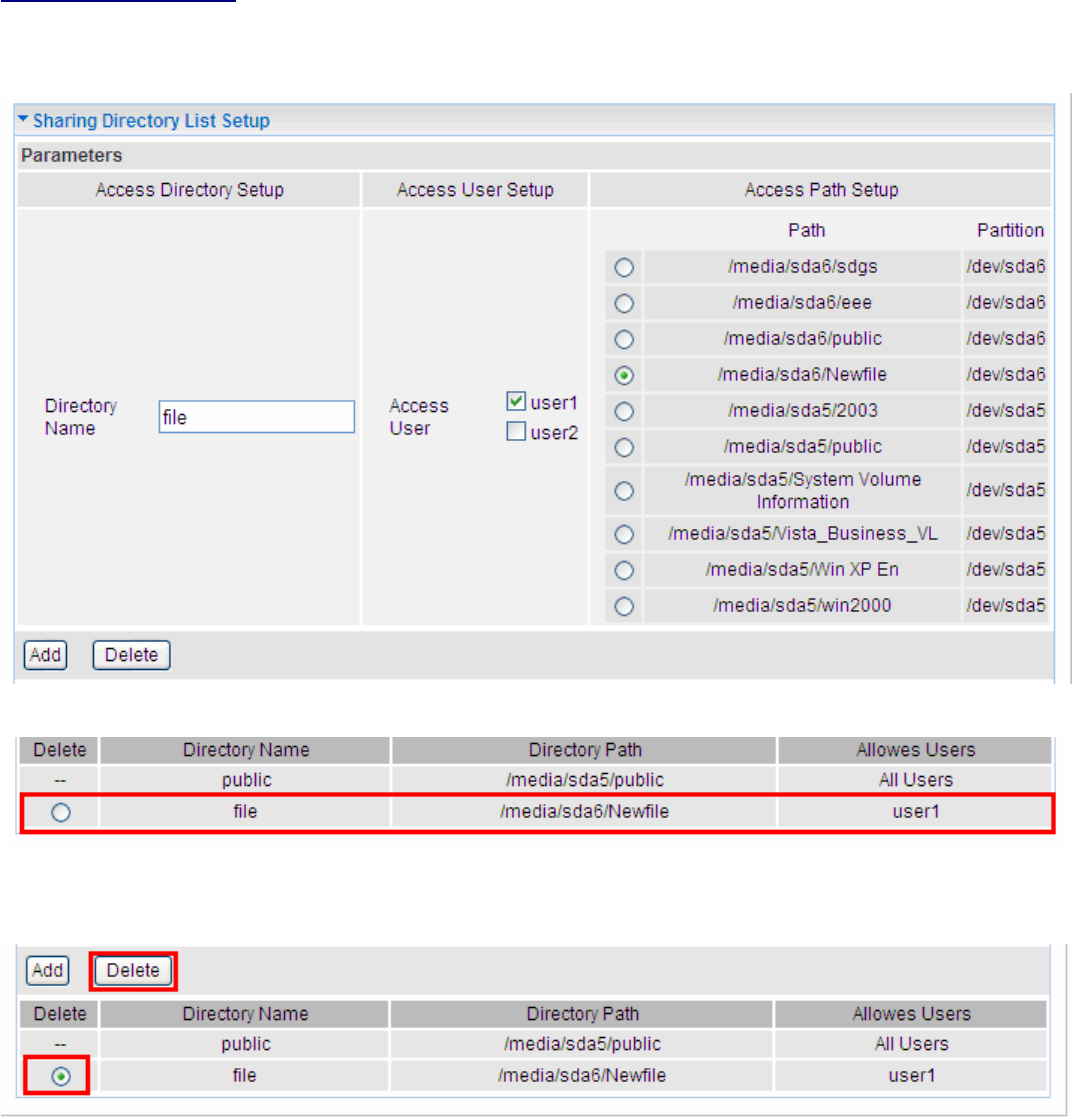
90
Add/Delete directory
1. Enter mapping directory name in the directory name field, choose access user and partition path.
2. Click Add. The New directory will display below.
Click Apply to confirm configuration.
3. Choose the directory which you want to delete then click Delete to romove this directory.
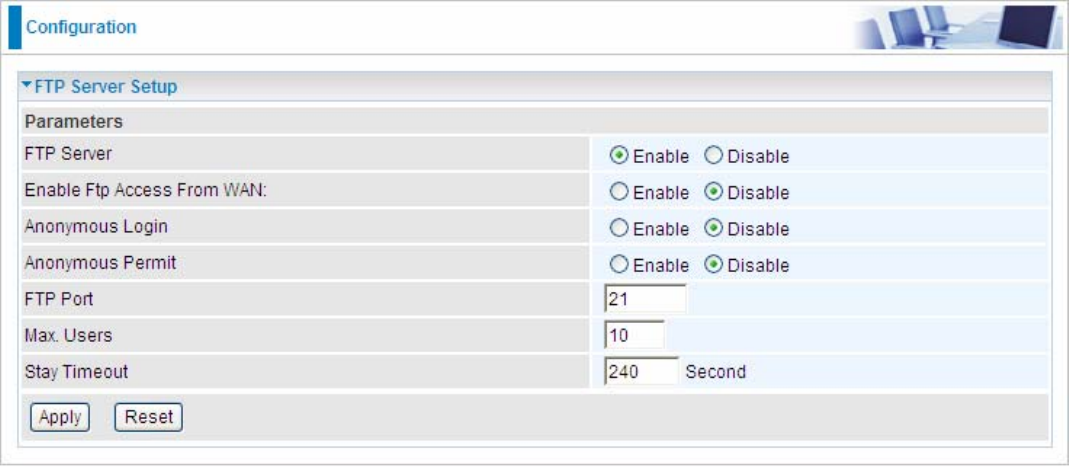
91
FTP Server
FTP Server: Enable or Disable FTP Server function. Default setting is set to disable.
Enable Ftp Access From WAN: Enable or Disable access FTP Server from WAN. Default setting is
set to disable. Enable this function, both WAN and LAN can use FTP server.
Anonymous Login: Enable or disable Anonymous Login. Default setting is set to disable.
Anonymous Permit: Enable or disable Anonymous Permit. Default setting is set to disable. If you
enable this function, this will permit the anonymous user to edit directory.
FTP Port: Enter FTP port in this field; please avoid conflicts with other port.
Max. Users: This option specifies the maximum number of user accounts.
Stay Timeout: Enter the Stay timeout value. Auto-disconnect when there is no activity for a
predetermined period of time. The default value is 240 seconds.
Click Apply to save the configuration.
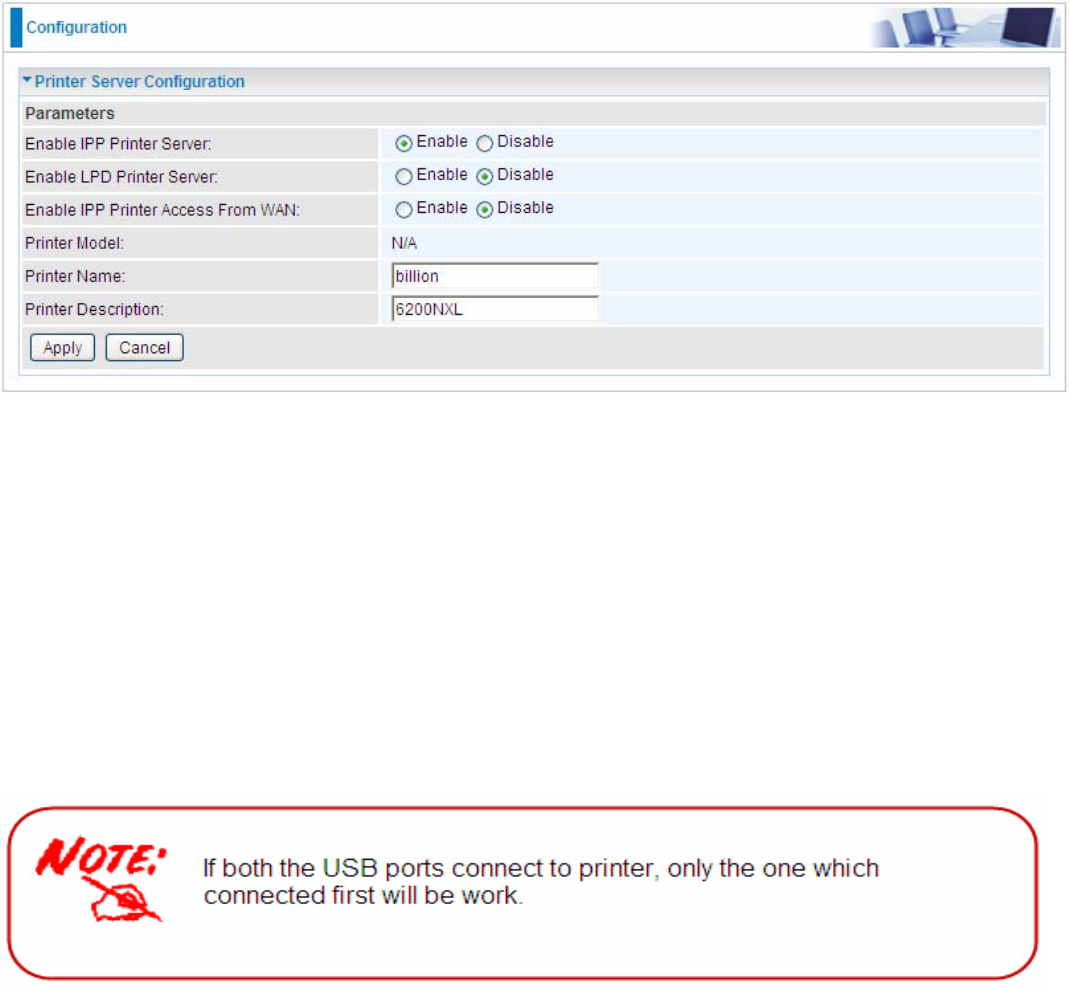
92
Printer Server
Printer Server provides a simple and efficient network printing solution. Connect one end of the printer
server to the printer and one end to the network, then anywhere the printer is in the network, users can
print easily.
IPP, short for Internet Printing Protocol, provides a set of network printing services which give printing
a more efficient and secure environment.
LPD, stands for Line Printer Daemon. Its function is to wait for the printing tasks transmitted by
the LPR(line printer remote). When the LPD receives a print job, it first gets the print jobs
temporarily stored in the print queue. The print queue is a file directory and many of the LPD
print job are waiting here for processing. When the printing device is idle, LPD remove the print
job from the print queue and pass it to the printer task to print.
Here enable IPP Printer Server if you want to use IPP Printer or enable LPD Printer Server if you want
to use LPD Printer. Also you can enable the two. But LPD printer can only be used in LAN, if you want
to printe from WAN, please enable IPP Printer Access From WAN.
Enable IPP Printer Server: Enable or Disable IPP Printer Server function. Default setting is set to
disable.
Enable LPD Printer Server: Enable or Disable LPD Printer Server function. Default setting is set to
disable.
Enable Printer Access From WAN: Enable or disable printer access from WAN. Default setting is
setto disable. Enable this function, both WAN and LAN can use the printer.
Printer Model: Display the model of printer.
Printer Name: Set printer’s alias.
Printer Description:Enter the information of the printer.
Click Apply to confirm the configuration.
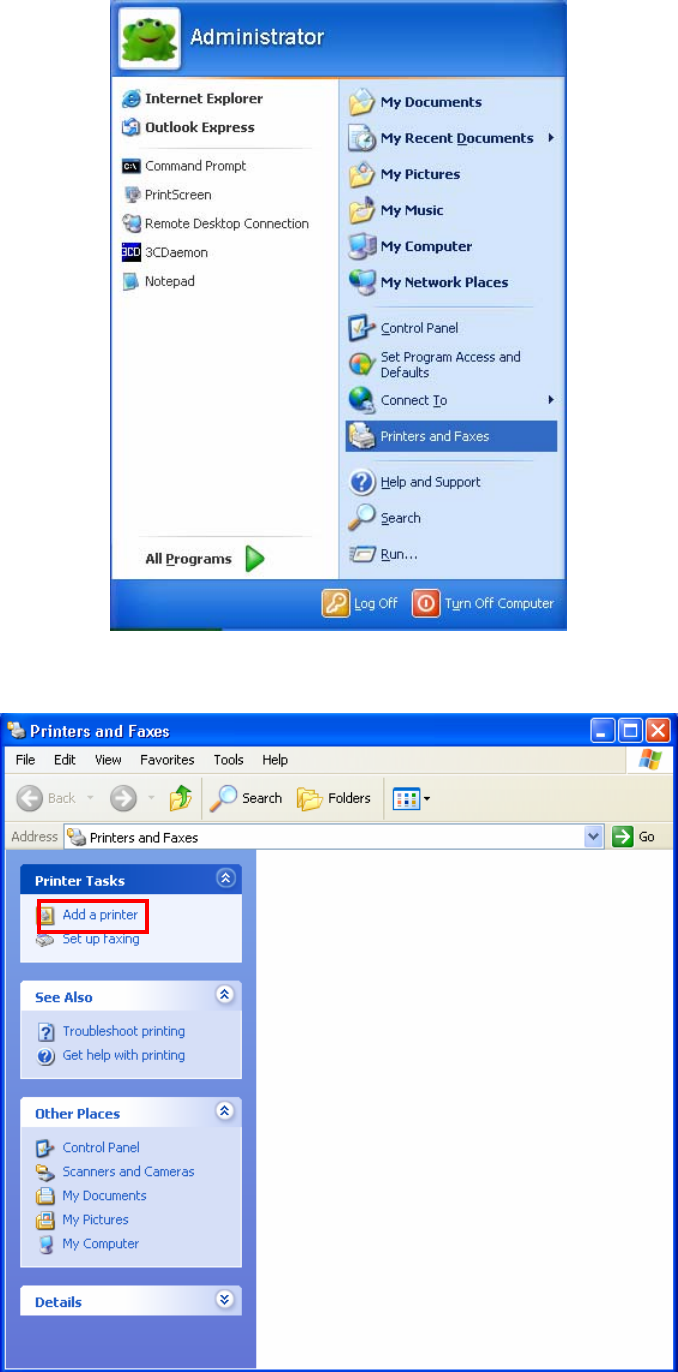
93
Set up of Printer client
Step 1: Click Start and select ’’Printer and Faxes’’.
Step 2: Click ‘’Add a Printer’’.
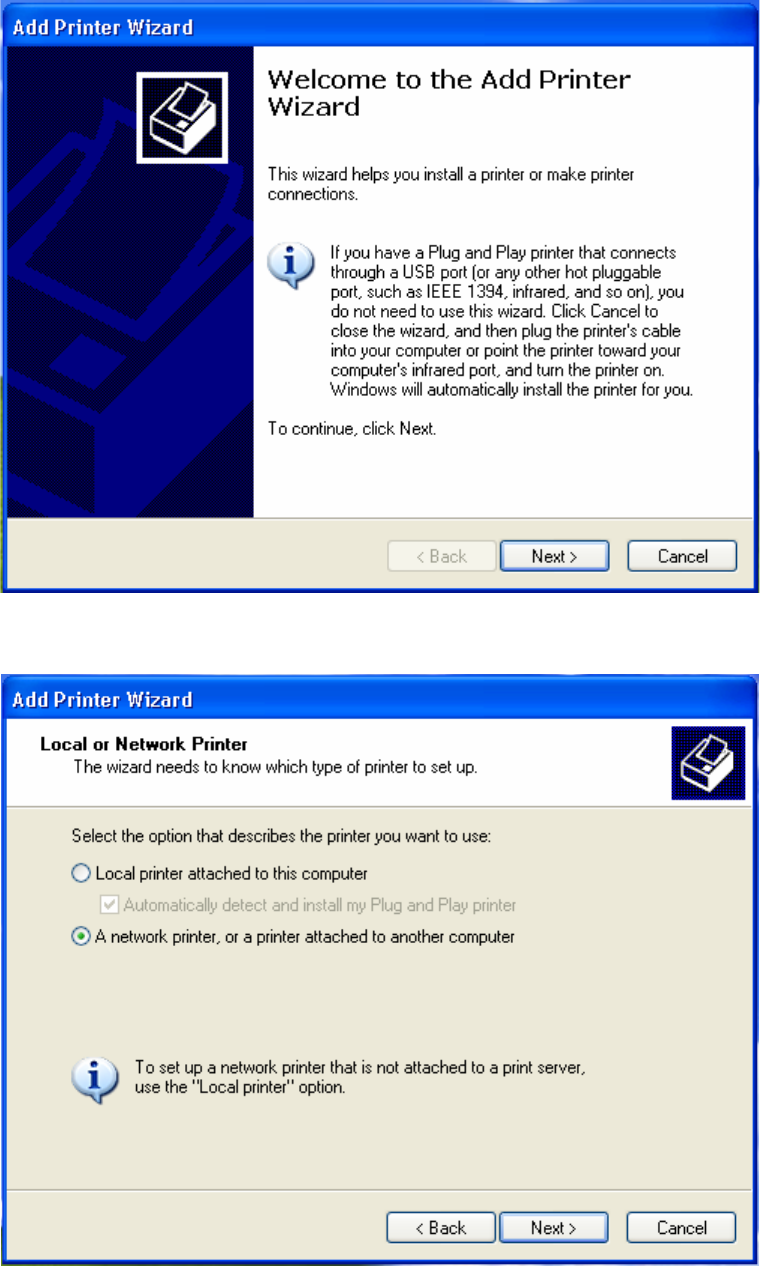
94
Step 3: To continue, click “Next”
Step 4: Select network printer and apply “Next” button.
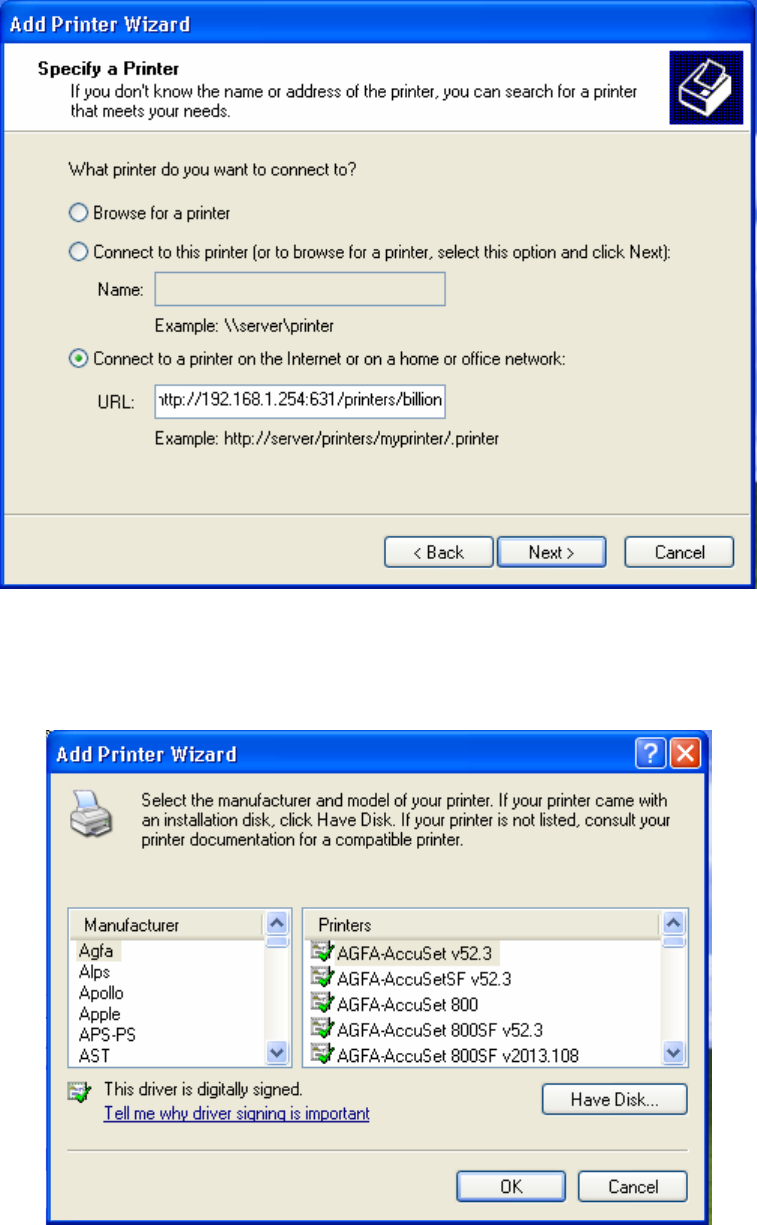
95
Step 5: Select ”Connect to a printer on the Internet or on a home or office network“ then enter the
printer’s URL: http://LAN IP/printers/ printername or http://WAN IP:631/printers/ printername. Make
sure printer’s name is the same with you set in web page.
Step 6: Click “Next” to add the printer driver. If your printer is not listed and your printer came with an
installation disk, click “Have Disk” find it and install the driver.
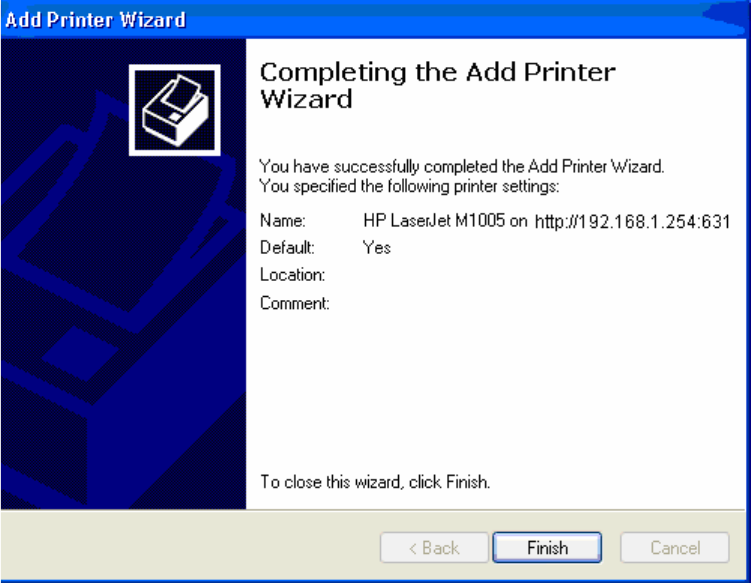
96
Step 7: Click “Finish” to complete the add printer.
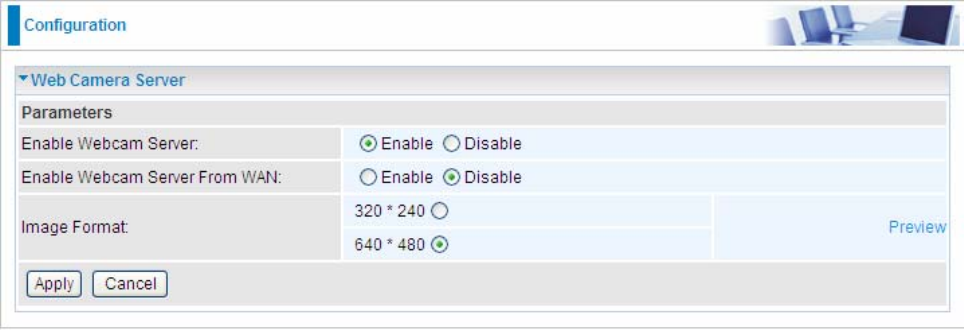
97
Webcam
Enable Webcam Server: Enable or Disable Webcam Server function. Default setting is set to disable.
Enable Webcam Server From WAN: Enable or disable this function. Default setting is set to disable.
Enable this function, both WAN and LAN can see the image.
Image Format:Choose the size of the image you will see.
Preview:Click the link ,you can preview the image which transmitted by the webcam.
Click Apply to confirm the configuration.
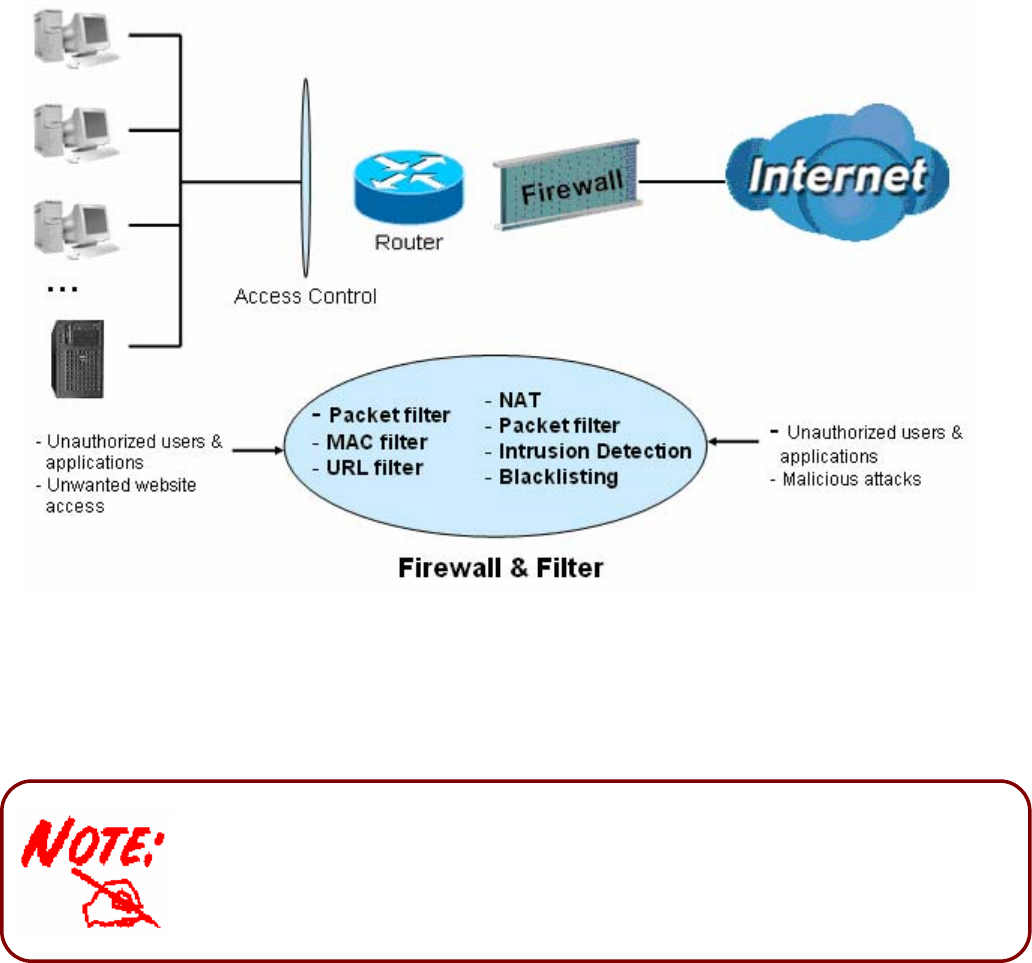
98
When using Virtual Servers (port mapping) your PCs are exposed to the
ports specified opened in your firewall packet filter settings.
Firewall and Access Control
Your router includes a full SPI (Stateful Packet Inspection) firewall for controlling Internet access from
your LAN, as well as helping to prevent attacks from hackers. In addition to this, when using NAT
(Network Address Translation) the router acts as a “natural” Internet firewall, since all PCs on your
LAN use private IP addresses that cannot be directly accessed from the Internet. See the WAN
configuration section for more details on NAT.
Firewall: Prevents access from outside your network.
NAT natural firewall: This masks LAN users’ IP addresses, which are invisible to outside users on the
Internet, making it much more difficult for a hacker to target a machine on your network. This natural
firewall is on when the NAT function is enabled.
99
Firewall Security and Policy (General Settings): Inbound direction of Packet Filter rules prevent
unauthorized computers or applications accessing your local network from the Internet.
Intrusion Detection: Enable Intrusion Detection to detect, prevent, and log malicious attacks.
MAC Filter rules: Prevents unauthorized computers accessing the Internet.
URL Filter: Blocks PCs on your local network from unwanted websites.
A detailed explanation of each of the following five items appears in the Firewall section below:
Packet Filter, MAC Address Filter, Intrusion detection, Block WAN PING and URL Filter.
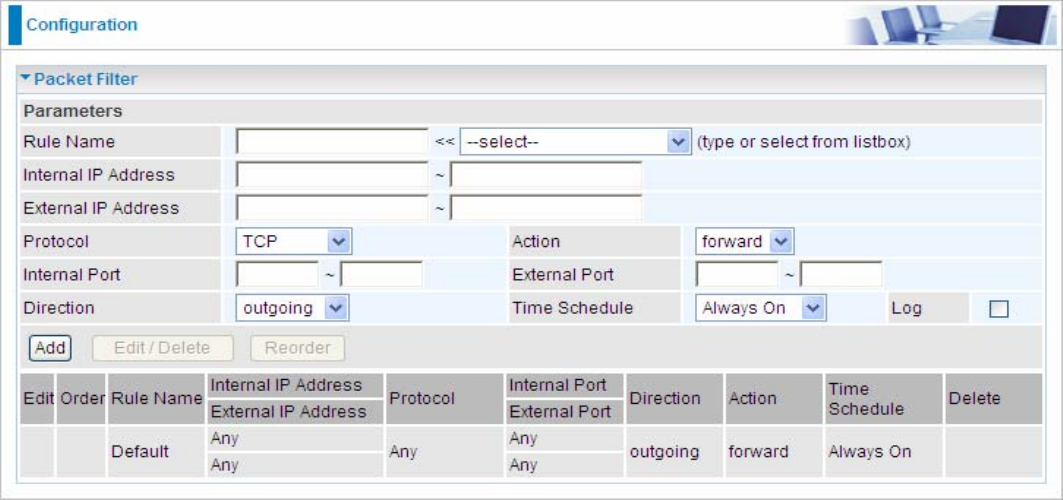
100
Packet Filter
Packet filtering enables you to configure your router to block specified internal/external users (IP
address) from Internet access, or you can disable specific service requests (Port number) to /from
Internet. This configuration program allows you to set up to 6 different filter rules for different users
based on their IP addresses or their network Port number. The relationship among all filters is “or”
operation, which means that the router checks these different filter rules one by one, starting from the
first rule. As long as one of the rules is satisfied, the specified action will be taken.
Rule Name: Users-define description to identify this entry. The maximum name length is 32
characters, and then can choose application that they want from list box.
Internal IP Address / External IP Address: This is the Address-Filter used to allow or block traffic
to/from particular IP address (es). Input the range you want to filter out. If you leave empty or 0.0.0.0,
it means any IP address.
Protocol: Specify the packet type (TCP, UDP, ICMP, etc.) that the rule applies to.
Select TCP if you wish to search for the connection-based application service on the remote server
using the port number. Or select UDP if you want to search for the connectionless application service
on the remote server using the port number.
Action: If a packet matches this filter rule, Forward (allows the packets to pass) or Drop (disallow
the packets to pass) this packet.
Internal Port: This Port or Port Range defines the ports allowed to be used by the Remote/WAN to
connect to the application. Default is set from range 0 ~ 65535. It is recommended that this option be
configured by an advanced user.
External Port: This is the Port or Port Range that defines the application.
Direction: Determine whether the rule is for outgoing packets or for incoming packets.
Time Schedule: It is self-defined time period. You may specify a time schedule for your prioritization
policy. For setup and detail, refer to Time Schedule section.
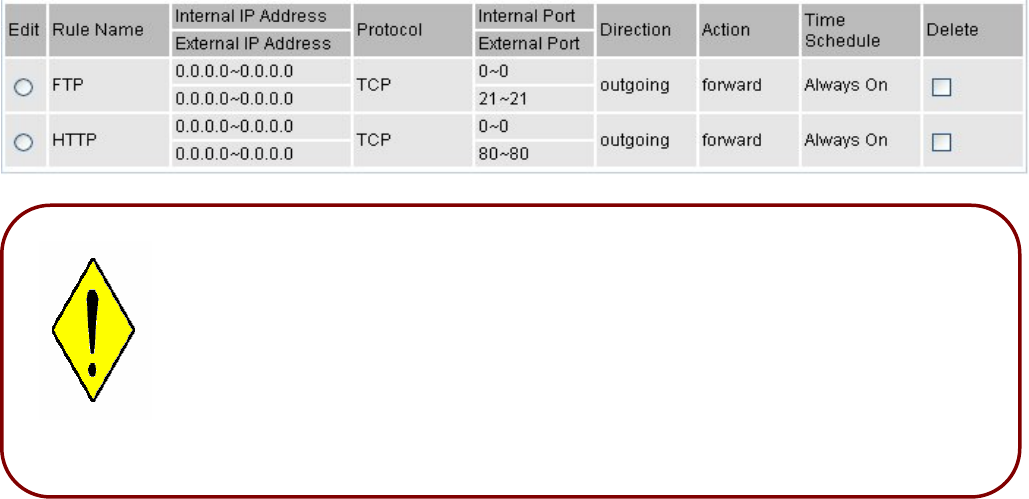
101
Log: Choose “log” if you wish to generate logs when the filer rule is applied to a packet.
Add: Click this button to add a new packet filter rule and the added rule will appear at the bottom table.
Edit: Check the Rule No. you wish to edit, and then click “Edit”.
Delete: Check the Rule No. you wish to delete, and then click “Delete”.
If the DHCP server option is enabled, you must be very careful in assigning
IP addresses of a filtered private IP range to avoid conflicts because you do
not know which PC in the LAN is assigned which IP address. The easiest
and safest way is that the filtered IP address is assigned to a specific PC
that is not allowed to access an outside resource such as the Internet. You
configure the filtered IP address manually for this PC, but it stays in the
same subnet with the router.
Attention
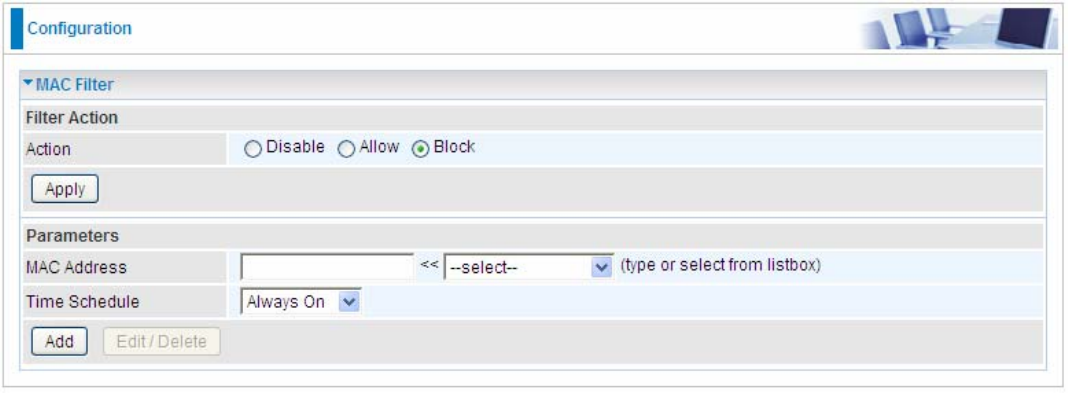
102
MAC Filter
A MAC (Media Access Control) address is the unique network hardware identifier for each PC on your
network’s interface (i.e. its Network Interface Card or Ethernet card). Using your router’s MAC
Address Filter function, you can configure to block specific machines from accessing your LAN.
There are no pre-defined MAC address filter rules; you can add the filter rules to meet your
requirements.
Action:select to determine how to do with the filter.
• Disable: to disable the MAC filter function.
• Allow: to enable the MAC filter function and allow the host of the following set MAC
addresses to access.
• Block: to enable the MAC filter function and block the host of the following set MAC
addresses to access.
MAC Address: Enter the MAC addresses you wish to manage.
Time Schedule: It is self-defined time period. You may specify a time schedule for your prioritization
policy. For setup and detail, refer to Time Schedule section.
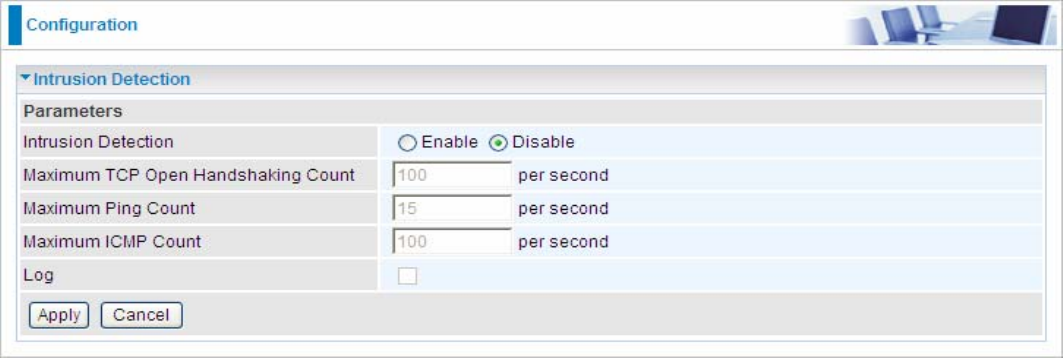
103
Intrusion Detection
Check Enable if you wish to detect intruders accessing your computer without permission. The router
automatically detects and blocks a DoS (Denial of Service) attack if a user enables this function. This
kind of attack is not to access confidential data on the network; instead, it aims to disrupt specific
equipment or the entire network. If this happens, users will have trouble accessing the network
resources.
Intrusion Detection: Check Enable if you wish to detect intruders accessing your computer without
permission.
Maximum TCP Open Handshaking Count: This is a threshold value to decide whether a SYN Flood
attempt is occurring or not. Default value is 100 TCP SYN per seconds.
Maximum Ping Count: This is a threshold value to decide whether an ICMP Echo Storm is occurring
or not. Default value is 15 ICMP Echo Requests (PING) per second.
Maximum ICMP Count: This is a threshold to decide whether an ICMP flood is occurring or not.
Default value is 100 ICMP packets per seconds except ICMP Echo Requests (PING).
Log: Check Log if you wish to generate logs when the filer rule is applied to the Intrusion Detection.

104
For SYN Flood, ICMP Echo Storm and ICMP flood, IDS will just warn the user in the Event Log but it
will not be able to protect against such attacks.
Hacker attack types recognized by the IDS
Intrusion Name Detect Parameter Blacklist Type of Block
Duration Drop Packet Show Log
Ascend Kill Ascend Kill data Src IP DoS Yes Yes
WinNuke TCP
Port 135, 137~139,
Flag: URG Src IP DoS Yes Yes
Smurf ICMP type 8
Des IP is broadcast Dst IP Victim
Protection Yes Yes
Land attack SrcIP = DstIP Yes Yes
Echo/CharGen Scan UDP Echo Port and
CharGen Port Yes Yes
Echo Scan UDP Dst Port =
Echo(7) Src IP Scan Yes Yes
CharGen Scan UDP Dst Port =
CharGen(19) Src IP Scan Yes Yes
X’mas Tree Scan TCP Flag: X’mas Src IP Scan Yes Yes
IMAP
SYN/FIN Scan
TCP Flag: SYN/FIN
DstPort: IMAP(143)
SrcPort: 0 or 65535 Src IP Scan Yes Yes
SYN/FIN/RST/ACK
Scan
TCP,
No Existing session
A
nd Scan Hosts
more than five.
Src IP Scan Yes Yes
Net Bus Scan
TCP
No Existing session
DstPort = Net Bus
12345,12346, 3456
SrcIP Scan Yes Yes
Back Orifice Scan UDP, DstPort =
Orifice Port (31337) SrcIP Scan Yes Yes
SYN Flood Max TCP Open
Handshaking Count
(Default 100 c/sec) Yes
ICMP Flood Max ICMP Count
(Default 100 c/sec) Yes
ICMP Echo Max PING Count
(Default 15 c/sec) Yes
Src IP: Source IP Src Port: Source Port
Dst Port: Destination Port Dst IP: Destination IP
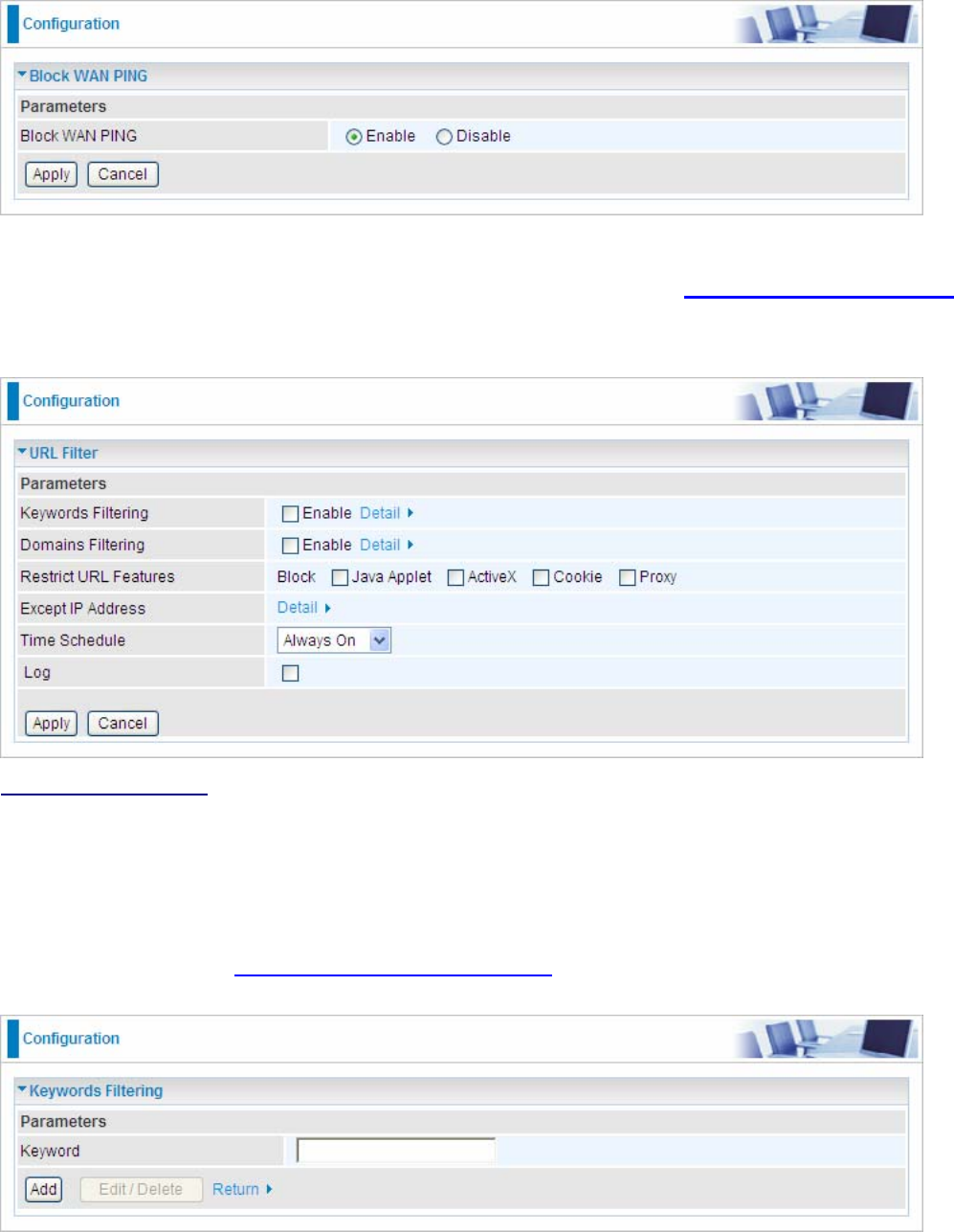
105
Block WAN PING
Check Enable if you wish to exclude outside PING requests from reaching this router.
URL Filter
URL (Uniform Resource Locator – e.g. an address in the form of http://www.example.com ) filter
rules allow you to prevent users on your network from accessing particular websites from their URL.
There are no pre-defined URL filter rules; you can add filter rules to meet your requirements.
Keywords Filtering
Allows blocking by specific keywords within a particular URL rather than having to specify a complete
URL (e.g. to block any image called “advertisement.gif”). When enabled, your specified keywords list
is checked to see if any keywords are present in URLs accessed to determine if the connection
attempt should be blocked. Note that the URL filter blocks web browser (HTTP) connection attempts
using port 80 only.
For example, the URL http://www.abc.com/abcde.html would be dropped since the keyword “abcde”
occurs in the URL.
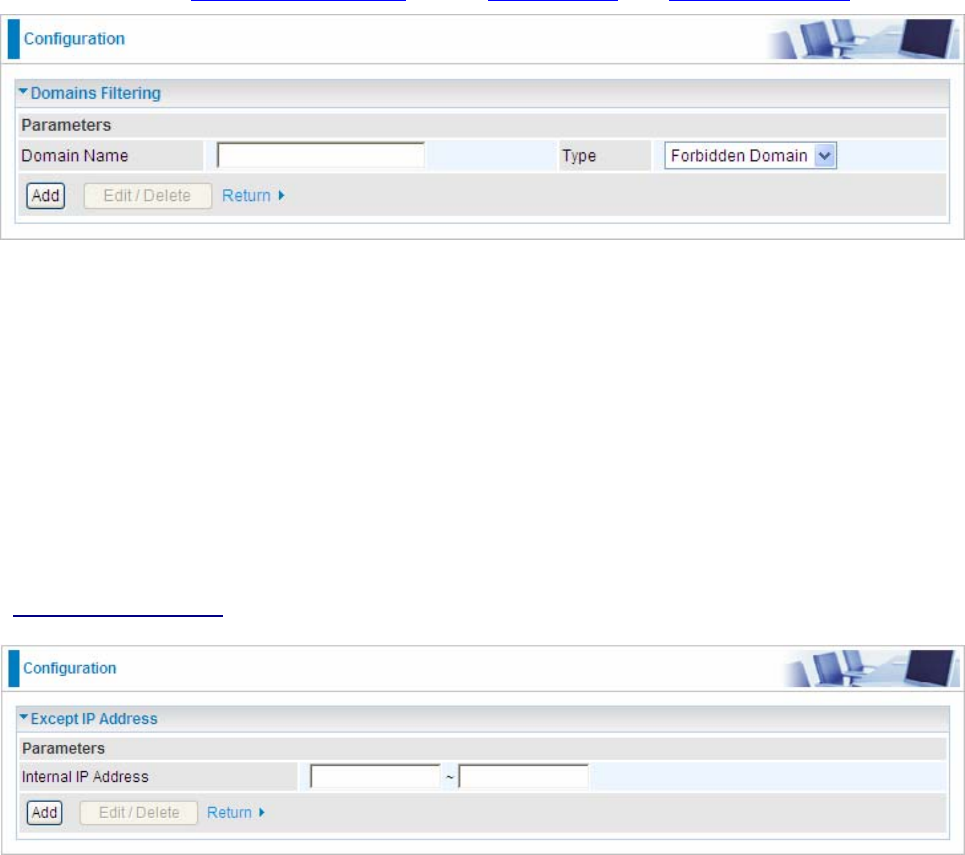
106
Domains Filtering
Checks the domain name in URLs accessed against your list of domains to block or allow. If it matches,
the URL request is sent (Trusted) or dropped (Forbidden). The checking procedure is:
1. Check the domain in the URL to determine if it is in the trusted list. If yes, the connection attempt is
sent to the remote web server.
2. If not, it is checked with the forbidden list. If present, the connection attempt is dropped.
3. If the packet matches neither of the above, it is sent to the remote web server.
4. Please be note that the completed URL, “www” + domain name shall be specified. For example to
block traffic to www.google.com.au, enter “www.google” or “www.google.com”
Restrict URL Features
This function enhances the restriction to your URL rules.
~ Block Java Applet: Blocks Web content which includes the Java Applet to prevent someone who
wants to damage your system via the standard HTTP protocol.
~ Block ActiveX: Blocks ActiveX
~ Block Cookies: Blocks Cookies
~ Block Proxy: Blocks Proxy
Except IP Address
Time Schedule: It is self-defined time period. You may specify a time schedule for your prioritization
policy. For setup and detail, refer to Time Schedule section.
Log: Click “Log” if you wish to generate logs when the filer rule is applied to the URL Filter.
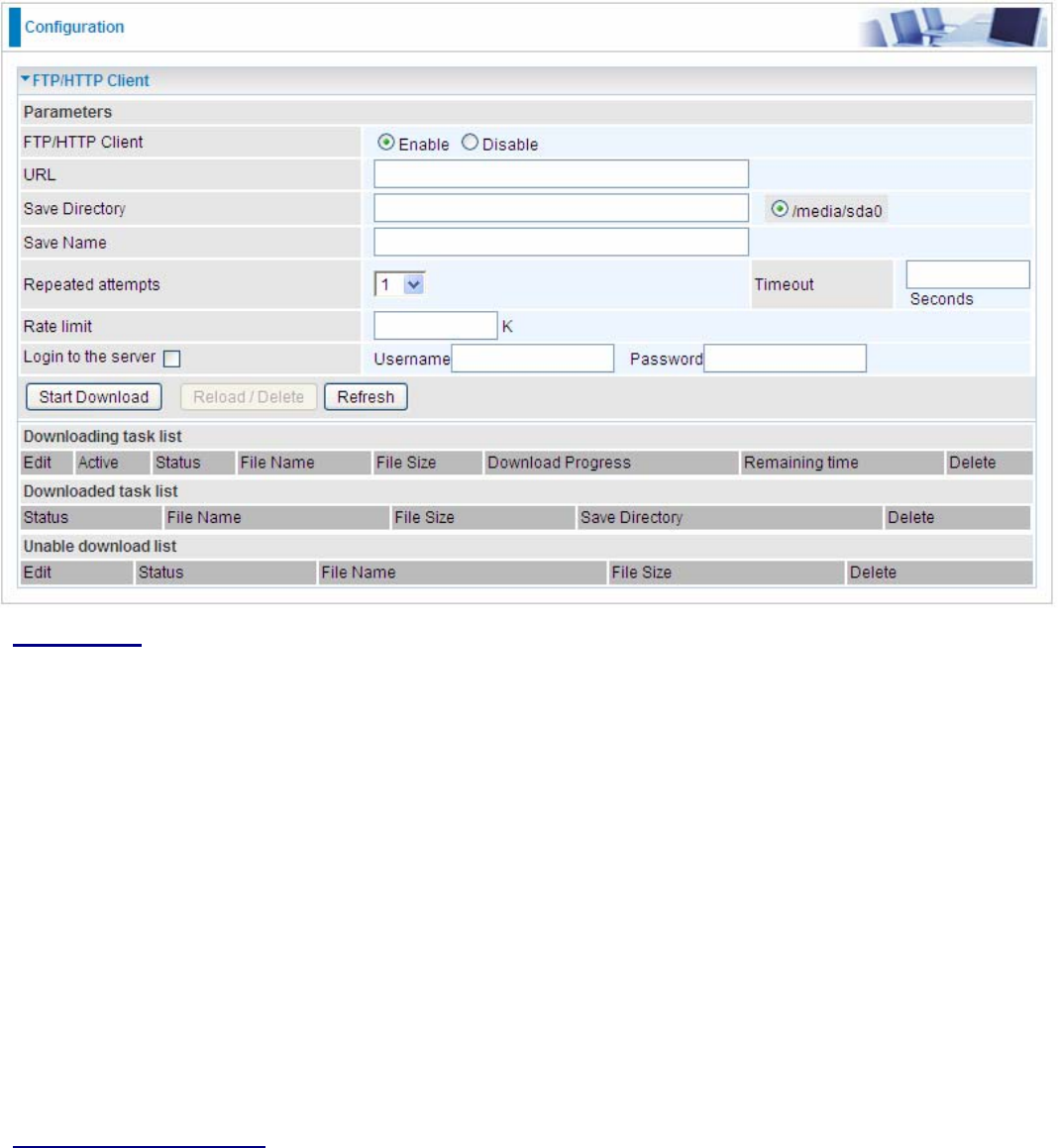
107
Download Tool
FTP Client
Parameters
FTP/HTTP Client: select whether to enable or disable the FTP/ Http Client.
URL: Enter the URL of the file you want to download, it must be a complete one.
Save Directory: Enter the Directory you want to save to. The directory is one of the USB directories. If
not existed, a new one with the name will be created.
Save Name: Enter the name you want to save as the file name.
Repeated attempts: select the repeated attempts you want form the drop-down box. When
connection is failed, it will again connect according to the value you set.
Timeout: Enter the timeout time. Auto-disconnect the connection when the task doesn’t connect to
the server for a predetermined period of time (timeout time).
Rate limit: The limit rate. Specify as you want or leave it there.
Login to the server: check the checkbox to enable login to the server then enter the username and
password of the server if username and password are required.
Downloading task list:
Edit: Press the radio button, the message of the corresponding task will be listed above, you can just
view.

108
Active: Check the checkbox to active the downloading task.
Status: Display the status of the downloading task.
File Name: Display the File Name you set to the downloading file.
File Size: Display the size of the file.
Download Progress: Display the download progress of the task.
Remaining time: Display the remaining time of the task.
Delete: Press the radio button, then press Reload/Delete to delete the task.
Downloaded task list:
Status: Display the task status.
File Name: Display the user-set Name of the file downloaded.
File Size: Display the size of the file downloaded.
Save Directory: Display the directory in the USB device.
Delete: Press the radio button, then press Reload/Delete to delete the record.
Unable Download List:
Edit: Press the radio button, then press Reload/Delete to edit and reload.
Status: Display the status of the task.
File Name: Display the user-set file name.
File Size: Display the file size
Delete: Press the radio button, then press Reload/Delete to delete the record.
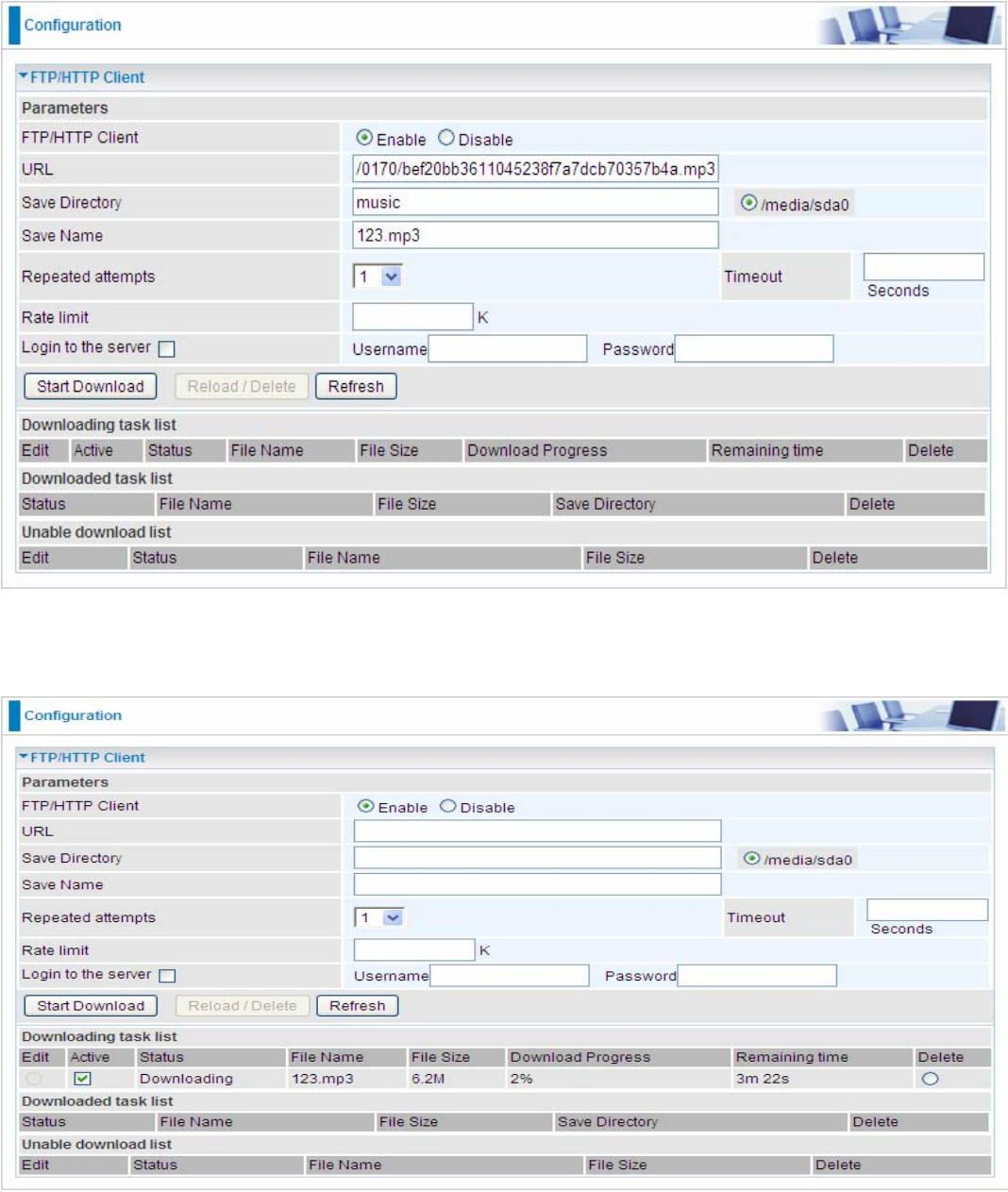
109
Set up a download task:
You can set a http or ftp connection, here take http client for example. Enter the necessary information
of the task, leave the others as default as you like, then press Start Download.
Then the task will be listed in the Downloading task list table. Check the Active checkbox to
temporarily stop the downloading task and recheck the Active box to active the downloading task.
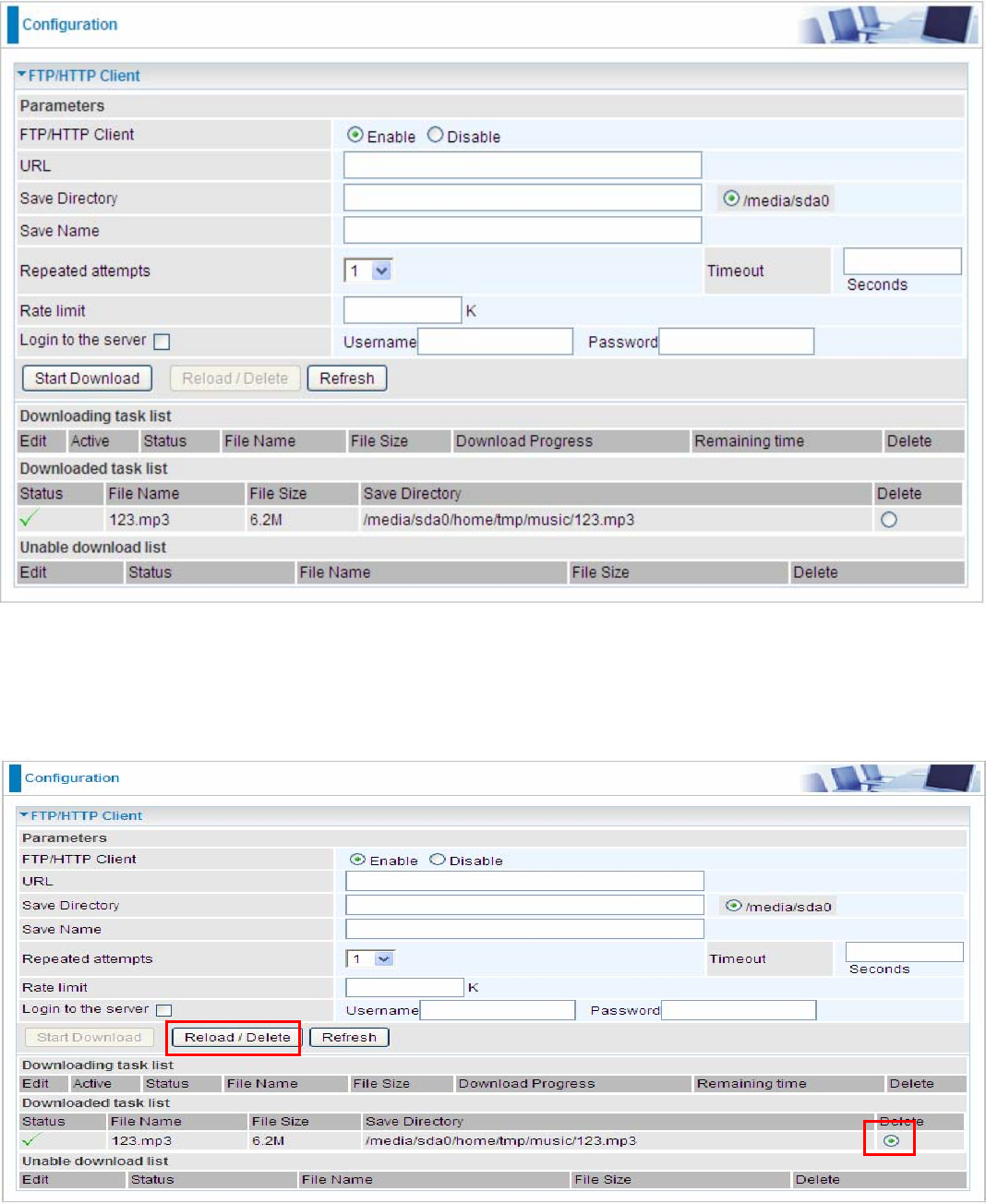
110
You can press Refresh to view the latest information especially the download progress. And when the
task is finished, it will be listed in the Downloaded task list.
Here you have finished the downloading task.
Delete the task: press the Delete radio button beside the item you want to delete, then press the
Reload/Delete button to delete it. The delete action is the same in the other two lists.
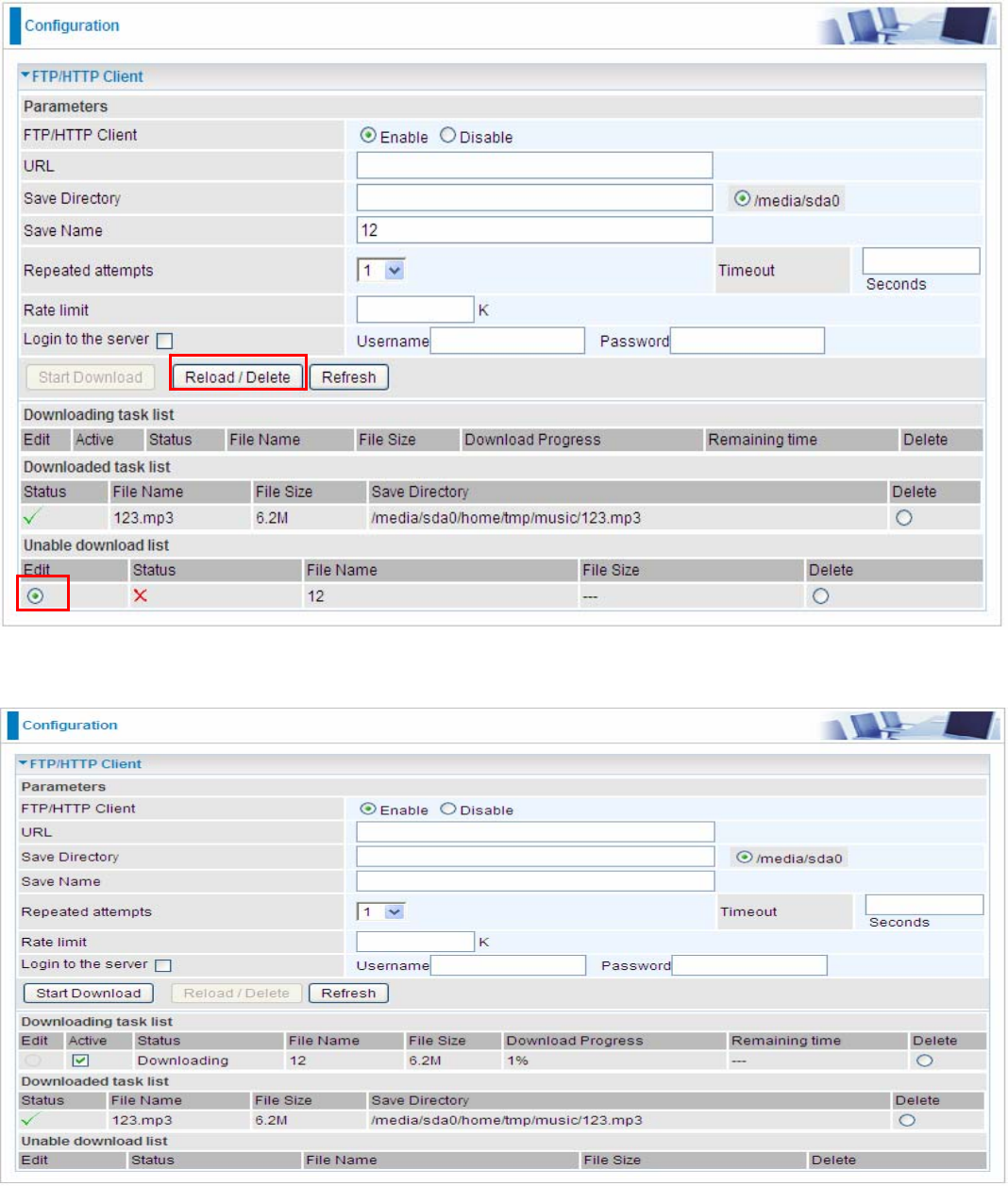
111
Edit and Reload the task:
If there task unable to download, you can reedit for reloading.
Enter the necessary message and press Reload/Delete.
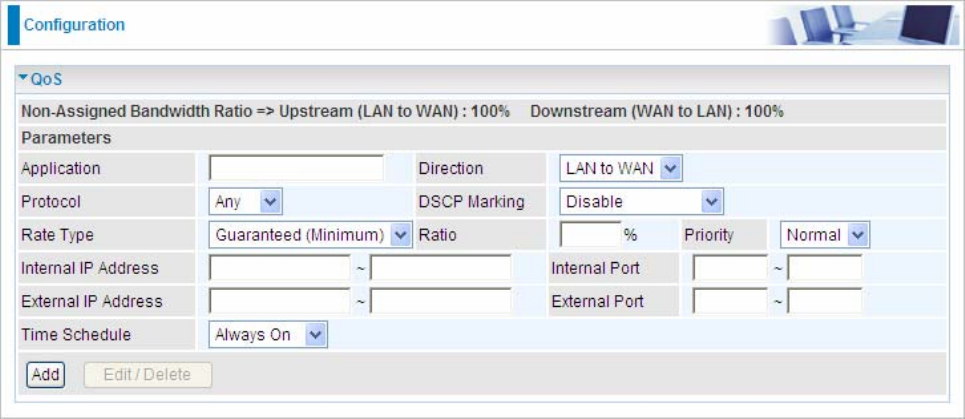
112
QoS (Quality of Service)
Quality of Service Introduction
If you’ve ever found your ‘net’ speed has slowed to a crawl because another family member is using a
P2P file sharing program, you’ll understand why the Quality of Service features in the routers is such a
breakthrough for home users and office users.
QoS: Keeping Your Net Connection Fast and Responsive
Configurable by internal IP address, external IP address, protocol, and port, the Quality of Service
(QoS) gives you full control over which types of outgoing data traffic should be given priority by the
router, ensuring bandwidth-consumption data like gaming packets, latency-sensitive application like
voice, or even mission critical files, move through the router at lightning speed, even under heavy load.
You can throttle the speed at which different types of outgoing data pass through the router. In addition,
you can simply change the priority of different types of upload data and let the router sort out the actual
speeds.
QoS Setup
Please choose the QoS in the Configuration item of the left window as depicted below.
After clicking the QoS item, you can Add/Edit/Delete a QoS policy. This page will show the brief
information for policies you have added or edited. This page will also display the total available
(Non-assigned) bandwidth, in percentage, can be assigned.
Application: A name that identifies an existing policy.
Direction: The traffic flow direction to be controlled by the QoS policy.
There are two settings to be provided in the Router:
~ LAN to WAN: You want to control the traffic flow from the local network to the outside world. e.g.,
you have a FTP server inside the local network and you want to have a limited traffic rate controlled by
the QoS policy. So, you need to add a policy with LAN to WAN direction setting.
~ WAN to LAN: Control Traffic flow from the WAN to LAN. The connection maybe either issued from
113
LAN to WAN or WAN to LAN.)
Protocol: The Protocol will be controlled. For GRE protocol, there is no need to specify the IP
addresses or Application ports in this page. For other protocols, at least one value shall be given.
~ ANY: No protocol type is specified.
~ TCP
~ UDP
~ ICMP
~ GRE
DSCP Marking: Differentiated Services Code Point (DSCP), it is the first 6 bits in the ToS byte. DSCP
Marking allows users to classify traffic based on DSCP value and send packets to next Router.
Note: To be sure the router(s) in the backbones network have the capability in executing and checking the
DSCP through-out the QoS network.

114
The DSCP Mapping Table
DSCP Mapping Table
3G Router Standard DSCP
Disabled None
Best Effort Best Effort (000000)
Premium Express Forwarding (101110)
Gold service (L) Class 1, Gold (001010)
Gold service (M) Class 1, Silver (001100)
Gold service (H) Class 1, Bronze (001110)
Silver service (L) Class 2, Gold (010010)
Silver service (M) Class 2, Silver (010100)
Silver service (H) Class 2, Bronze (010110)
Bronze service (L) Class 3, Gold (011010)
Bronze service (M) Class 3, Silver (011100)
Bronze service (H) Class 3, Bronze (011110)
Rate Type: 2 types are provided:
~ Limited (Maximum): Specify a limited data rate for this policy. It also is the maximal rate for
this policy. As above FTP server example, you may want to “throttle” the outgoing FTP speed to 20%
of 256K and limit to it, you may use this type.
~ Guaranteed (Minimum): Specify a minimal data rate for this policy. For example, you want to
provide a guaranteed data rate for your outside customers to access your internal FTP server with, say
at least, 20% of your total bandwidth. You can use this type. Then, if there is available bandwidth that
is not used, it will be given to this policy by following priority assignment.
Ratio: Assign the data ratio for this policy to be controlled. For examples, we want to only allow 20%
of the total data transfer rate for the LAN-to-WAN direction to be used for FTP server. Then we can
specify here with data ratio = 20.
Priority: Specify the priority for the bandwidth that is not used. For examples, you may specify two
different QoS policies for different applications. Both applications need a minimal bandwidth and need
more bandwidth, beside the assigned one, if there is any available/non-used one available. So, you
may specify which application can have higher priority to acquire the non-used bandwidth.
~ High
~ Normal: The default is normal priority.
~ Low
115
For the sample priority assignment for different policies, it is served in a First-In-First-Out way.
Internal IP Address: The IP address values for Local LAN machines you want to control. (For IP
packets from LAN to WAN, it is the source IP address. For IP packages from WAN to LAN, it is the
destination IP address.)
Internal Port: The Application port values for local LAN machines you want to control. (For TCP/UDP
packets from LAN to WAN, it is the source port value. For TCP/UDP packets from WAN to LAN, it is the
destination port value.)
External IP Address: The IP address values for Remote WAN machines you want to control. (For IP
packets from LAN to WAN, it is the destination IP address. For IP packages from WAN to LAN, it is the
source IP address.)
External Ports: The Application port values for remote machines you want to control. (For TCP/UDP
packets from LAN to WAN, it is the destination port value. For TCP/UDP packets from WAN to LAN, it
is the source port value.)
Time Schedule: Scheduling your prioritization policy.

116
Virtual Server
In TCP and UDP networks a port is a 16-bit number used to identify which application program
(usually a server) incoming connections should be delivered to. Some ports have numbers that are
pre-assigned to them by the IANA (the Internet Assigned Numbers Authority), and these are referred
to as “well-known ports”. Servers follow the well-known port assignments so clients can locate them.
If you wish to run a server on your network that can be accessed from the WAN (i.e. from other
machines on the Internet that are outside your local network), or any application that can accept
incoming connections (e.g. Peer-to-peer/P2P software such as instant messaging applications and
P2P file-sharing applications) and are using NAT (Network Address Translation), then you need to
configure your router to forward these incoming connection attempts using specific ports to the PC on
your network running the application. You also need to use port forwarding if you wish to host an online
game server.
The reason is that when using NAT, your publicly accessible IP address is used by and points to your
router, which needs to deliver all traffic to the private IP addresses used by your PCs. Please see the
WAN configuration section of this manual for information on NAT.
The Internet Assigned Numbers Authority (IANA) is the central coordinator for the assignment of
unique parameter values for Internet protocols. Port numbers range from 0 to 65535, but only port
numbers 0 to 1023 are reserved for privileged services and are designated as “well-known ports”. The
registered ports are numbered from 1024 through 49151. The remaining ports, referred to as dynamic
ports, or private ports, are numbered from 49152 through 65535.
Examples of well-known and registered port numbers are shown below, for further information, please
see IANA’s website at: http://www.iana.org/assignments/port-numbers

117
Well-known and Registered Ports
Port Number Protocol Description
20 TCP FTP Data
21 TCP FTP Control
22 TCP & UDP SSH Remote Login Protocol
23 TCP Telnet
25 TCP SMTP (Simple Mail Transfer Protocol)
53 TCP & UDP DNS (Domain Name Server)
69 UDP TFTP (Trivial File Transfer Protocol)
80 TCP World Wide Web HTTP
110 TCP POP3 (Post Office Protocol Version 3)
119 TCP NEWS (Network News Transfer Protocol)
123 UDP NTP (Network Time Protocol)
161 TCP SNMP
443 TCP & UDP HTTPS
1503 TCP T.120
1720 TCP H.323
4000 TCP ICQ
7070 UDP RealAudio
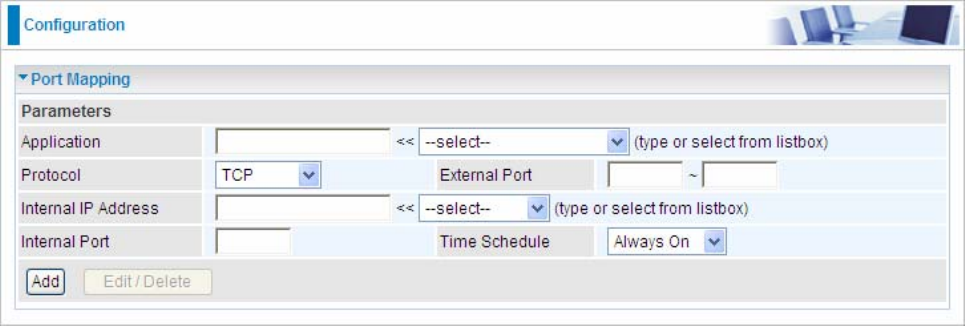
118
Port Mapping
Application: Select the service you wish to configure.
Protocol: Automatic when you choose Application from list-box or select a protocol type which you
want.
External Port & Internal Port: Enter the public port number & range you wish to configure.
Internal IP Address: Enter the IP address of a specific internal server to which requests from the
specified port is forwarded.
Add: Click to add a new virtual server rule. Click again and the next figure appears.
Edit: Check the Rule No. you wish to edit and then click “Edit/Delete”.
Delete: Check the Rule No. you wish to delete then click “Edit/Delete”.
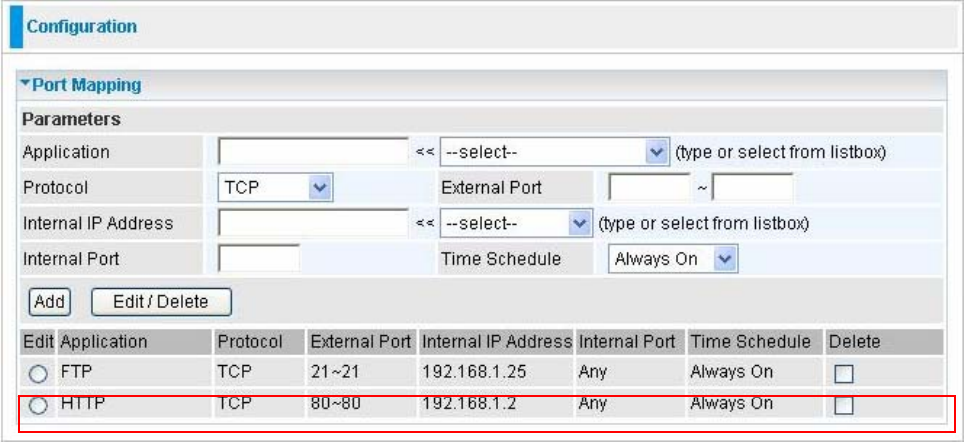
119
Since NAT acts as a “natural” Internet firewall, your router protects your network from access by
outside users, as all incoming connection attempts point to your router unless you specifically create
Virtual Server entries to forward those ports to a PC on your network. When your router needs to allow
outside users to access internal servers, e.g. a web server, FTP server, Email server or game server,
the router can act as a “virtual server”. You can set up a local server with a specific port number for the
service to use, e.g. web/HTTP (port 80), FTP (port 21), Telnet (port 23), SMTP (port 25), or POP3 (port
110). When an incoming access request to the router for a specified port is received, it is forwarded to
the corresponding internal server.
For example, if you set the port number 80 (Web/HTTP) to be mapped to the IP Address 192.168.1.2,
then all incoming HTTP requests from outside users are forwarded to the local server (PC) with the IP
address of 192.168.1.2. If the port is not listed as a predefined application, you need to add it
manually.
In addition to specifying the port number used, you also need to specify the protocol used. The
protocol is determined by the particular application. Most applications use TCP or UDP, however you
can specify other protocols using the drop-down Protocol menu. Setting the protocol to “all” causes all
incoming connection attempts using all protocols on all port numbers to be forwarded to the specified
IP address.
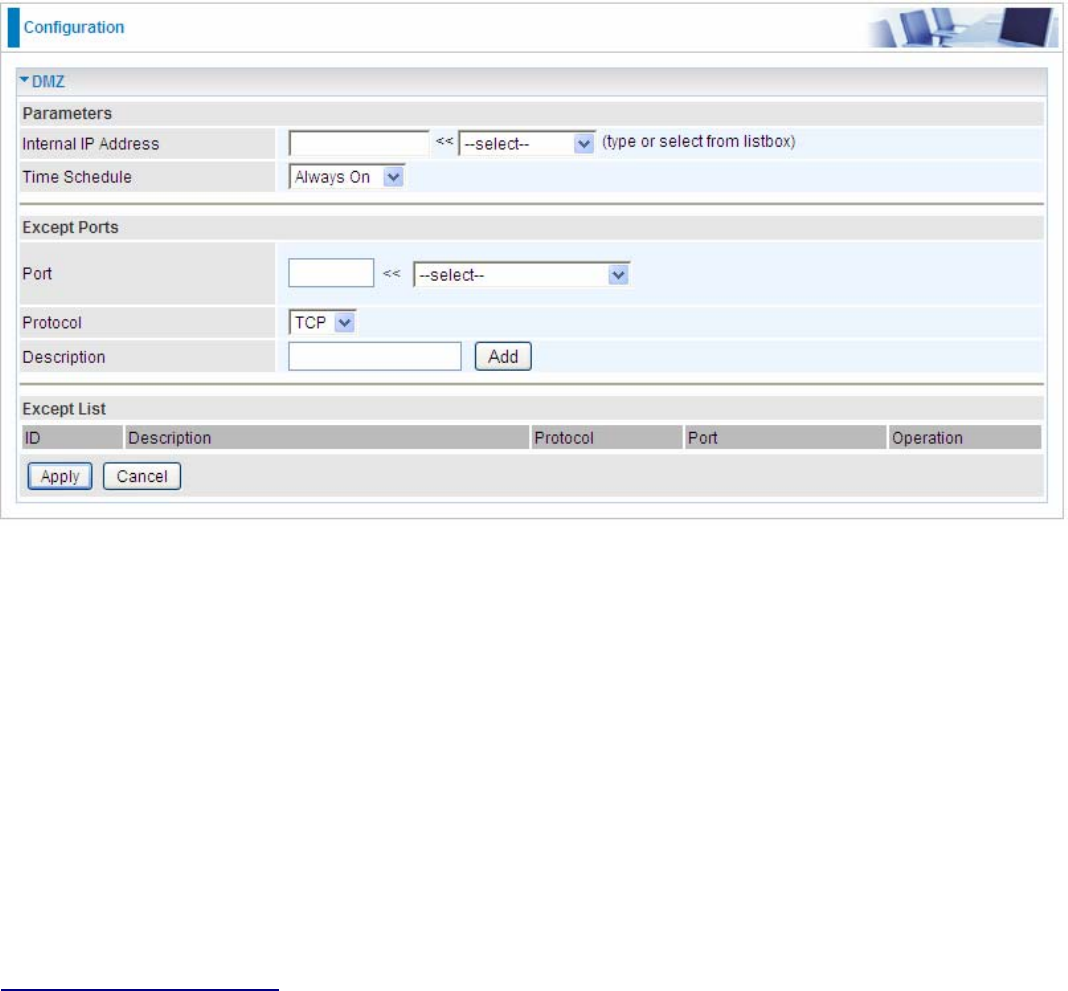
120
DMZ
The DMZ Host is a local computer exposed to the Internet. When setting a particular internal IP
address as the DMZ Host, all incoming packets are checked by the Firewall and NAT algorithms, it is
then passed to the DMZ host when a packet received does not use a port number in use by any other
Virtual Server entries.
Internal IP Address: Enter the IP address of a specific internal server to which will be the DMZ Host.
Time Schedule: A self defined time period. You may specify a time schedule. For setup and detail,
refer to Time Schedule section.
Port: The except port number. Default is set from range 1 ~ 65535.You can select from the drop
down list and also can enter manually.
Protocol: Select the TCP or UDP protocol from the drop down list.
Description: The description of the port’s function.
Add/Delete Except Ports
1. Enter except port number in the port field or choose from the drop down list. Select the port and
describe the port.
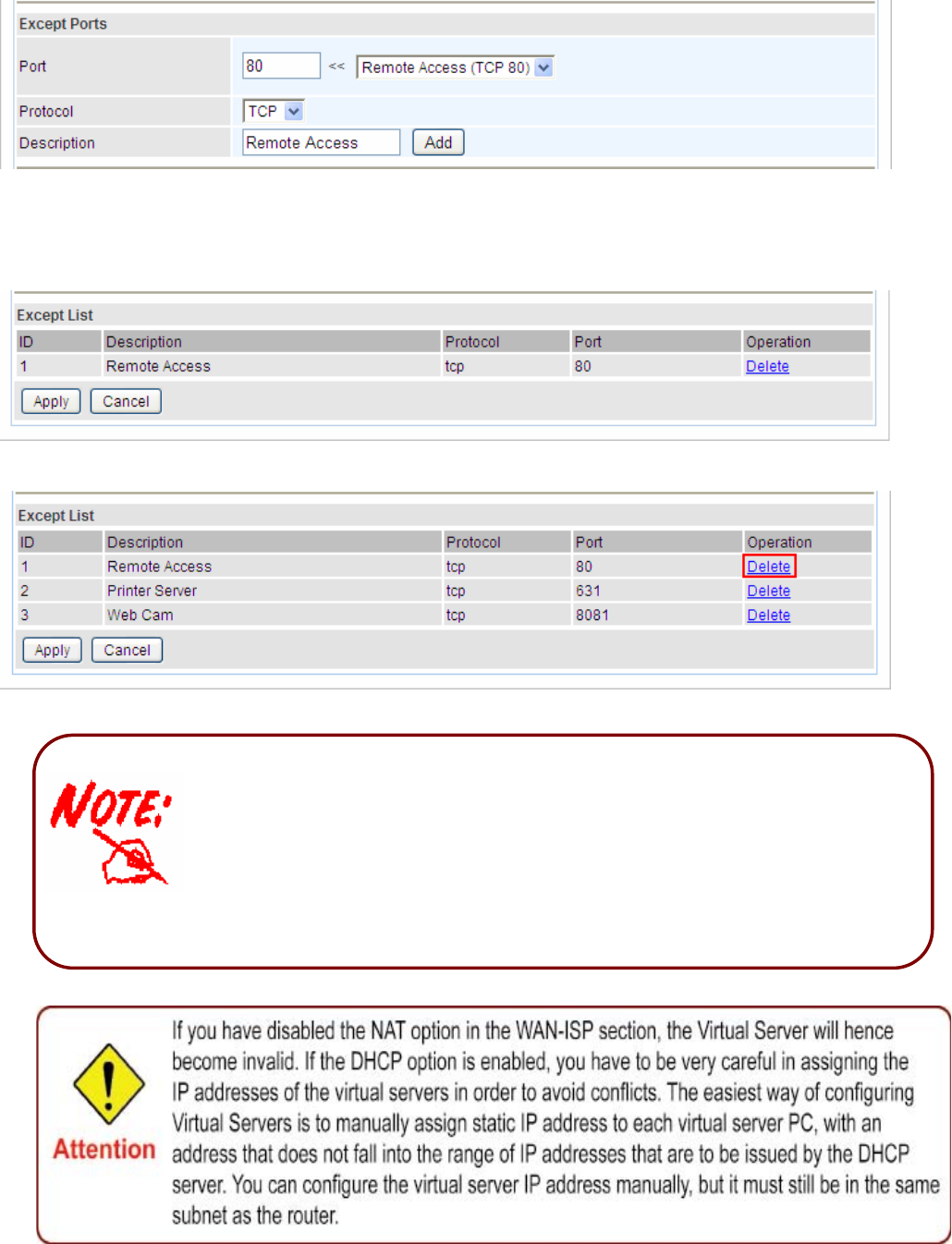
121
2. Click Add. The new except port will display below.
3. Click Delete to delete the one which you want to remove from the except list.
Using port mapping does have security implications, since outside
users are able to connect to PCs on your network. For this reason you
are advised to use specific Virtual Server entries just for the ports your
application requires instead of simply using DMZ or creating a Virtual
Server entry for “All” protocols, as doing so results in all connection
attempts to your public IP address accessing the specified PC.

122
Wake on LAN
Wake on LAN (WOL, sometimes WoL) is an Ethernet computer networking standard that allows a
computer to be turned on or woken up remotely by a network message.
Select: Select MAC address of the computer that you want to wake up or turn on remotely.
Add: After selecting, click Add then you can perform the Wake-up action.
Edit/Delete: Click to edit or delete the selected MAC address.
Ready: “Yes“ indicating the remote computer is ready for your waking up.
“No“ indicating the machine is not ready for your waking up.
Delete: Delete the selected MAC address.
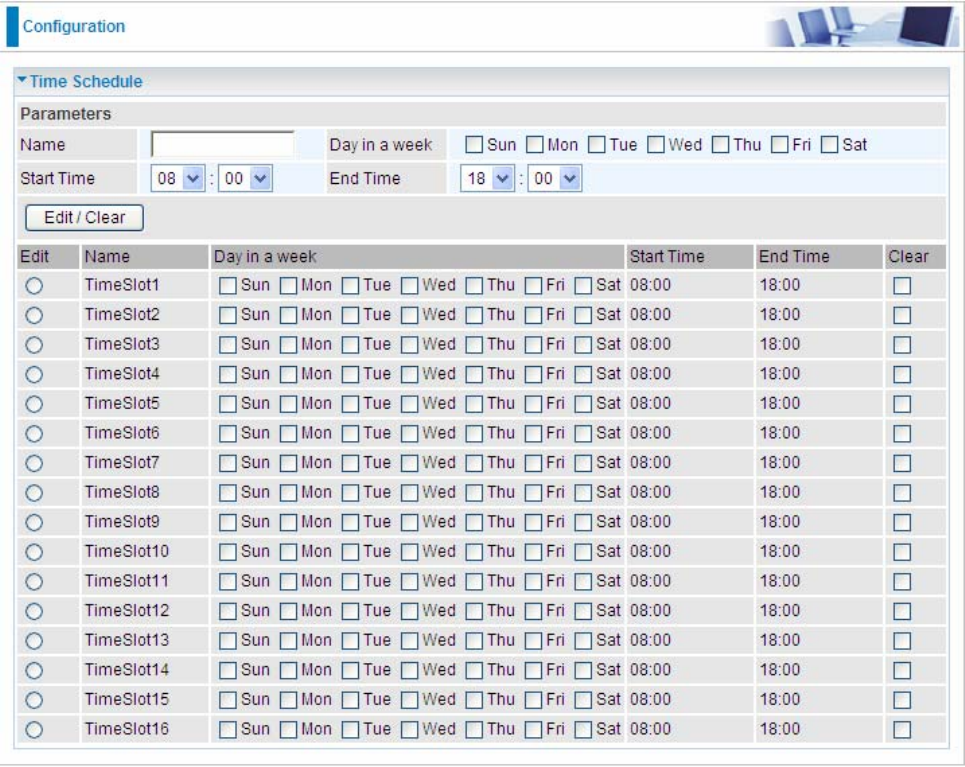
123
Time Schedule
The Time Schedule supports up to 16 time slots which helps you to manage your Internet connection.
In each time profile, you may schedule specific day(s) i.e. Monday through Sunday to restrict or
allowing the usage of the Internet by users or applications.
This Time Schedule correlates closely with router’s time, since router does not have a real time clock
on board; it uses the Simple Network Time Protocol (SNTP) to get the current time from an SNTP
server from the Internet. Refer to Time Zone for details. You router time should correspond with your
local time. If the time is not set correctly, your Time Schedule will not function properly.
Name: A user-define description to identify this time portfolio.
Day in a week: The default is set from Sunday through Saturday. You may specify the days for the
schedule to be applied.
Start Time: The default is set at 8:00 AM. You may specify the start time of the schedule.
End Time: The default is set at 18:00 (6:00PM). You may specify the end time of the schedule. Select
the Apply button to apply your changes.
124
Advanced
Configuration options within the Advanced section are for users who wish to take advantage of the
more advanced features of the router. Users who do not understand the features should not attempt to
reconfigure their router, unless advised to do so by support staff.
There are seven items within the Advanced section: Static Route, Static ARP, Dynamic DNS,
Device Management, IGMP, SNMP Access Control and Remote Access.
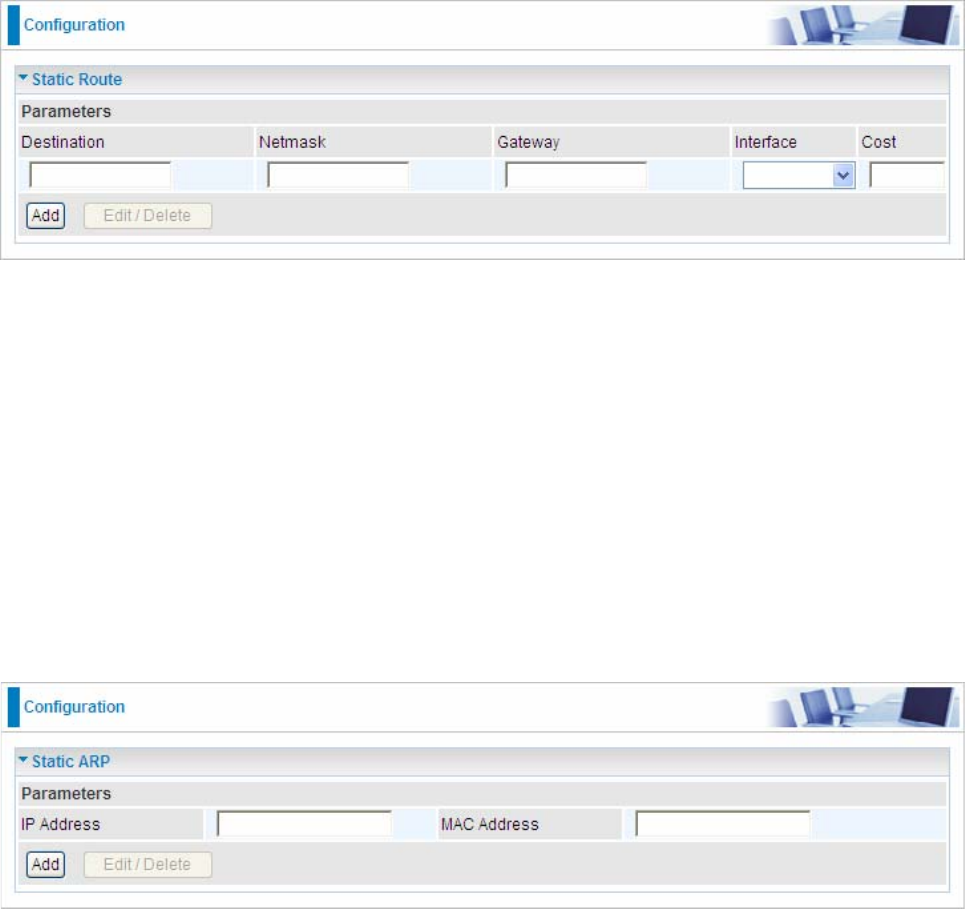
125
Static Route
Destination: The destination subnet IP address.
Netmask: Subnet mask of the destination IP addresses based on above destination.
Gateway: The gateway IP address to which packets are forwarded.
Interface: Select the interface through which packets are forwarded.
Cost: Represents the cost of transmission for routing purposes. The number need not be precise, but
it must be between 0 and 65535.
Static ARP
IP Address: Fill in the IP address of the host computer that is sending the data packet.
MAC Address: Fill in the MAC address of the computer that the incoming data packets are to be
forwarded.
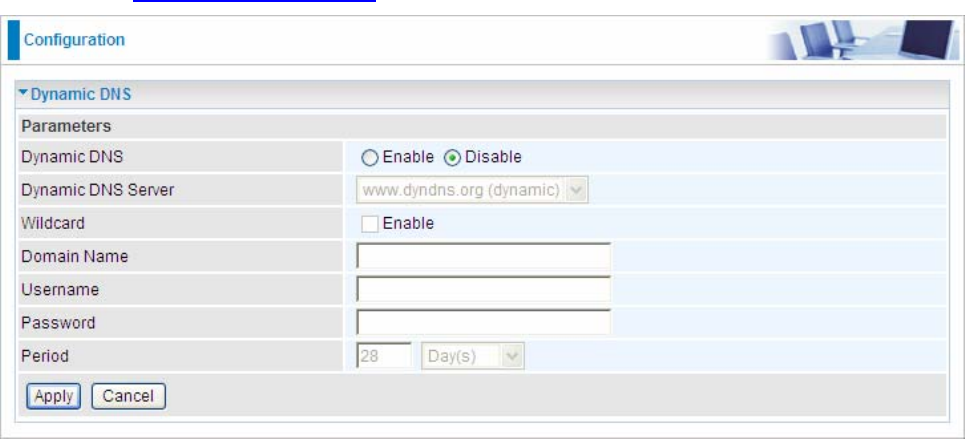
126
Dynamic DNS
The Dynamic DNS function lets you alias a dynamic IP address to a static hostname, so if your ISP
does not assign you a static IP address you can still use a domain name. This is especially useful for
hosting servers via your 3G connection, so that anyone wishing to connect to you may use your
domain name, rather than having to use your dynamic IP address, which changes from time to time.
This dynamic IP address is the WAN IP address of the router, which is assigned to you by your ISP.
You first need to register and establish an account with the Dynamic DNS provider using their website,
for example http://www.dyndns.org/.
Disable: Check to disable the Dynamic DNS function.
Enable: Check to enable the Dynamic DNS function. The fields following are activated and required.
Dynamic DNS Server: Select the DDNS service you have established an account with.
Wildcard: Select this check box to enable the DYNDNS Wildcard.
Domain Name, Username and Password: Enter your registered domain name and your username
and password for this service.
Period: Set the time period between updates, for the Router to exchange information with the DDNS
server. In addition to updating periodically as per your settings, the router will perform an update when
your dynamic IP address changes.
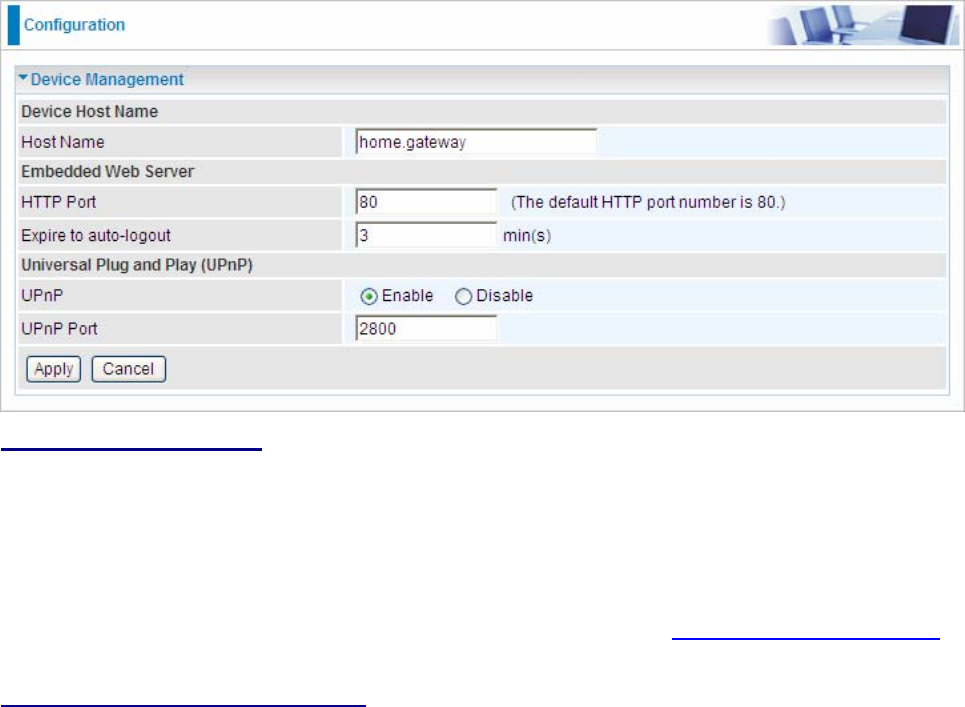
127
Device Management
The Device Management advanced configuration settings allow you to control your router’s security
options and device monitoring features.
Embedded Web Server
HTTP Port: The port number of the router’s embedded web server (for web-based configuration uses.
The default value is the standard HTTP port, 80. You may specify an alternative if, for example, you
are running a web server on a PC within your LAN.
For Example: User A changes HTTP port number to 100, specifies their own IP address of
192.168.1.55, and sets the logout time to be 100 minutes. The router only allows User A access from
the IP address 192.168.1.55 to logon to the Web GUI by typing: http://192.168.1.254:100 in their web
browser. After 100 minutes, the device automatically logs out User A.
Universal Plug and Play (UPnP)
UPnP offers peer-to-peer network connectivity for PCs and other network devices, along with control
and data transfer between devices. UPnP offers many advantages for users running NAT routers
through UPnP NAT Traversal, and on supported systems makes tasks such as port forwarding much
easier by letting the application control the required settings, removing the need for the user to control
advanced configuration of their device.
Both the user’s Operating System and the relevant application must support UPnP in addition to the
router. Windows XP and Windows Me natively support UPnP (when the component is installed), and
Windows 98 users may install the Internet Connection Sharing client from Windows XP in order to
support UPnP. Windows 2000 does not support UPnP.
Disable: Check to disable the router’s UPnP functionality.
Enable: Check to enable the router’s UPnP functionality.
UPnP Port: The Default setting is 2800. It is highly recommended you use this port value.
If this value conflicts with other ports already in use you may wish to change the port.
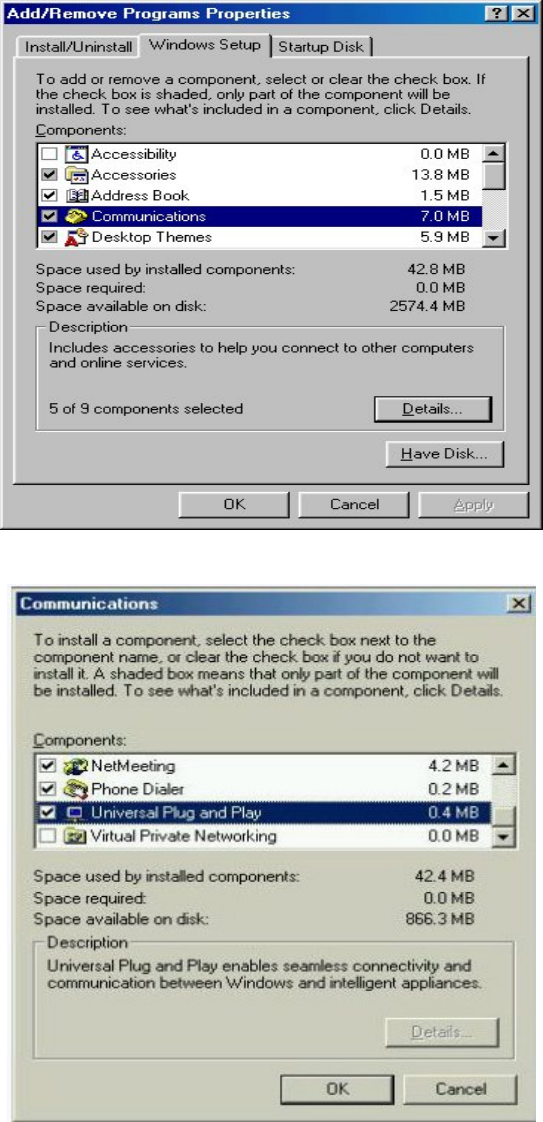
128
Installing UPnP in Windows Example
Follow the steps below to install the UPnP in Windows Me.
Step 1: Click Start and Control Panel. Double-click Add/Remove Programs.
Step 2: Click on the Windows Setup tab and select Communication in the Components selection box.
Click Details.
Step 3: In the Communications window, select the Universal Plug and Play check box in the
Components selection box.
Step 4: Click OK to go back to the Add/Remove Programs Properties window. Click Next.
Step 5: Restart the computer when prompted.
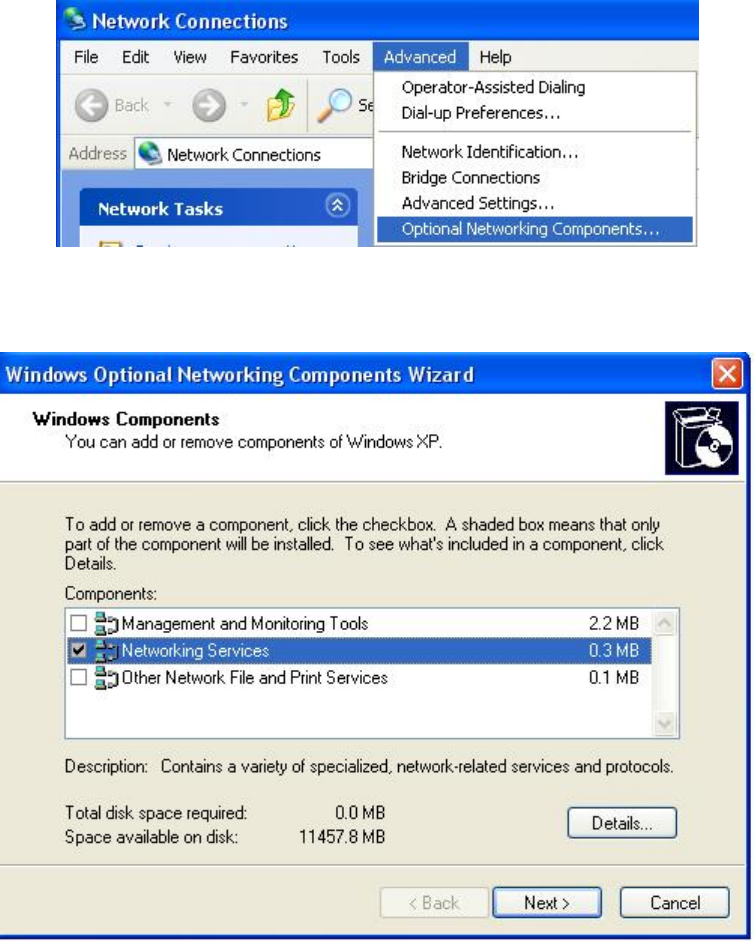
129
Follow the steps below to install the UPnP in Windows XP.
Step 1: Click Start and Control Panel.
Step 2: Double-click Network Connections.
Step 3: In the Network Connections window, click Advanced in the main menu and select Optional
Networking Components ….
The Windows Optional Networking Components Wizard window displays.
Step 4: Select Networking Service in the Components selection box and click Details.
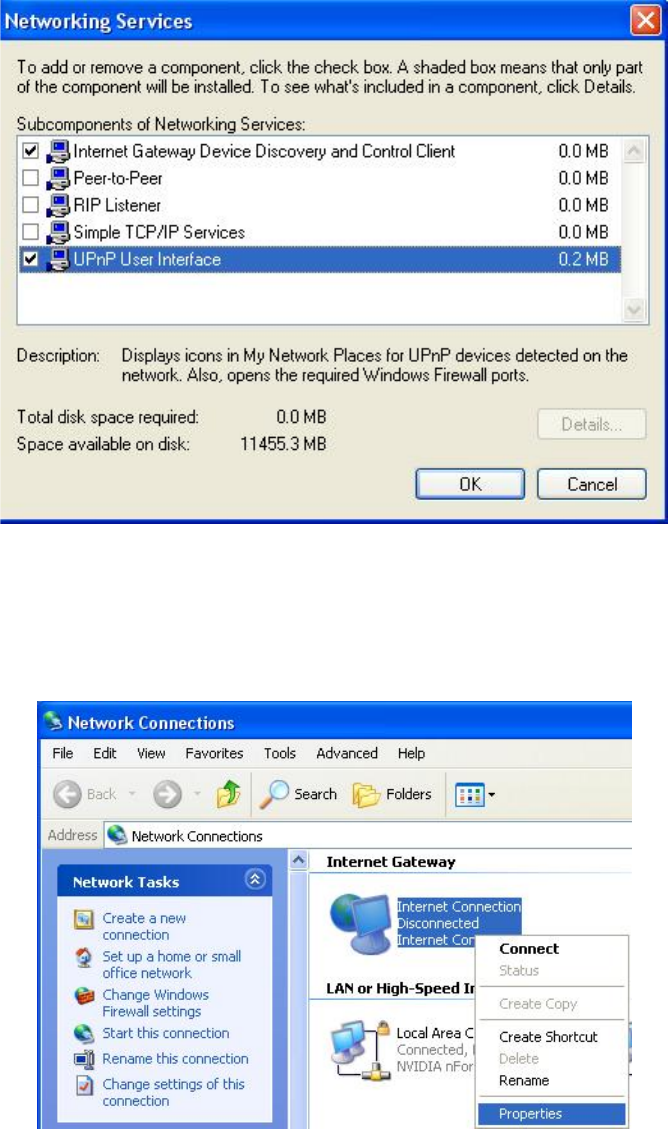
130
Step 5: In the Networking Services window, select the Universal Plug and Play check box.
Step 6: Click OK to go back to the Windows Optional Networking Component Wizard window and
click Next.
Auto-discover Your UPnP-enabled Network Device
Step 1: Click start and Control Panel. Double-click Network Connections. An icon displays under
Internet Gateway.
Step 2: Right-click the icon and select Properties.
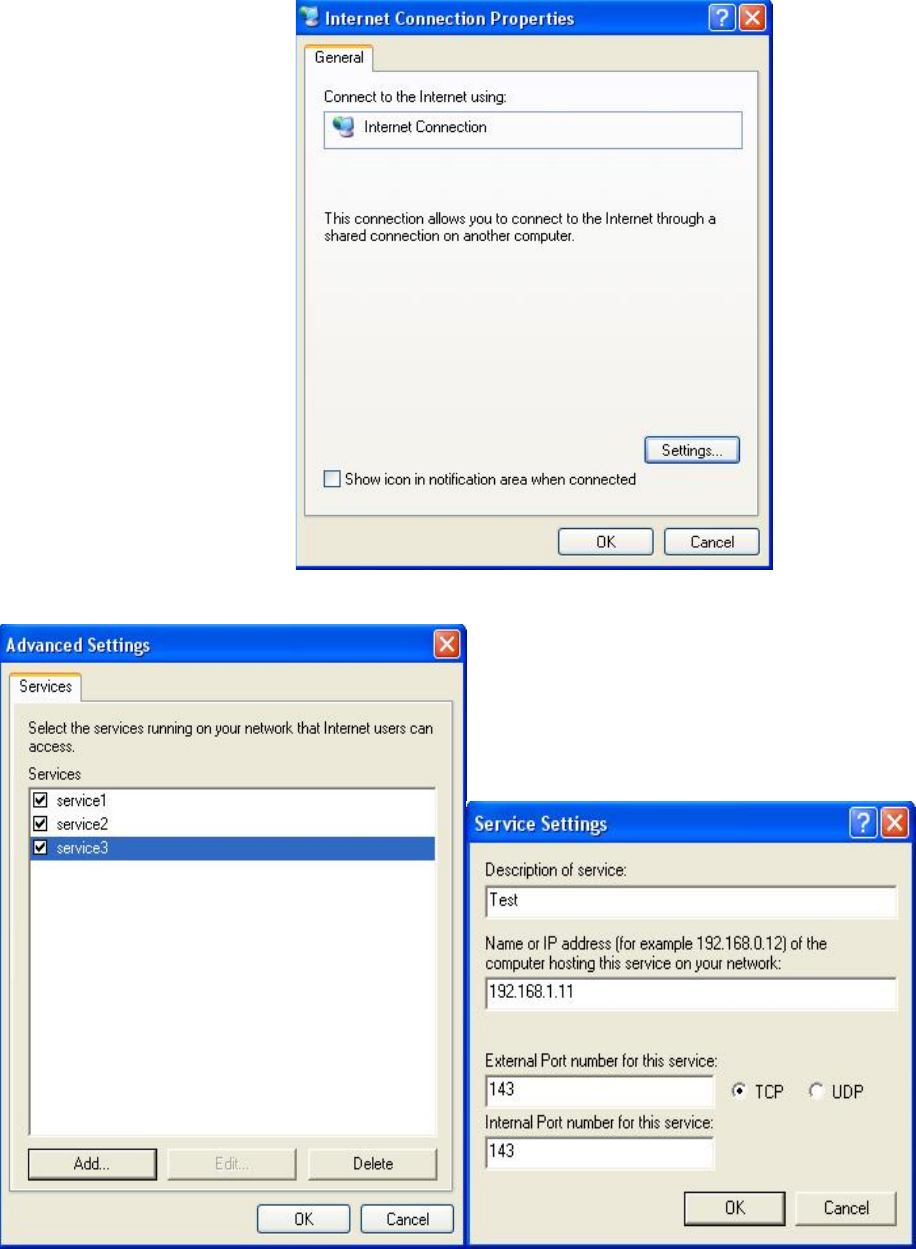
131
Step 3: In the Internet Connection Properties window, click Settings to see the port mappings that
were automatically created.
Step 4: You may edit or delete the port mappings or click Add to manually add port mappings.
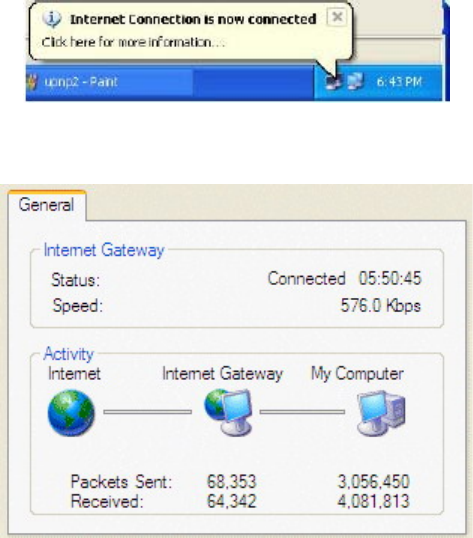
132
Step 5: Select Show icon in notification area when connected option and click OK. An icon displays in
the system tray
Step 6: Double-click on the icon to display your current Internet connection status.
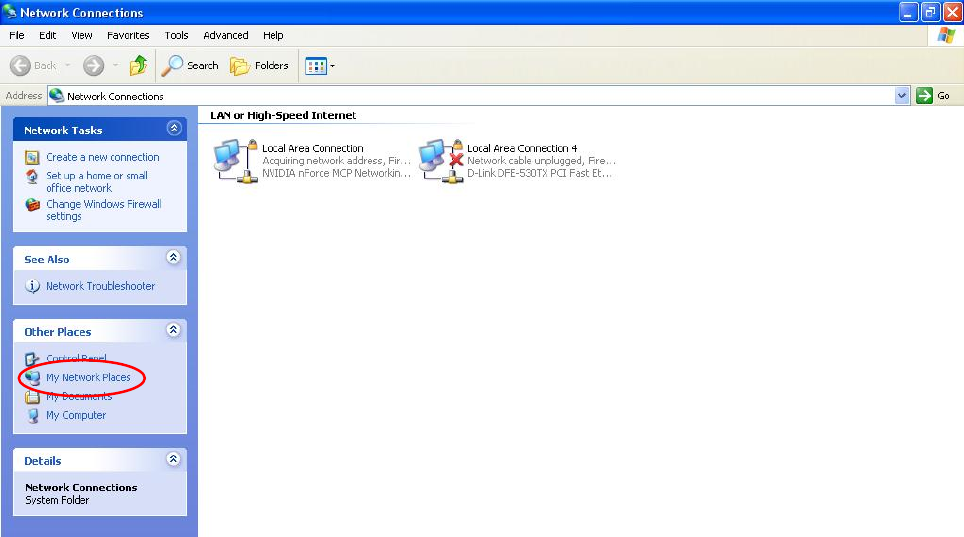
133
Web Configurator Easy Access
With UPnP, you can access web-based configuration for the BiPAC 6200NXL without first finding out
the IP address of the router. This helps if you do not know the router’s IP address.
Follow the steps below to access web configuration.
Step 1: Click Start and then Control Panel.
Step 2: Double-click Network Connections.
Step 3: Select My Network Places under Other Places.
Step 4: An icon describing each UPnP-enabled device shows under Local Network.
Step 5: Right-click on the icon of your BiPAC 6200NXL and select Invoke. The web configuration login
screen displays.
Step 6: Right-click on the icon of your BiPAC 6200NXL and select Properties. A properties window
displays basic information about the BiPAC 6200NXL.

134
IGMP
IGMP, known as Internet Group Management Protocol, is used to management hosts from multicast
group.
IGMP Proxy: Accepting multicast packet. Default is set to Disable.
IGMP Snooping: Allowing switched Ethernet / Wireless to check and make correct forwarding
decisions. Default is set to Disable.
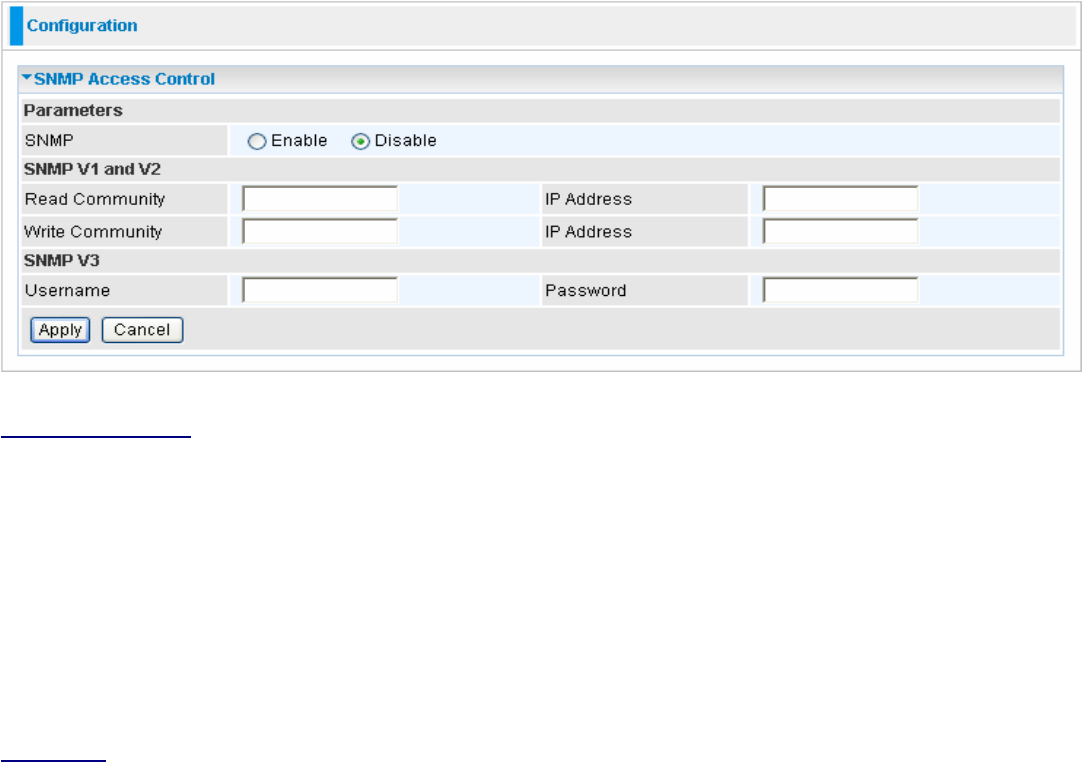
135
SNMP Access Control
Software on a PC within the LAN is required in order to utilize this function - Simple Network
Management Protocol.
SNMP V1 and V2
Read Community: Specify a name to be identified as the Read Community, and an IP address. This
community string will be checked against the string entered in the configuration file. Once the string
name is matched, user obtains this IP address will be able to view the data.
Write Community: Specify a name to be identified as the Write Community, and an IP address. This
community string will be checked against the string entered in the configuration file. Once the string
name is matched, users from this IP address will be able to view and modify the data.
Trap Community: Specify a name to be identified as the Trap Community, and an IP address. This
community string will be checked against the string entered in the configuration file. Once the string
name is matched, users from this IP address will be sent SNMP Traps.
SNMP V3
Specify a name and password for authentication. And define the access right from identified IP
address. Once the authentication has succeeded, users from this IP address will be able to view and
modify the data.
SNMP Version: SNMPV2c and SNMPv3
SNMPv2c is the combination of the enhanced protocol features of SNMPv2 without the SNMPv2
security. The "c" comes from the fact that SNMPv2c uses the SNMPv1 community string paradigm for
"security", but is widely accepted as the SNMPv2 standard.
SNMPv3 is a strong authentication mechanism, authorization with fine granularity for remote
monitoring.
Traps supported: Cold Start, Authentication Failure.
The following MIBs are supported:
136
From RFC 1213 (MIB-II):
; System group
; Interfaces group
; Address Translation group
; IP group
; ICMP group
; TCP group
; UDP group
: EGP (not applicable)
; Transmission
; SNMP group
From RFC1650 (EtherLike-MIB):
; dot3Stats
From RFC 1493 (Bridge MIB):
; dot1dBase group
; dot1dTp group
; dot1dStp group (if configured as spanning tree)
From RFC 1471 (PPP/LCP MIB):
; pppLink group
: pppLqr group
From RFC 1472 (PPP/Security MIB):
; PPP Security Group)
From RFC 1473 (PPP/IP MIB):
; PPP IP Group
From RFC 1474 (PPP/Bridge MIB):
; PPP Bridge Group
From RFC1573 (IfMIB):
; ifMIBObjects Group
From RFC 1907 (SNMPv2):
only snmpSetSerialNo OID
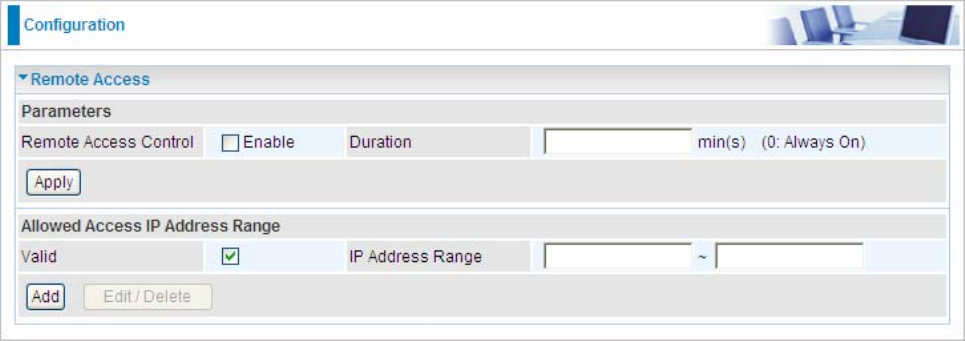
137
Remote Access
Remote Access Control
Enable: Select Enable to allow management access from remote side (mostly from internet).
Duration: Set how many minutes to allow management access from remote side. Zero means always
on.
Allowed Access IP Address Range
Valid: Select Valid to allow remote management from these IP ranges.
IP Address Range: Specify what IP address to be allowed to access device from remote side. Clink
Add to insert management IP address list.

138
Save Configuration to Flash
After changing the router’s configuration settings, you must save all of the configuration parameters to
FLASH to avoid losing them after turning off or resetting your router. Click “Save Config” and click
“Apply” to write your new configuration to FLASH.

139
Restart
Click Restart with option Current Settings to reboot your router (and restore your last saved
configuration).
If you wish to restart the router using the factory default settings (for example, after a firmware upgrade
or if you have saved an incorrect configuration), select Factory Default Settings to reset to factory
default settings.
140
Logout
To exit the router’s web interface, choose Logout. Please ensure that you have saved the
configuration settings before you logout.
Be aware that the router is restricted to only one PC accessing the configuration web pages at a time.
Once a PC has logged into the web interface, other PCs cannot get access until the current PC has
logged out of the web interface. If the previous PC forgets to logout, the second PC can access the
page after a user-defined period, by default 3 minutes. You can modify this value using the Advanced
- Device Management section of the web interface. Please see the Advanced section of this manual
for more information.

141
Chapter 6: Troubleshooting
If your 3G Router is not functioning properly, you can refer first to this chapter for simple
troubleshooting before contacting your service provider support. This can save you time and effort but
if symptoms persist, consult your service provider.
Problems starting up the router
Problem Corrective Action
None of the LEDs
are on when you
turn on the router.
Check the connection between the adapter and the router. If the error
persists, you may have a hardware problem. In this case you should
contact technical support.
Problems with the LAN Interface
Problem Corrective Action
Can’t ping any PCs
on the LAN.
Check the Ethernet LEDs on the front panel. The LED should be on for a
port that has a PC connected. If it is off, check the cables between your
router and the PC. Make sure you have uninstalled any software firewall for
troubleshooting.
Verify that the IP address and the subnet mask are consistent between the
router and the workstations.
Problems with the FTP Server
Problem Corrective Action
FTP client which
behind firewall
remote access the
router fail
Because the firewall has NAT function, this make can’t access the router
successful. There are two suggestions to solve the problem.
1. Set the FTP port as 21, you can access the router successful
2. Use FTP client software (such as flashfxp V3.6), set the connect
behaviour to be “active mode” you can also access the router
successful.

142
Problems with the Samba
Problem Corrective Action
Can’t change
account to access
Samba
First, use net use command to see the current network connection. Such
as we find the resource is: \\192.168.1.254\IPC$ then use net use
\\192.168.1.254\IPC$ /del to delete the connection which need password.
Reaccess and you can change the account.
Can’t access the
shared directory
after format the disk
For the samba user, the shared directories are stored in the hard disk.
There is a .smb_config file under the disk’s root directory. If you have
removed this file or format the disk, you must reset the shared directory.
Problems with the Printer
Problem Corrective Action
Can’t access the
printer
Make sure you have added printer correctly, please reference Set up of
Printer client.
The printer can’t
print though the
printer have been
added correctly
The router can support Ink-jet Printer well. For laser printer, because of its
operation ways, maybe can’t normal printing.
Problems with the Webcam
Problem Corrective Action
Can’t see the image 1. Make sure you have enabled the Enable Webcam Server From WAN
function. If this function is disabled, the image only can be seen from
LAN.
2. Make sure you have install JAVA in your computer and in your browser
Internet options, please enable use JRE.

143
Appendix: Product Support & Contact
If you come across any problems please contact the dealer from where you purchased your product.
Contact Billion
Worldwide:
http://www.billion.com
FCC STATEMENT
1. This device complies with Part 15 of the FCC Rules. Operation is subject to the following two
conditions:
(1) This device may not cause harmful interference.
(2) This device must accept any interference received, including interference that may cause
undesired operation.
2. Changes or modifications not expressly approved by the party responsible for compliance could
void the user's authority to operate the equipment.
NOTE: This equipment has been tested and found to comply with the limits for a Class B digital device,
pursuant to Part 15 of the FCC Rules. These limits are designed to provide reasonable protection
against harmful interference in a residential installation.
This equipment generates uses and can radiate radio frequency energy and, if not installed and used
in accordance with the instructions, may cause harmful interference to radio communications.
However, there is no guarantee that interference will not occur in a particular installation. If this
equipment does cause harmful interference to radio or television reception, which can be determined
by turning the equipment off and on, the user is encouraged to try to correct the interference by one or
more of the following measures:
Reorient or relocate the receiving antenna.
Increase the separation between the equipment and receiver.
Connect the equipment into an outlet on a circuit different from that to which the receiver is
connected.
Consult the dealer or an experienced r adio/TV technician for help.
FCC Radiation Exposure Statement
This equipment complies with FCC radiation exposure limits set forth for an uncontrolled environment.
This equipment should be installed and operated with minimum distance 20cm between the radiator &
your body
MAC OS is a registered Trademark of Apple Computer, Inc.
Windows 98, Windows NT, Windows 2000, Windows Me, Windows XP and Windows Vista are
registered Trademarks of Microsoft Corporation.